1951 Press Photo Artist Conception Super-Dirigible Aircraft Carrier - nef64688
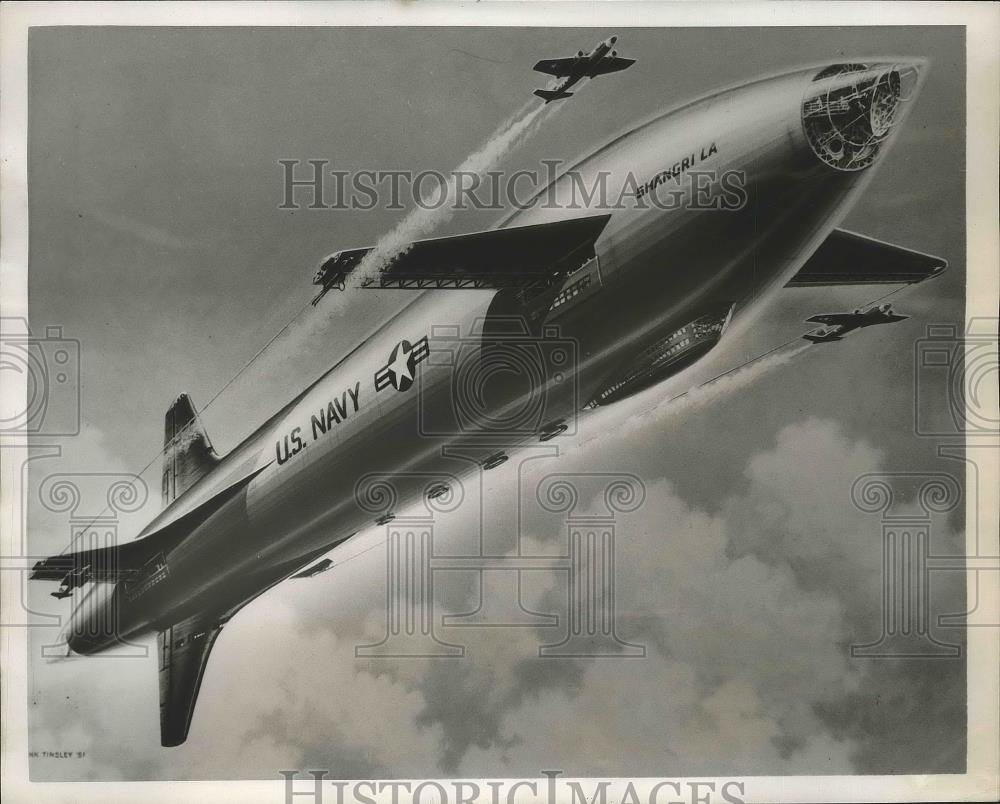
PHOTO BACK
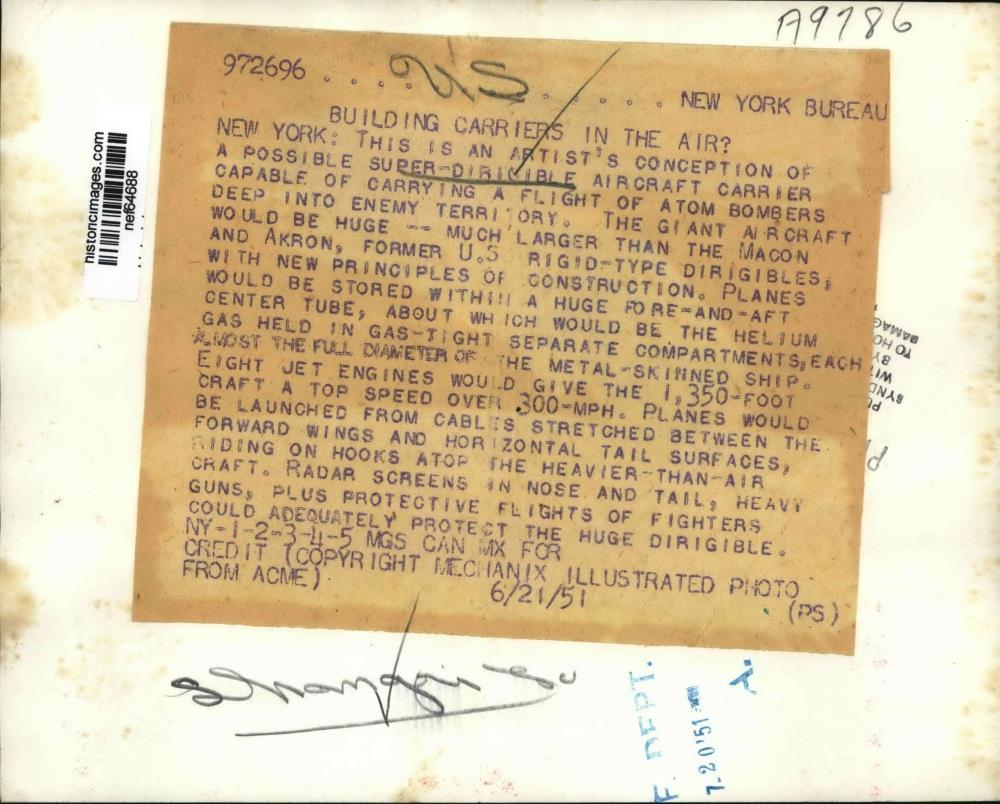
[click an image above to see a larger version]
Historic Images Part Number: nef64688
1956 Press Photo Artist's Conception of an Atom Powered Bomber - nef65544
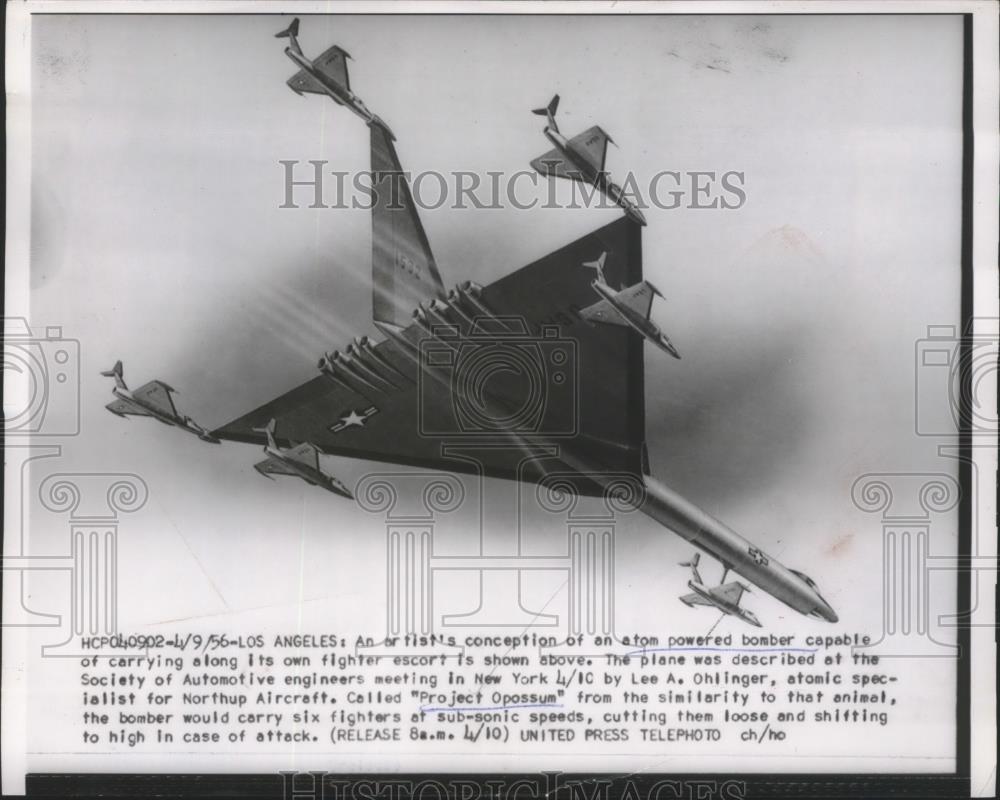
Historic Images Part Number: nef65544
1957 Wire Photo Artist's conception of manned satellite "Meteor Junior" on moon
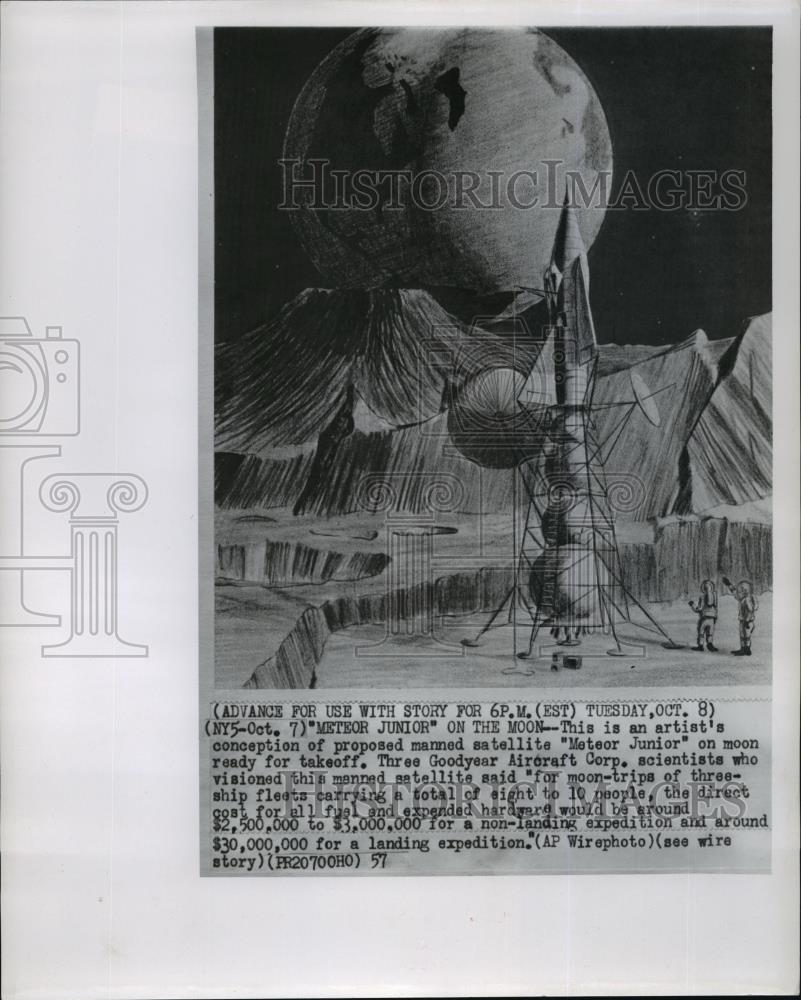
Historic Images Part Number: cvw26965
1957 Press Photo George Kinney NASA research manned satellite model
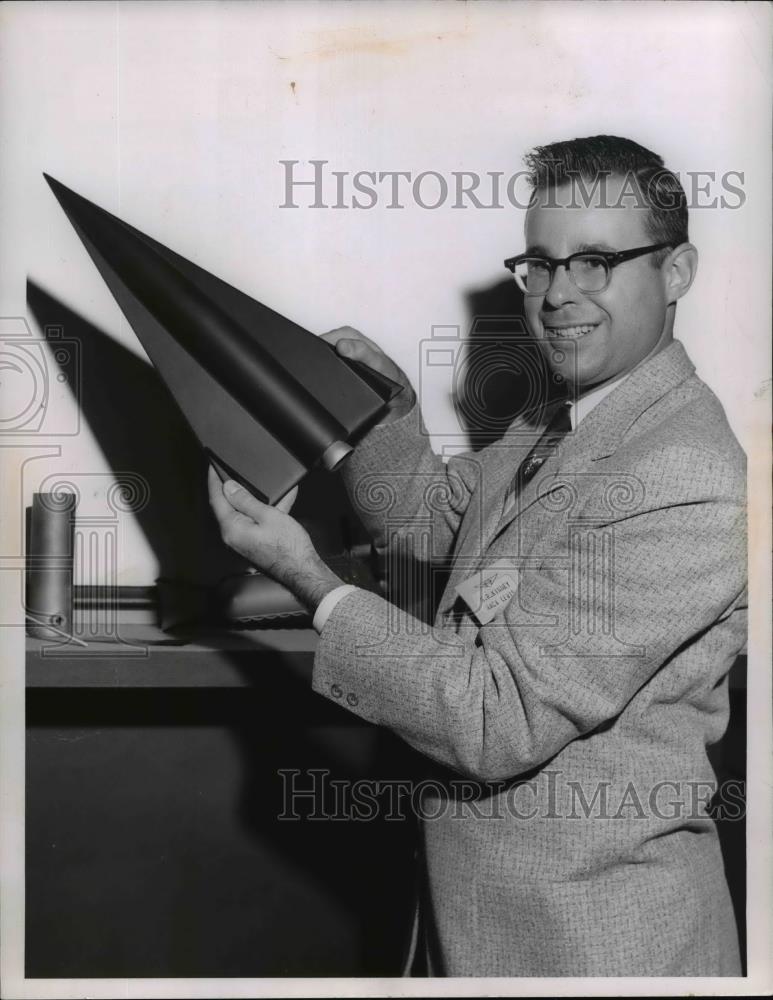
PHOTO BACK
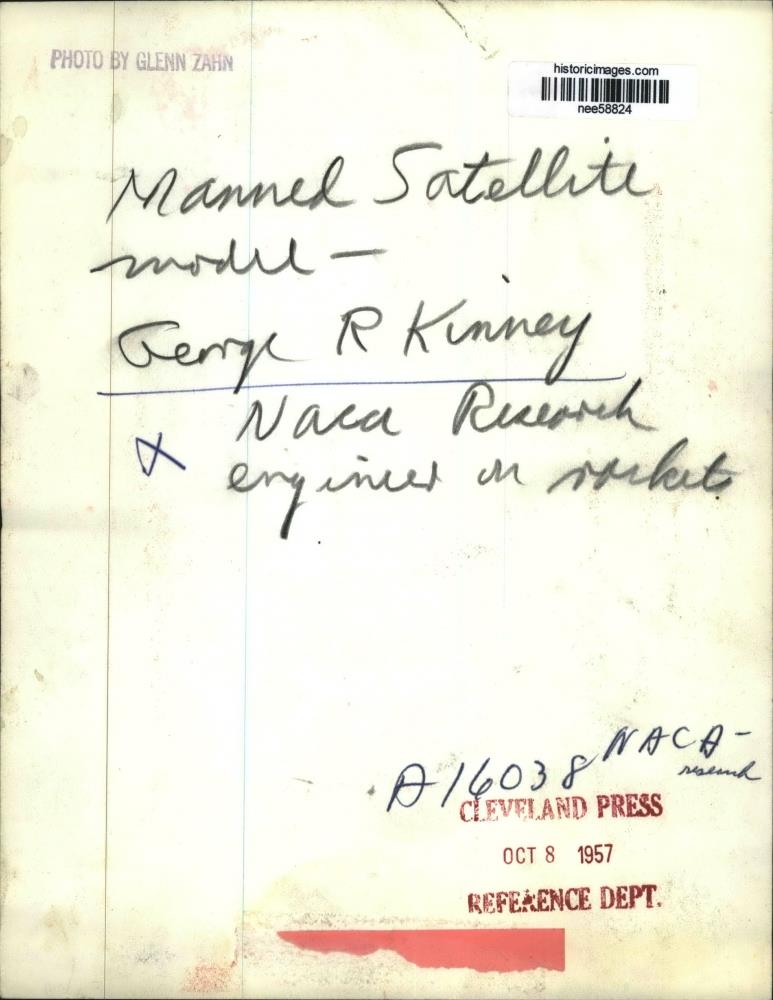
[click an image above to see a larger version]
Historic Images Part Number: nee58824
1957 Wire Photo Sketch of proposed satellite being prepared to orbit earth
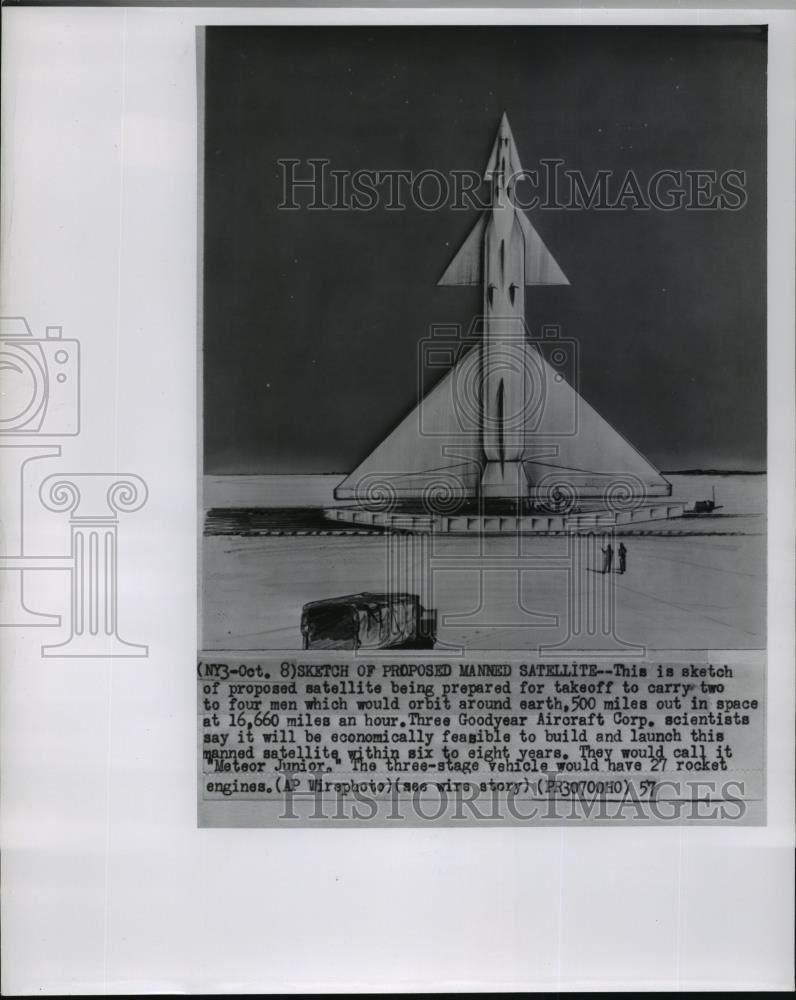
Historic Images Part Number: cvw26964
1957 Press Photo Sketch of proposed satellite to carry 2-4 men to orbit earth
This is a sketch of proposed satellite being prepared for takeoff to carry two to four men which would orbit around earth, 500 miles out in space at 16,660 miles an hour. Three Goodyear Aircraft Corp. scientists say it will be economically feasible to build and launch this manned satellite within six to eight years. They would call it "Meteor Junior". The three-stage vehicle would have 27 rocket engines. Photo is dated 10-08-1957.
Historic Images Part Number: cvw25564
1957 Press Photo Drawing shows space station circling earth. - pix47540
This is an original press photo. Space travel - Sketches - 1110 57 ---- How Space station circling earth might look. ... possible the space station about which such scientists as Dr. Warnher von Braun already have evolved the theory. Circling the earth, it could ....Photo measures 9 x 7inches. Photo is dated 11-10-1957.
PHOTO FRONT

PHOTO BACK
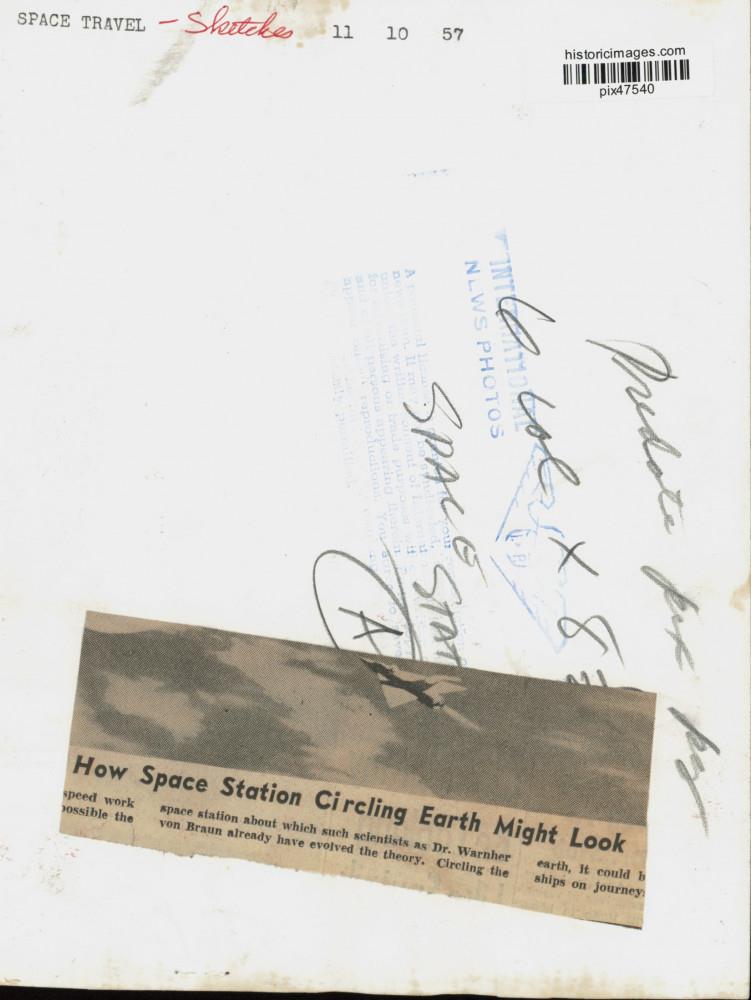
Historic Images Part Number: pix47540
1958 Press Photo Sketch of satellite - pix49137
This is an original press photo. Space travel - sketches - artist's drawing.Photo measures 7.75 x 8.5inches. Photo is dated 12-30-1958.
PHOTO FRONT
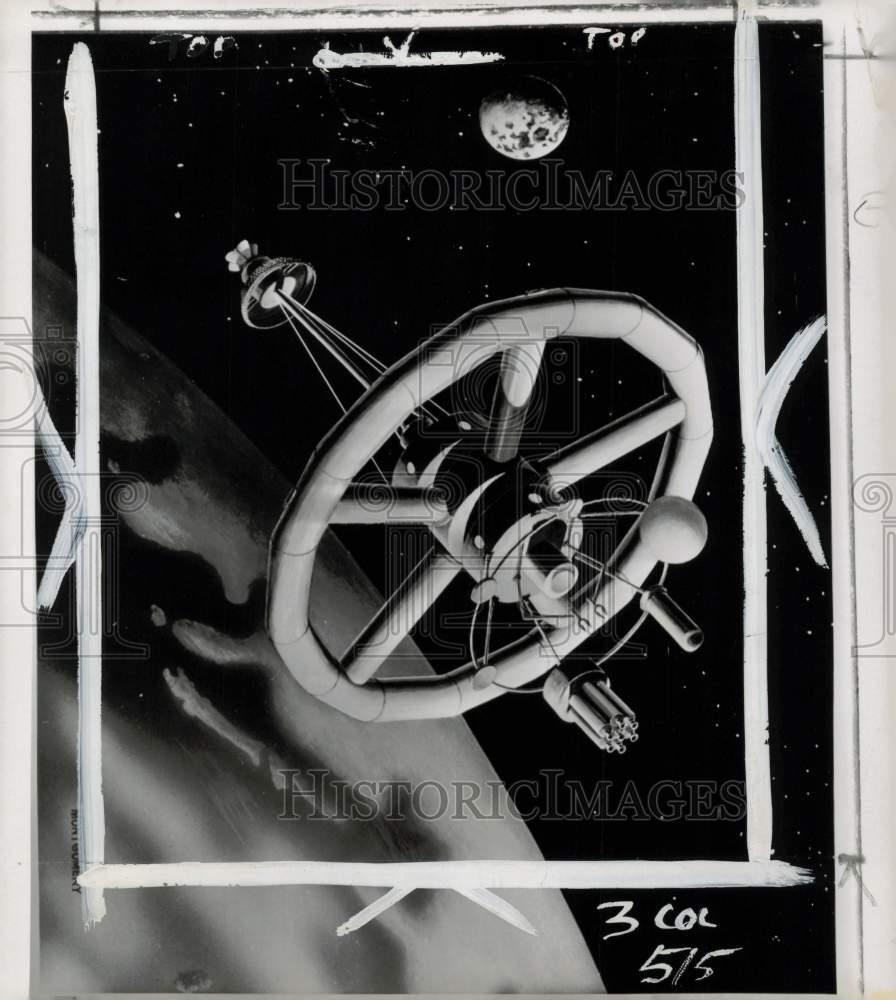
PHOTO BACK
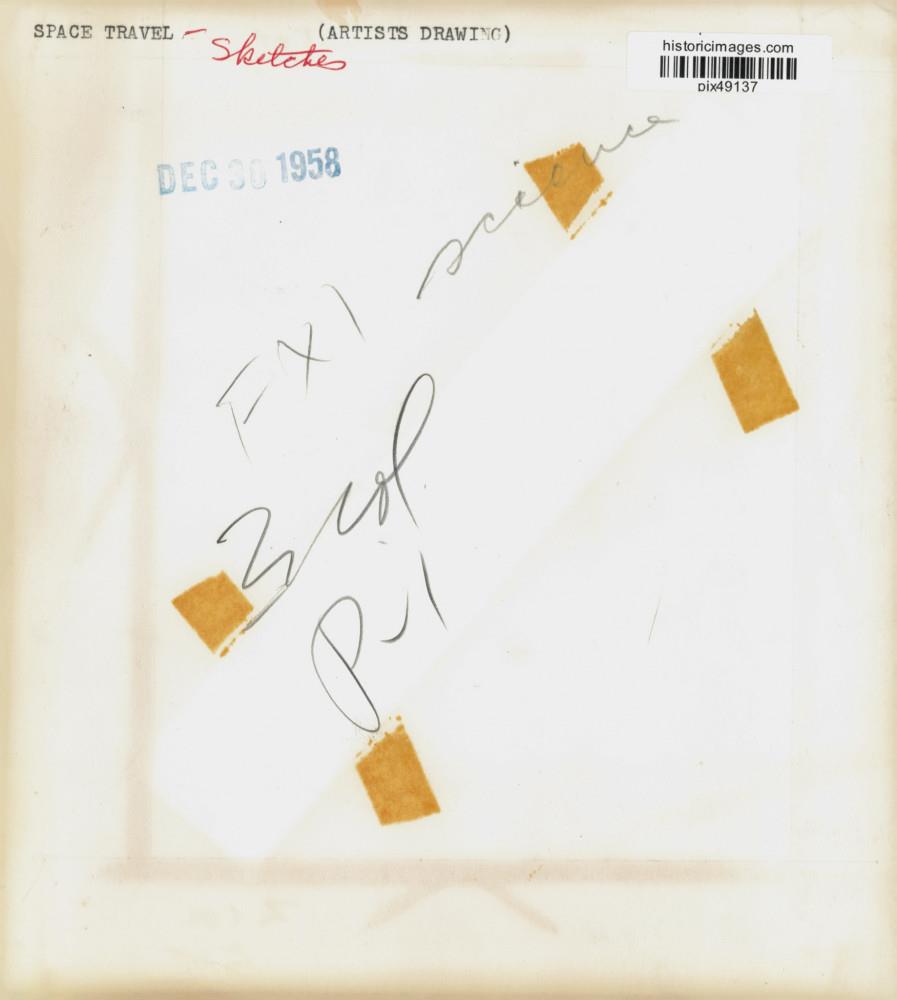
Historic Images Part Number: pix49137
1959 Press Photo Drawing of artist's concept of Martian vehicle - pix48940
This is an original press photo. Space travel. This is the Martian vehicle which will be the subject of the American Rocket Society meeting at 8 PM January 20 in the Health Sciences Auditorium, University of Washington. Artist's conception. Workmen in space suits work on construction of saucer-shaped inter-planetary space vehicle in this artist's conception of project being studies by two Boeing Airplane Company employees. Cone-shaped craft at right ...Photo measures 10 x 8inches. Photo is dated 01--1959.
PHOTO FRONT
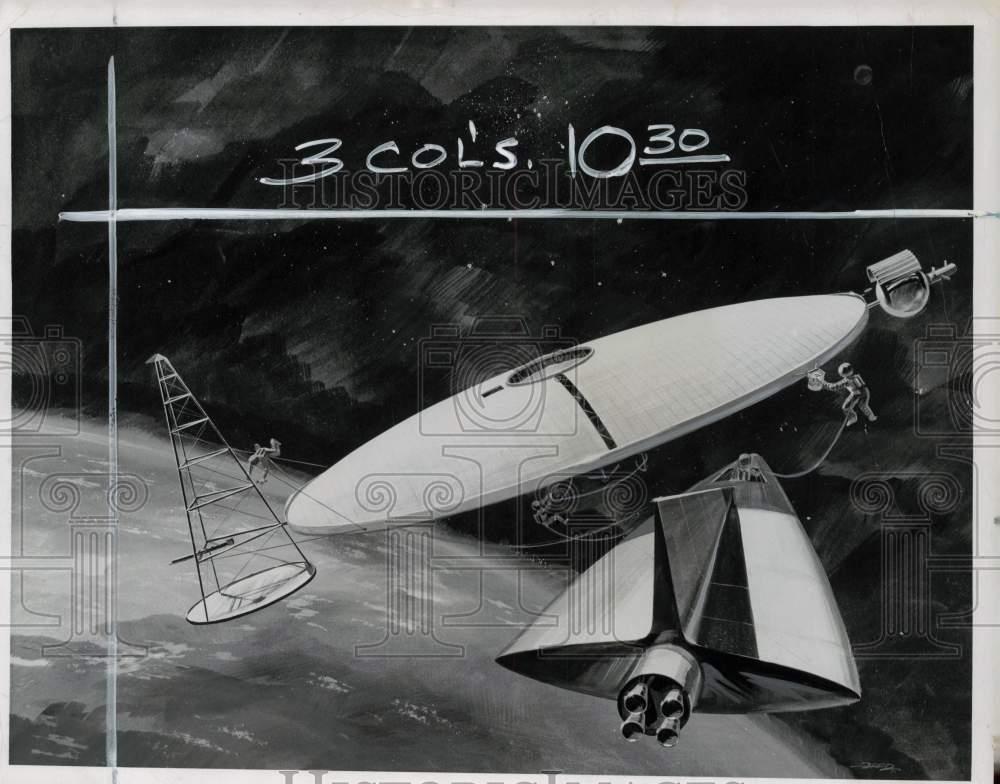
PHOTO BACK
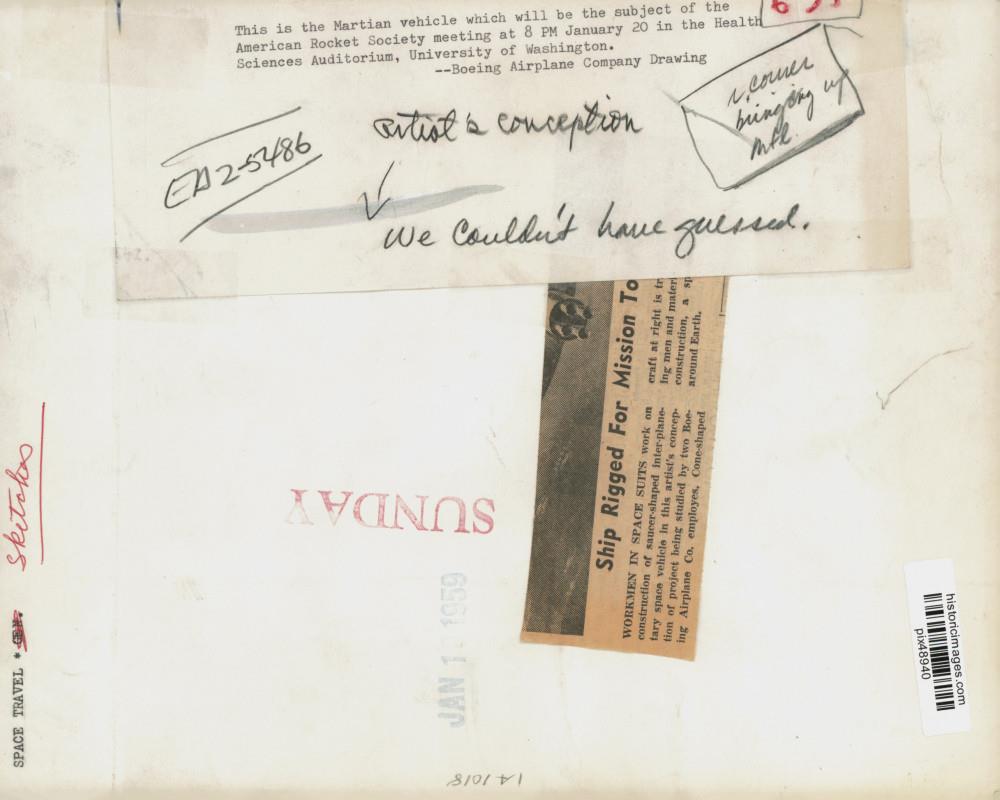
Historic Images Part Number: pix48940
Press Photo Drawing of astronauts leaping on moon's surface - pix48821
This is an original press photo. Space travel. One of a possible future group of United States astronauts is depicted taking giant leaps across the surface of the moon in this artist's illustration by the Martin Company of Baltimore. The company holds a contract with the NASA to study a complete earth-moon transport system.The ten-foot leap is facilitated by the fact that gravity on the moon is believed to be one sixth that of the earth.Photo measures 8.75 x 8.25inches. Photo is dated --NONE.
PHOTO FRONT
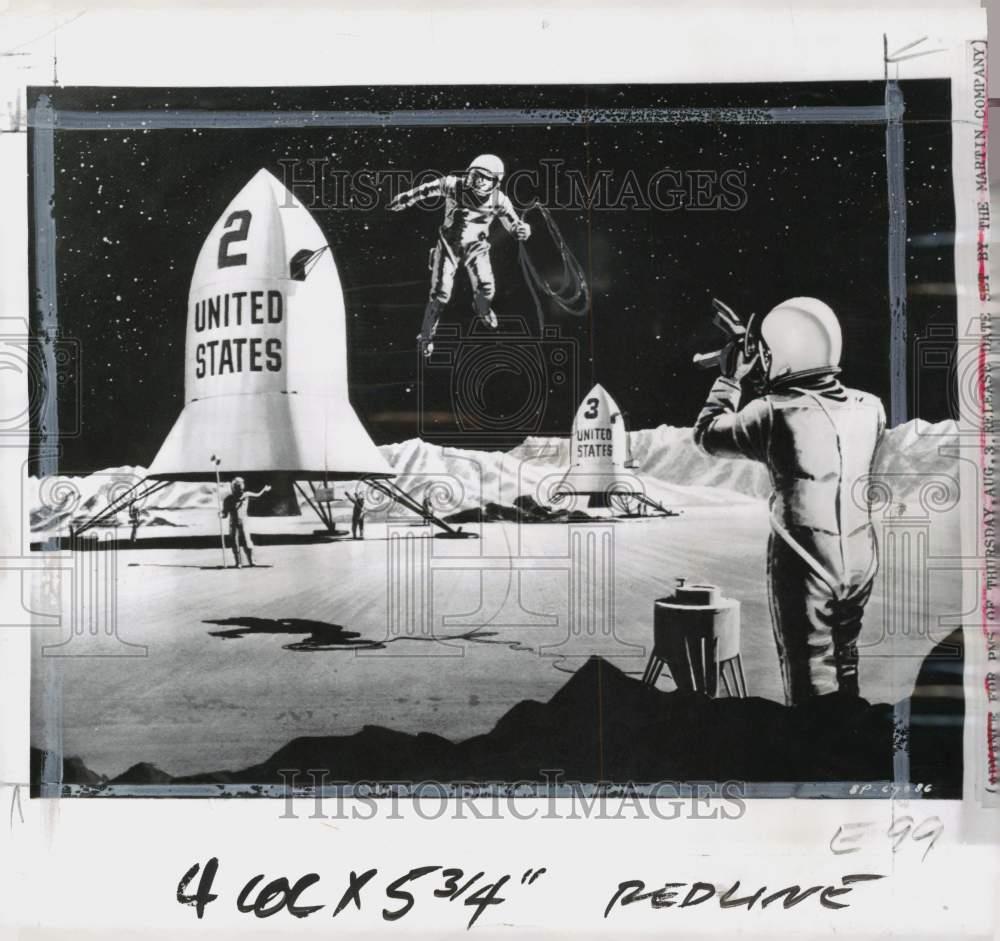
PHOTO BACK
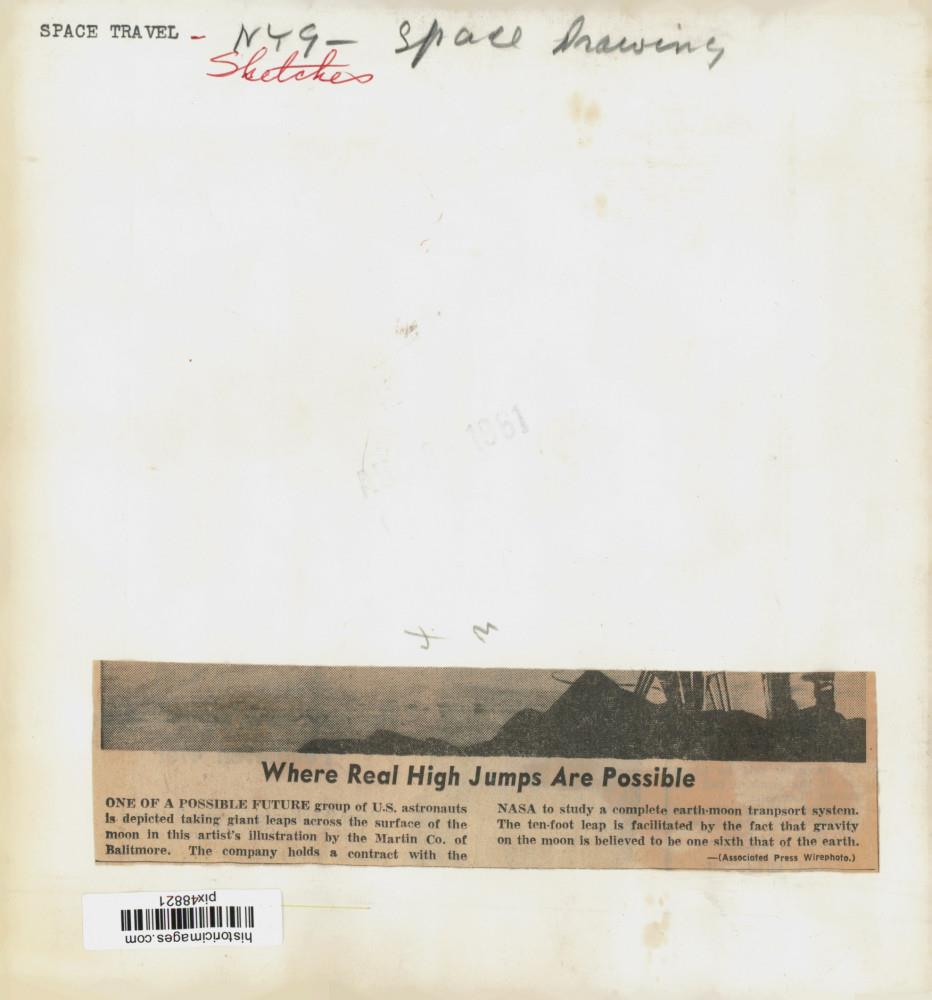
Historic Images Part Number: pix48821
Press Photo Drawing of moon vehicle and spacesuit - pix48023
This is an original press photo. Space travel. An artist's conception of a "moonmobile" and a special, weird spacesuit that could "integrated" with the vehicle. Engineers told the American Association for the Advancement of Science today of blueprints for such vehicles and suits.Photo measures 7.75 x 9.75inches. Photo is dated 12-29-NONE.
PHOTO FRONT
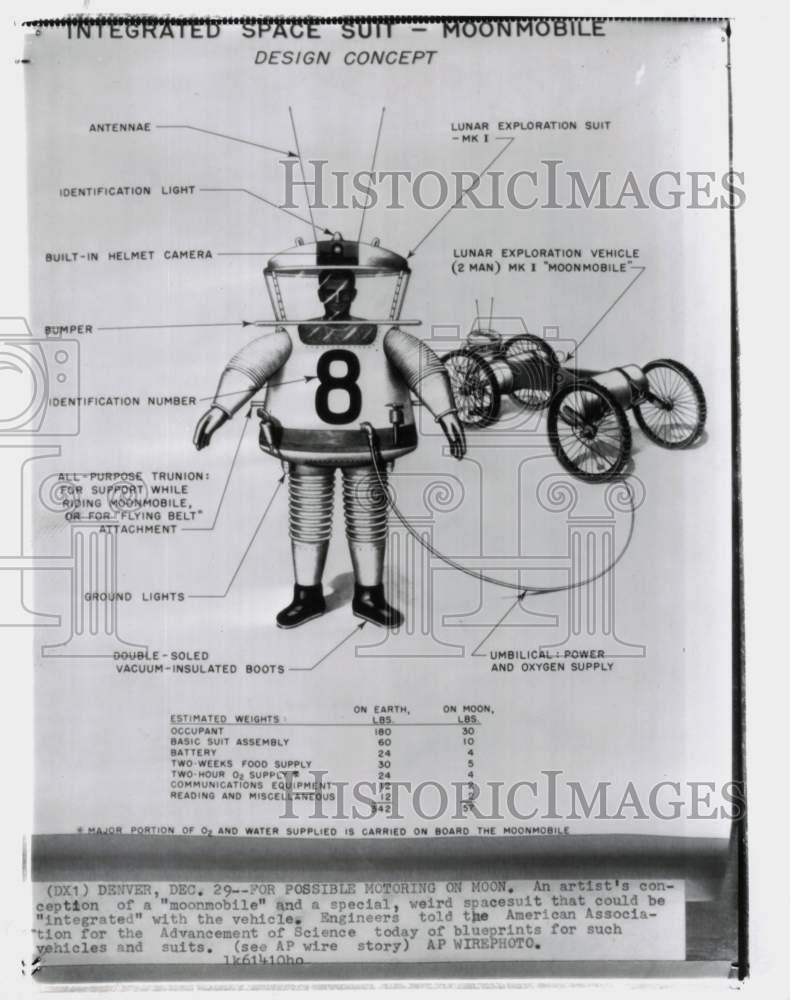
PHOTO BACK
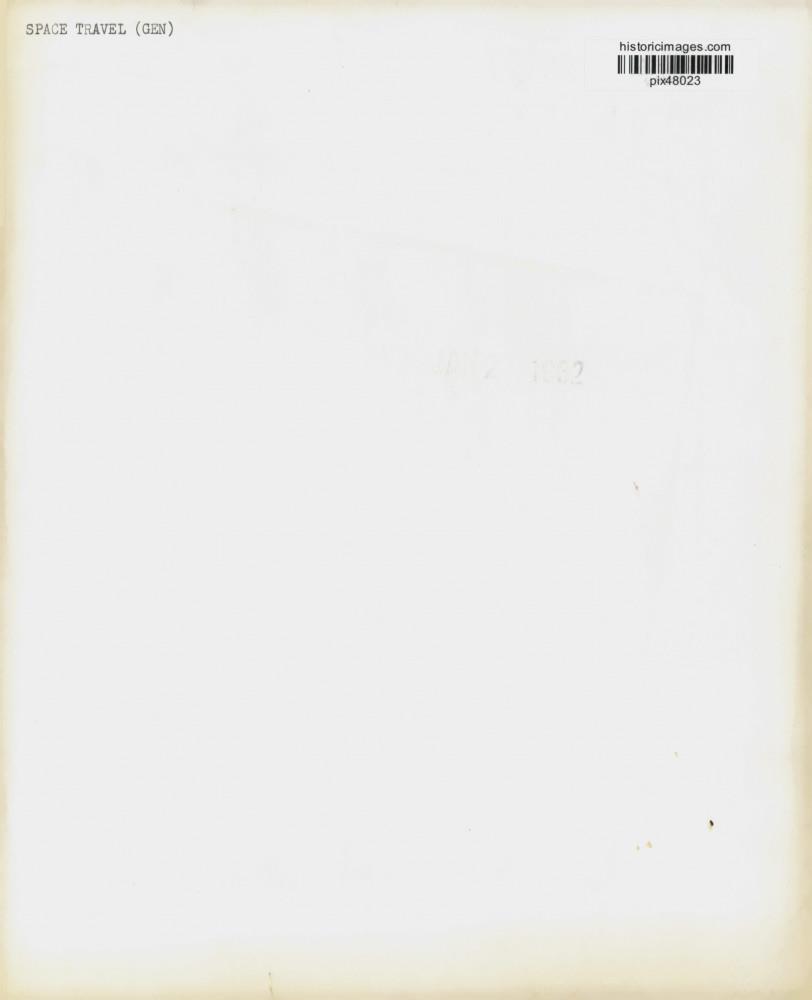
Historic Images Part Number: pix48023
1960 Press Photo Artist's concept of escape from a base on planet Mars
This is an original press photo. Space travel - Boeing vehicle - SX: Mars vehicle - Fig. 12 Mars Landing ---- Artist's concept -- Glider's aft end is used as launch platform for escaping Martian basePhoto measures 10 x 8.25inches. Photo is dated 05-11-1960.
PHOTO FRONT
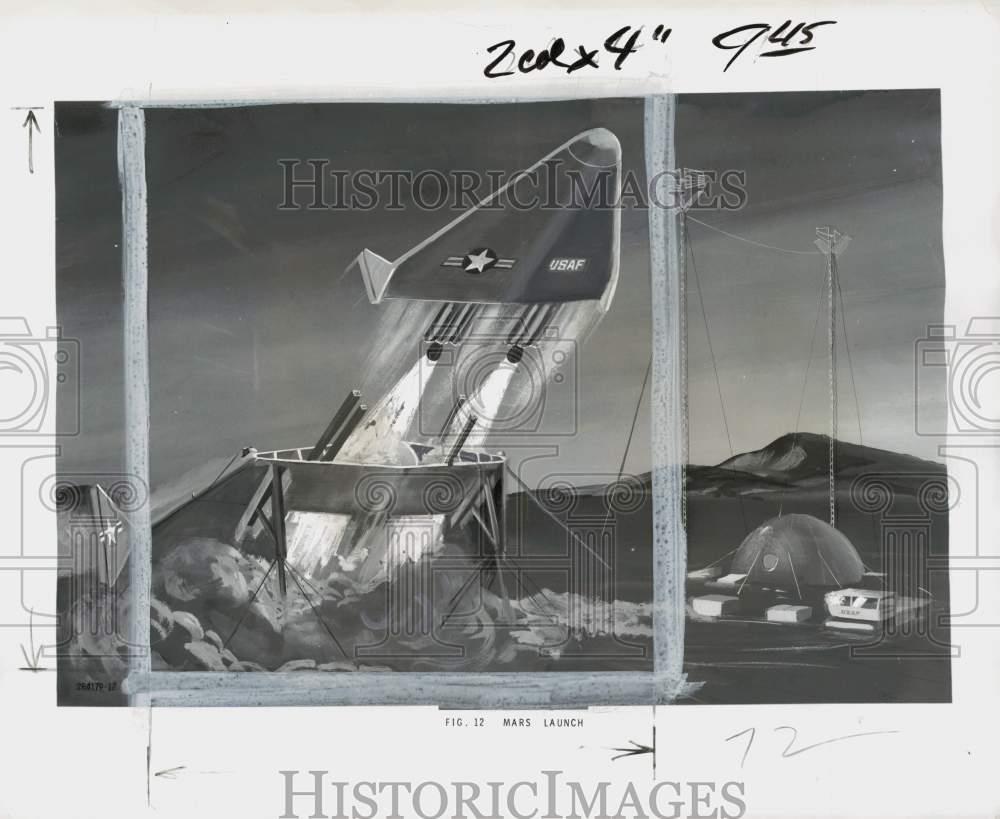
PHOTO BACK
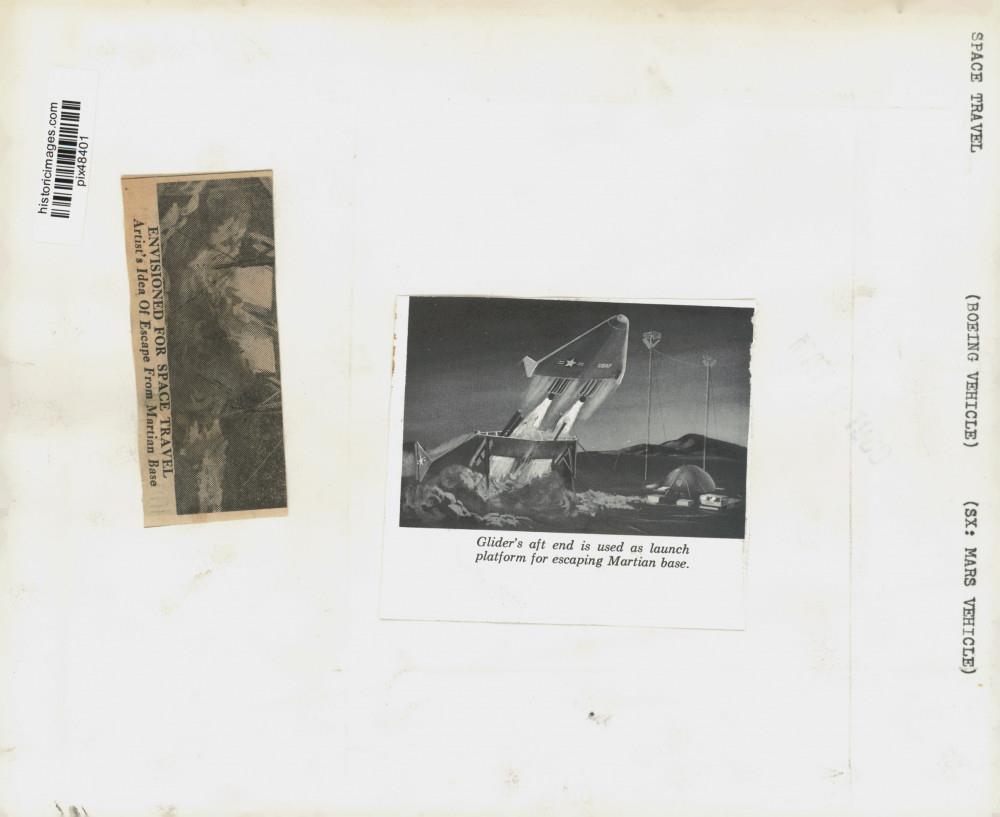
Historic Images Part Number: pix48401
1960 Press Photo Drawing of a cosmonaut in space from "Journey Into The Cosmos"
This drawing was taken from "Journey Into The Cosmos" published in Moscow in 1955, and was captioned as showing how the first manned artificial earth satellite might look. Today Tass, the official Russian news agency, said the Soviets have put a 4 1/2 ton space ship into orbit around the earth with a "dummy spaceman" aboard. This drawing was described as showing jet motor, 1, parachute for braking descent, 2, movable wings 3, sealed pilot's cabin, 4, fuel tanks, 5, and oxidizer, 6, for operation of jet engine to increase speed and for landing. Drawing of a cosmonaut in space from "Journey Into The Cosmos". Space-Gen. Photo is dated 5-15-1960.
1960 Wire Photo Journey Into The Cosmos, published in Moscow in 1955
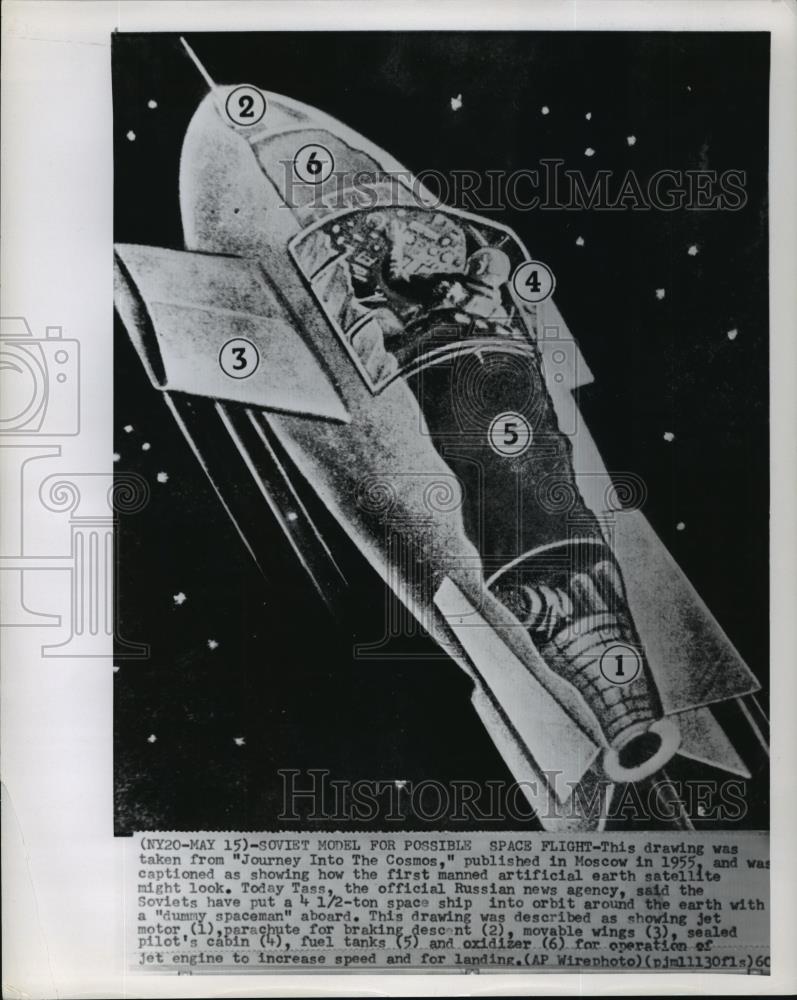
Historic Images Part Number: cvw26895
1960 Press Photo Drawing Of What A "Moon Laboratory" On Earth Might Look Like
Artist's Idea of How a 'Moon Laboratory' on Earth Might Look Through Cutaway. Photo measures 9 x 7.25 inches. Photo is dated 07-22-1960.
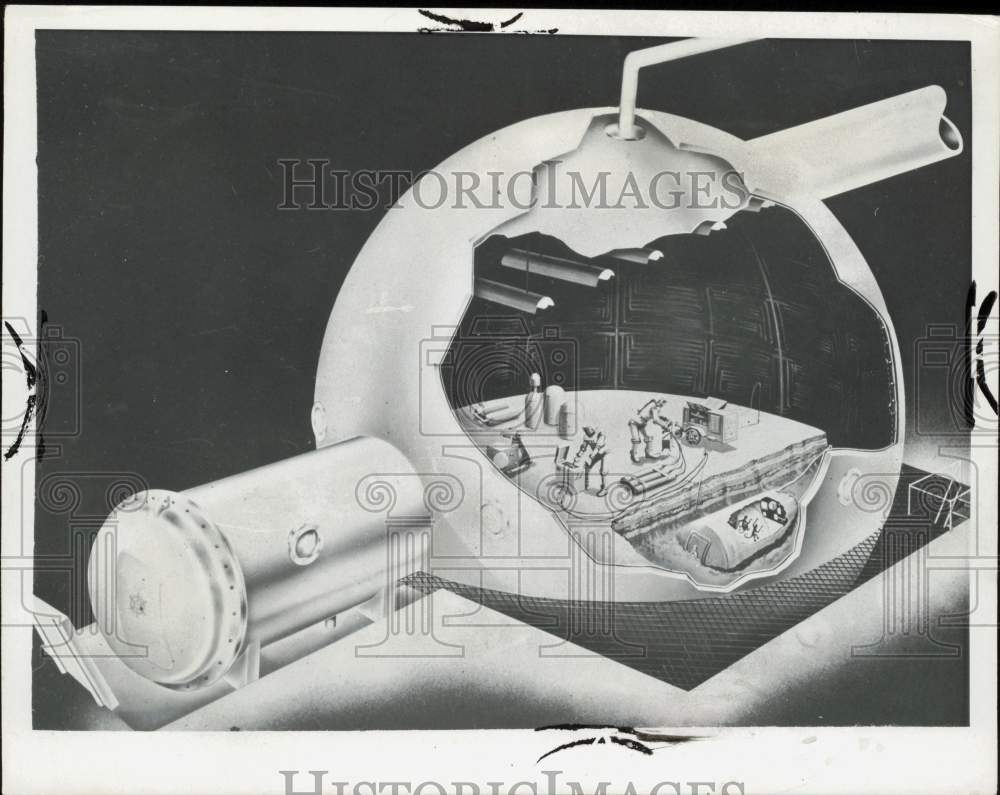
PHOTO BACK
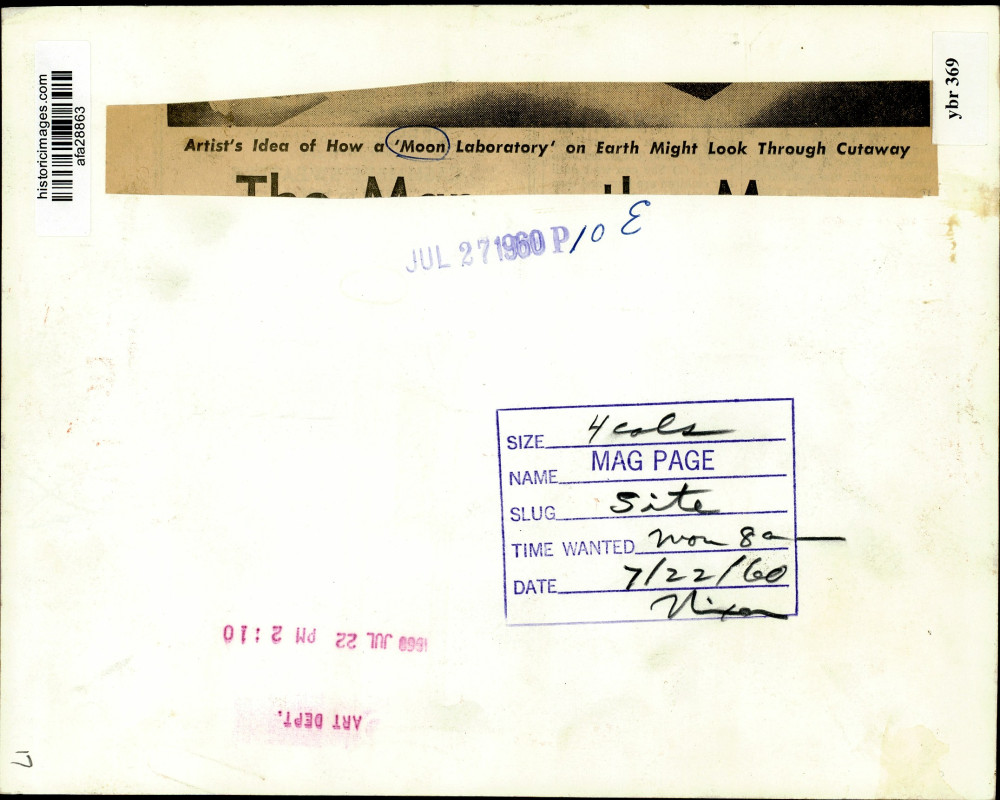
Historic Images Part Number: afa28863
1960 Press Photo Artists Conception of an Underground Early Lunar Base
Early Lunar Base probably would be underground for heat insulation and protection against radiation and meteorites. From left are: air lock, air conditioning and power console, sleeping quarters and cooking area. Artists Conception. Photo measures 9 x 7.25 inches. Photo is dated 07-28-1960.
Part Number: nob73263
1961 Press Photo Artist's drawing, space vehicle tunneling under surface moon
Digging In On Moon--Artist's drawing shows how is space vehicle might nestle in a tunnel under the moon's surface in this illustration released by The Martin Company of Baltimore, which is studying the feasibility of an earth-lunar transport system for NASA. The tunnel is suggested as a practical way to establish a permanent moon base, avoiding extreme service temperature variation. Balloon-like structures and left background represent another type of base. Photo is dated 08-03-1961.
1961 Press Photo Drawing of astronaut traveling between 2 spaceships in space
After achieving mastery of a single spaceship, the astronaut will probably develop skills in traveling between space vehicle so that he can repair unmanned weather or communications satellites or construct space platforms. It is likely that he will be able to move in a lightweight space suit. Drawing of astronaut traveling between 2 spaceships in space. Space-U.S.-Astronauts-Equipment. Photo is dated 11-12-1961.
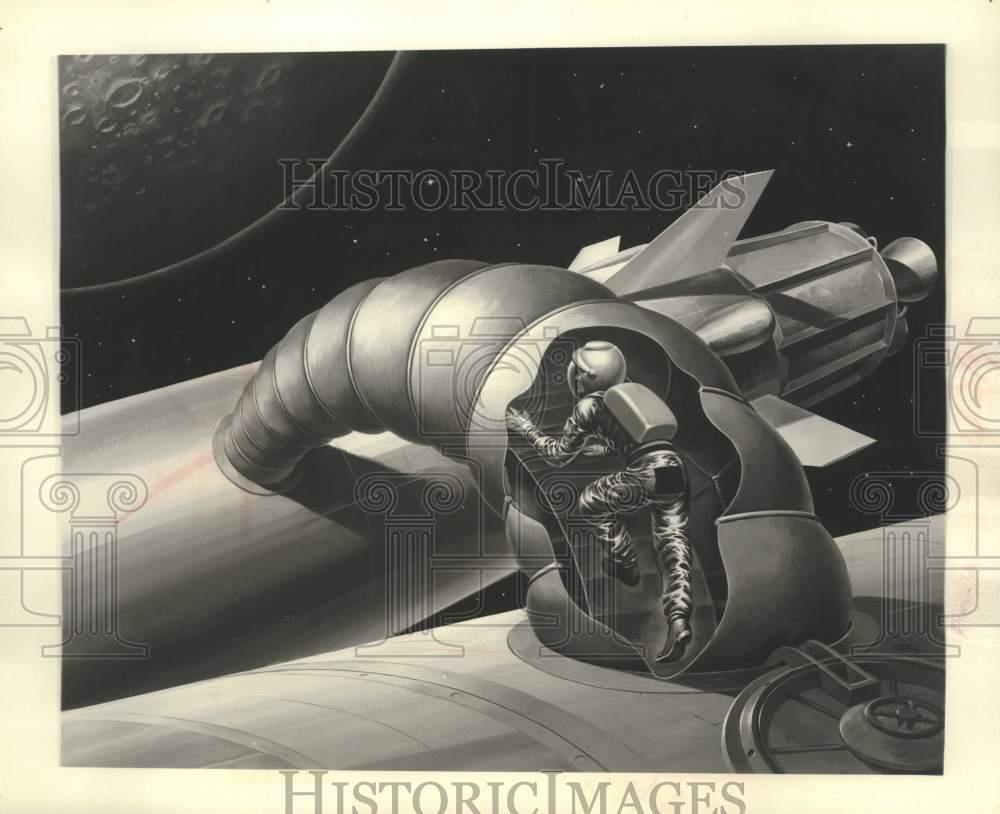
PHOTO BACK
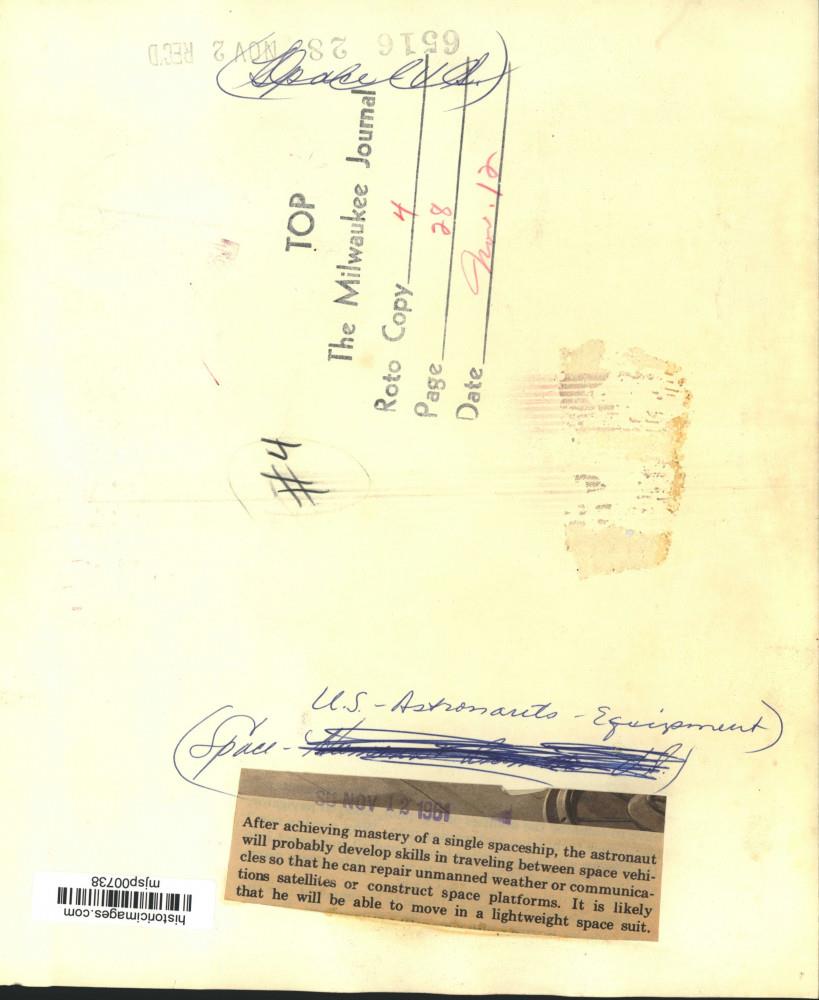
Historic Images Part Number: mjsp00738
1962 Press Photo Model of Moon Vehicle and Astronauts in Space Suites
Moon (lanned visit) Model astronauts in special tublike space suites stop their model moon mobile to collect samples of lunar rock during an over land research trip. Explorers would normally ride suspended from the vehicle, as Number 5 is at right, but long "umbilical hose" would allow them to walk around without disconnecting from air, water and power supplies on the cart.Photo measures 10 x 8.25inches. Photo is dated 06-15-1962.
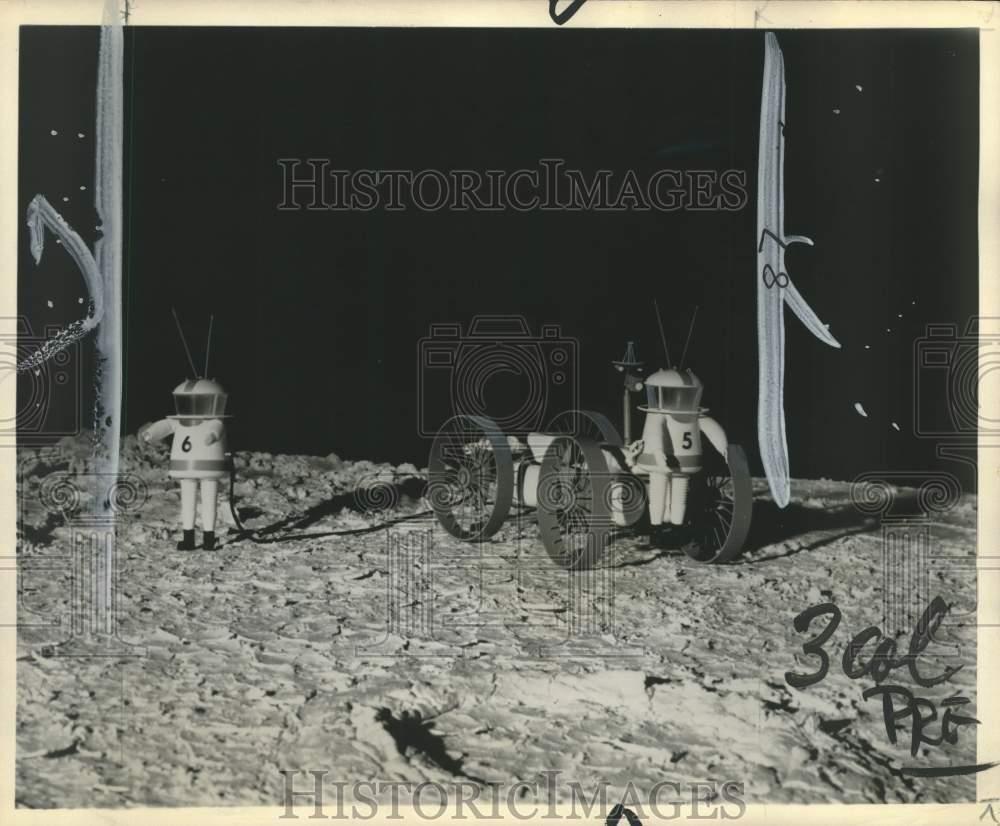
PHOTO BACK
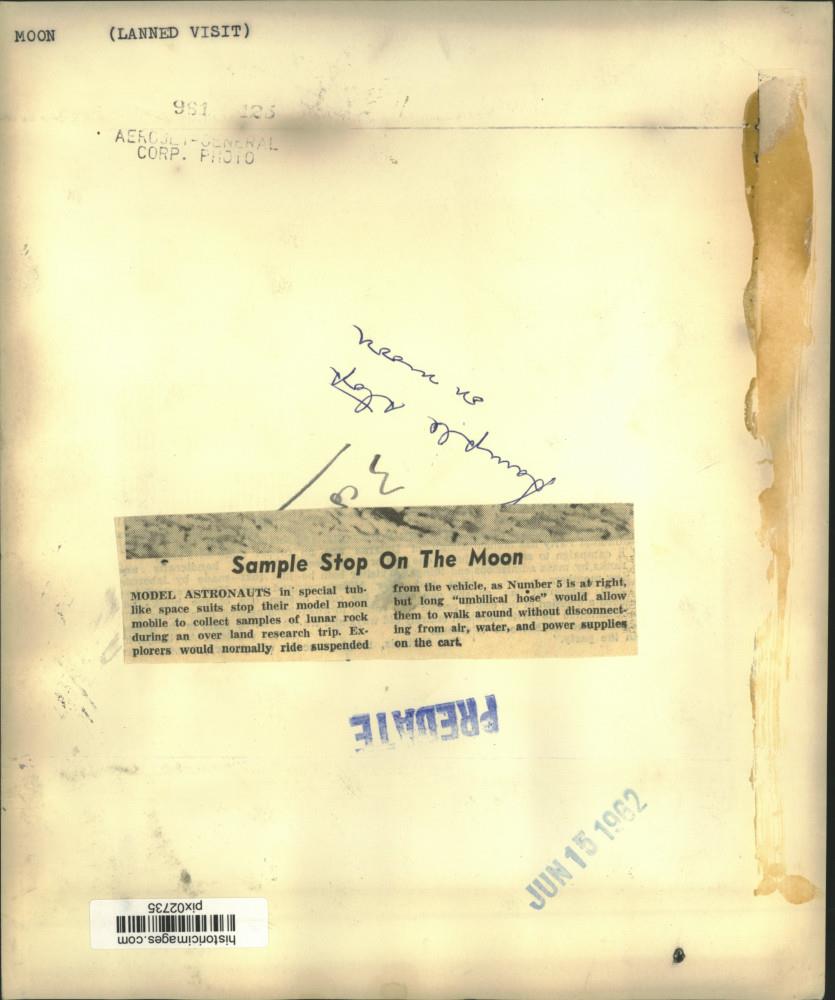
Historic Images Part Number: pix02735
1962 Press Photo Artist Conception Dirigible Blimp Aereon III in Flight
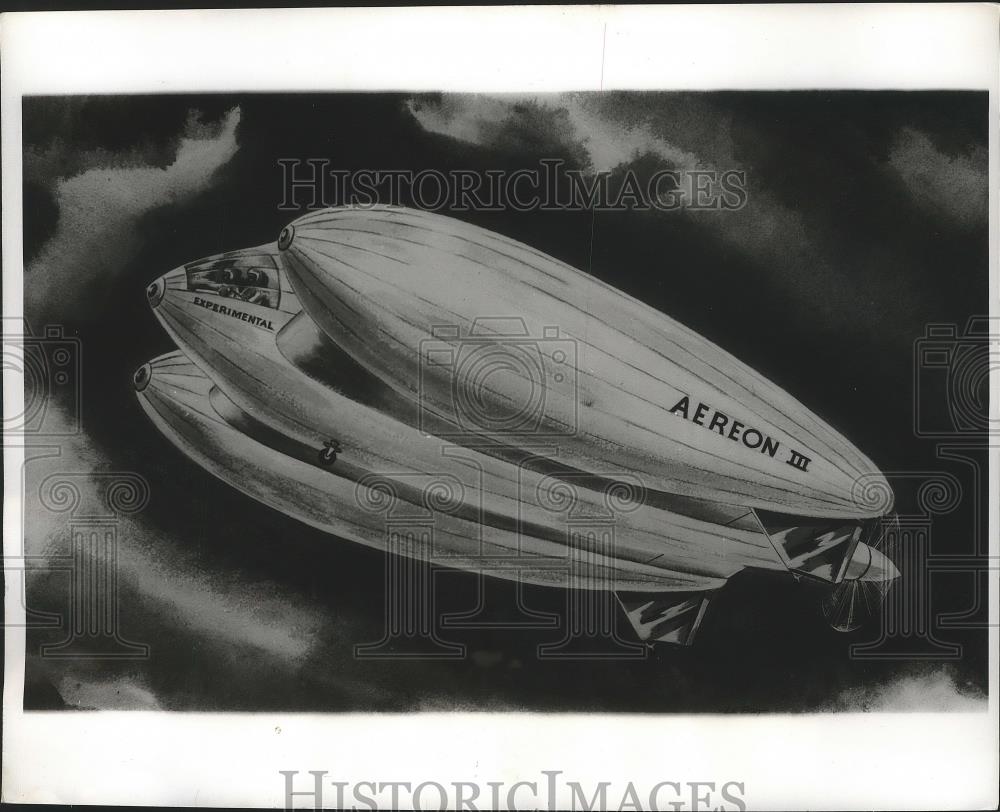
PHOTO BACK
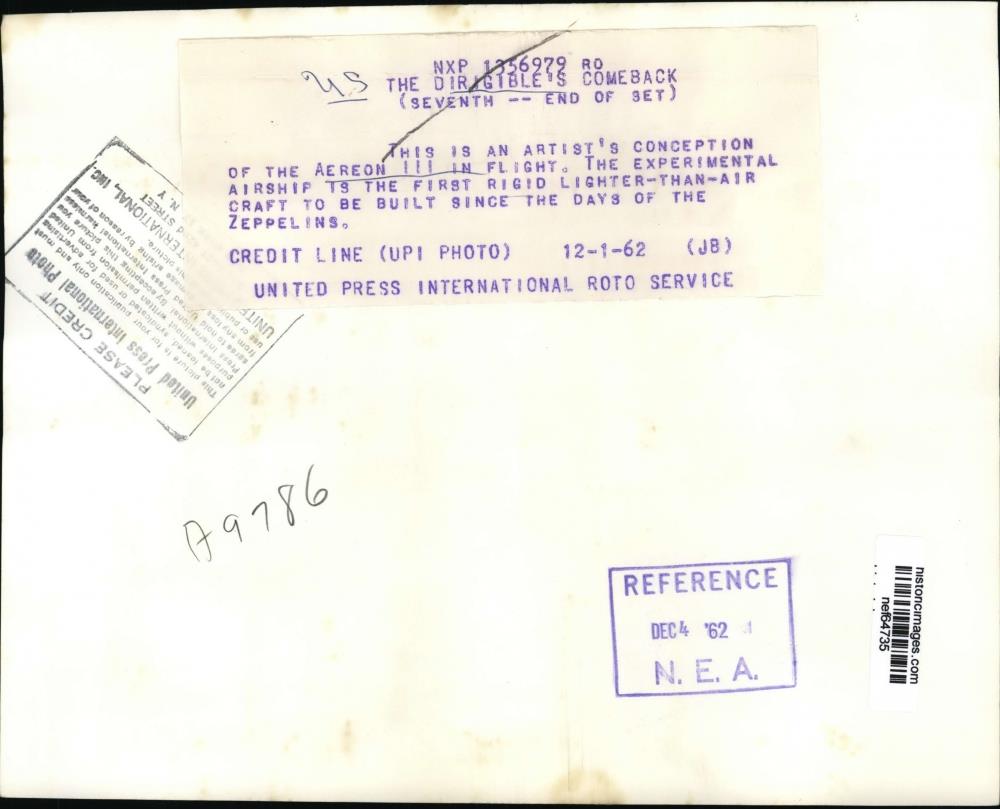
[click an image above to see a larger version]
Historic Images Part Number: nef64735
1962 Press Photo Paul Swanson Inspects Inflatable Space Station at Goodyear
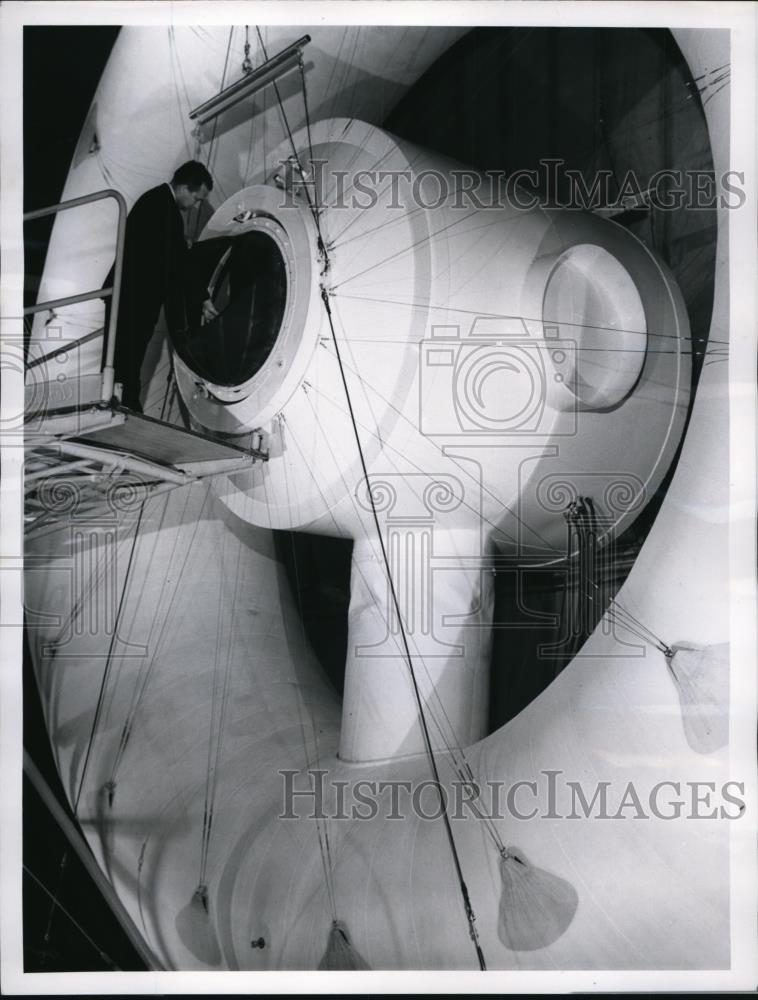
PHOTO BACK
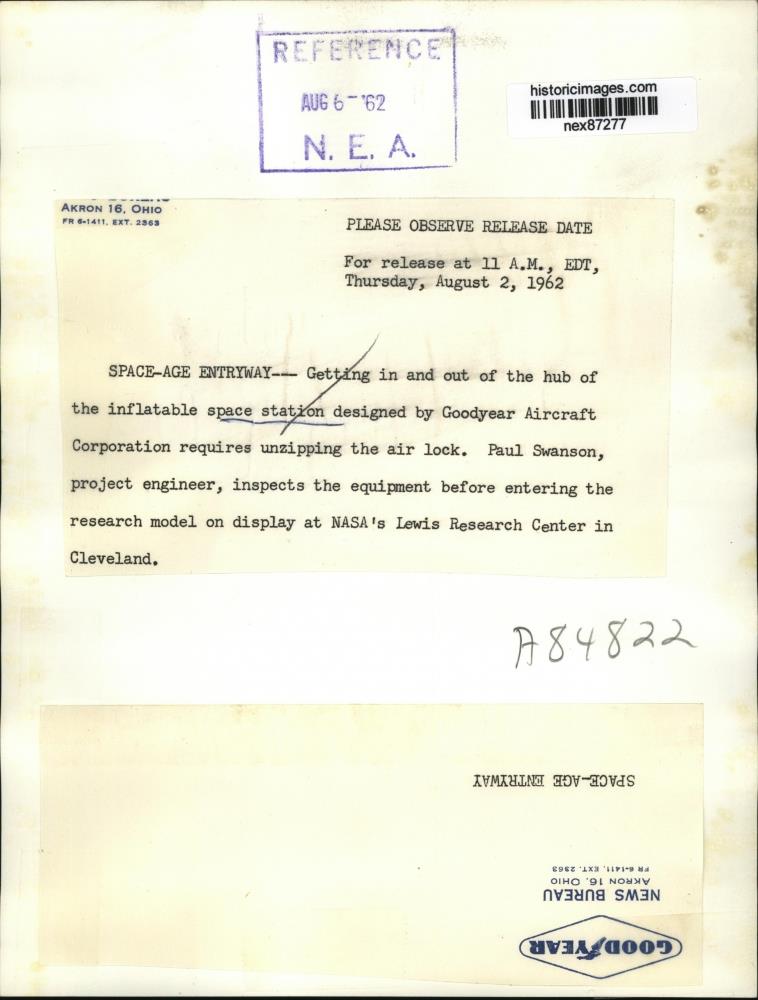
[click an image above to see a larger
version]
Historic Images Part Number: nex87277
1962 Press Photo John F. Kennedy standing next to model of "The Bug" spacecraft
This is an original press photo. Space travel - US - Lunar craft - "The Bug" ---- Houston, Tex. - President sees "The Bug" - President John F. Kennedy stands before a model of the craft, known as "The Bug" which the U.S. hopes to make a lunar landing. Vice President Johnson is at extreme right. Kennedy saw the model during his visit to the NASA installation in Houston today. (Texas)Photo measures 7.5 x 10inches. Photo is dated 09-12-1962.
PHOTO FRONT
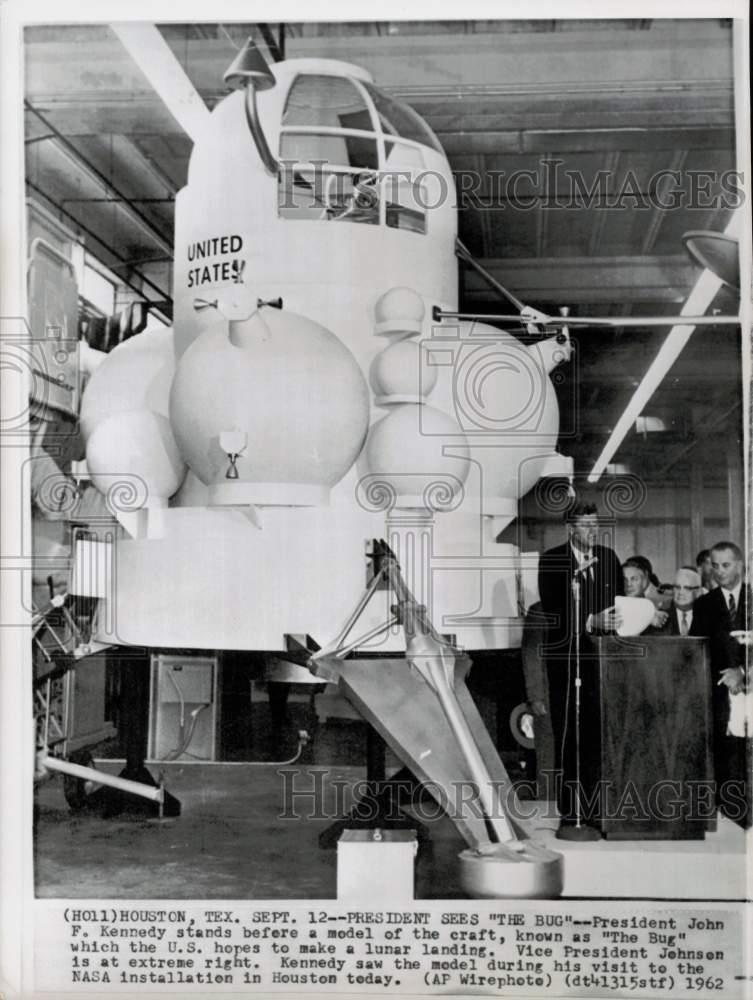
PHOTO BACK
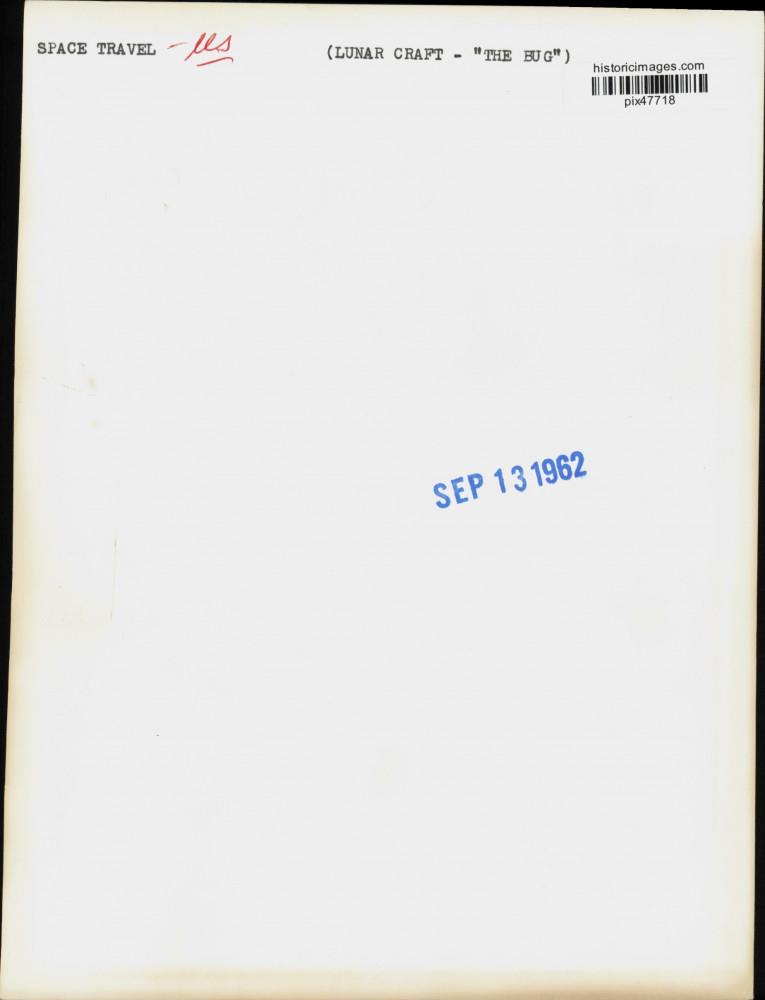
Historic Images Part Number: pix47718
1963 Press Photo Mobile fighter satellite 'ride heard' - cvb56757
1963 Press Photo Rene A Berglund, Chief Space Vehicle Design Branch - mja07366
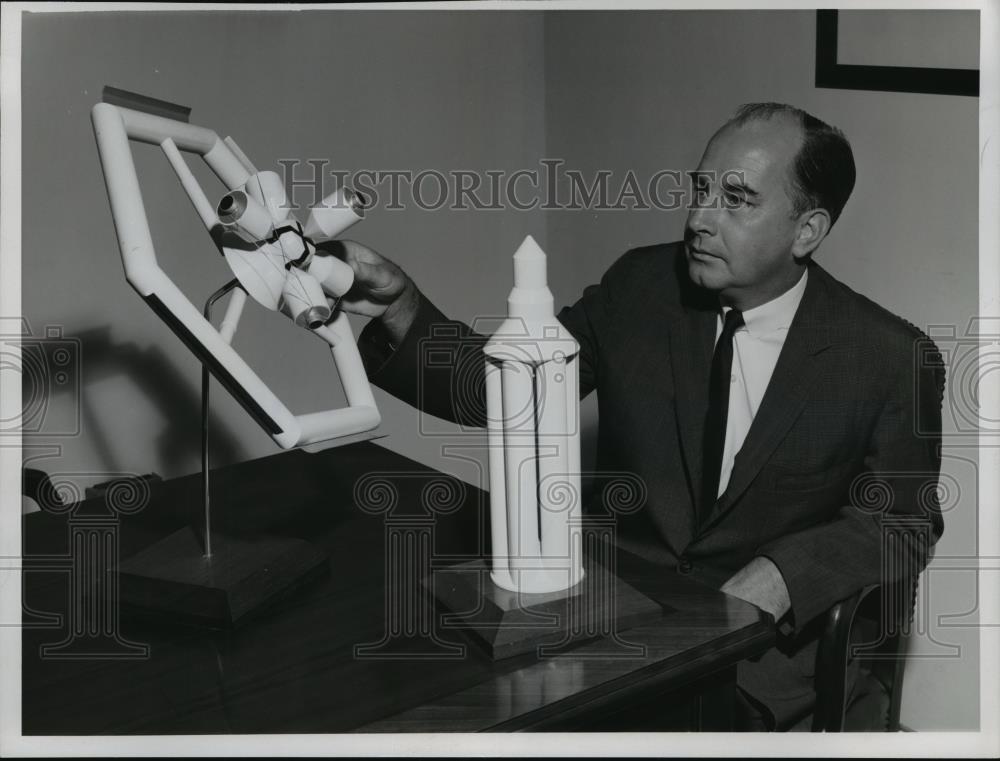
PHOTO BACK
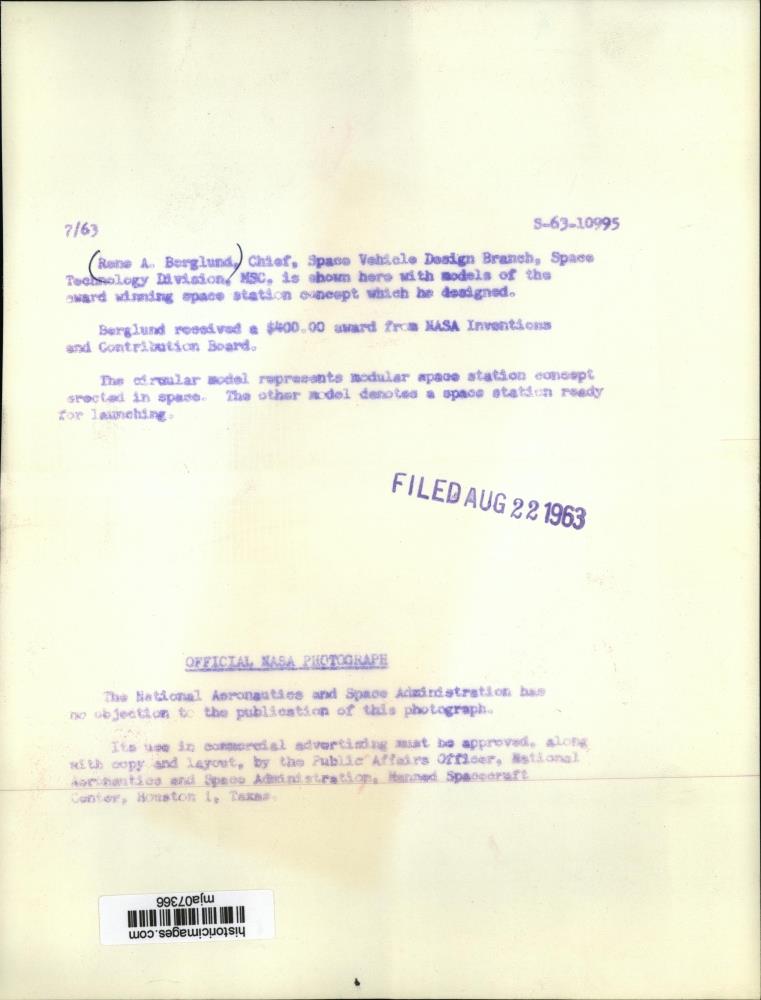
[click an image above to see a larger
version]
Historic Images Part Number: mja07366
1963 Press Photo Artist's concept of what 12 to 24 man spacecraft may look like
This is an original press photo. Space travel - U.S. - Sketch ---- After Apollo is on the moon -- This artist's conception presents one view of what a 12 to 24 man spacecraft may look like when scientists begin to plan for space development after the Apollo landing on the moon. The target date for that project is 1970, after which may come development of space stations, flights to Mars and moon bases. This type of space craft would be launched in pieces and assembled in space by astronauts. Crew replacement and supplies would be brought in by smaller craft, left.Photo measures 10 x 8.25inches. Photo is dated 08-30-1963.
PHOTO FRONT
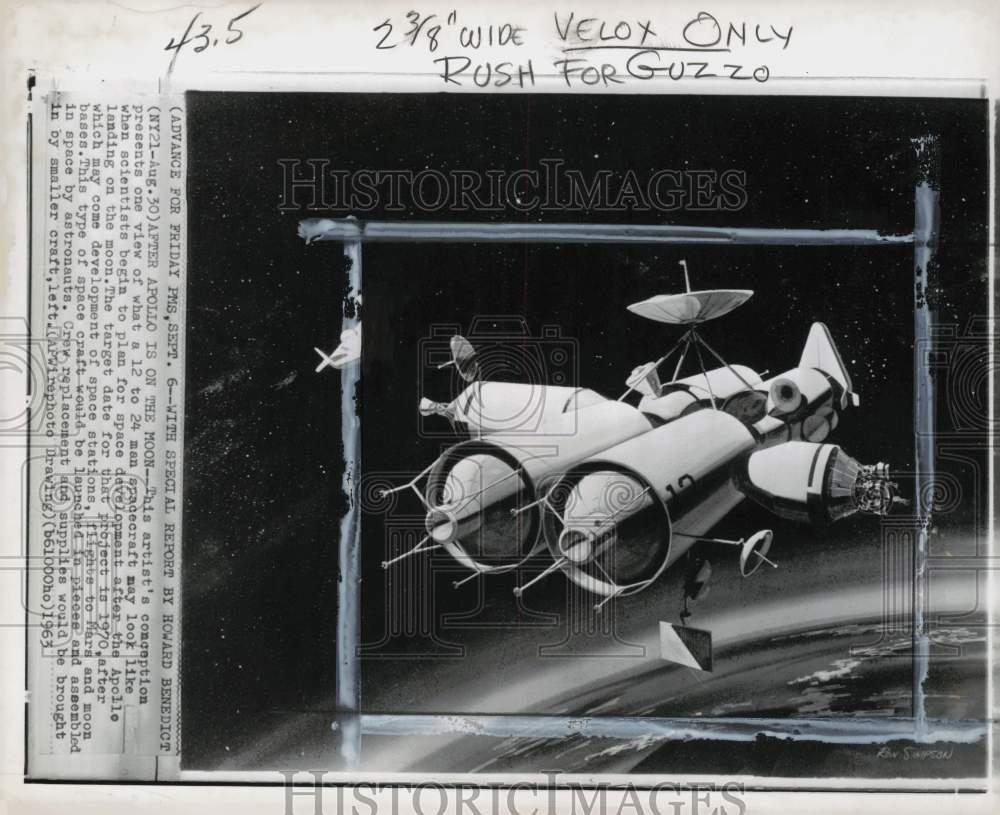
PHOTO BACK

Historic Images Part Number: pix48939
1963 Press Photo First Patient on a space station is believed to have been grant
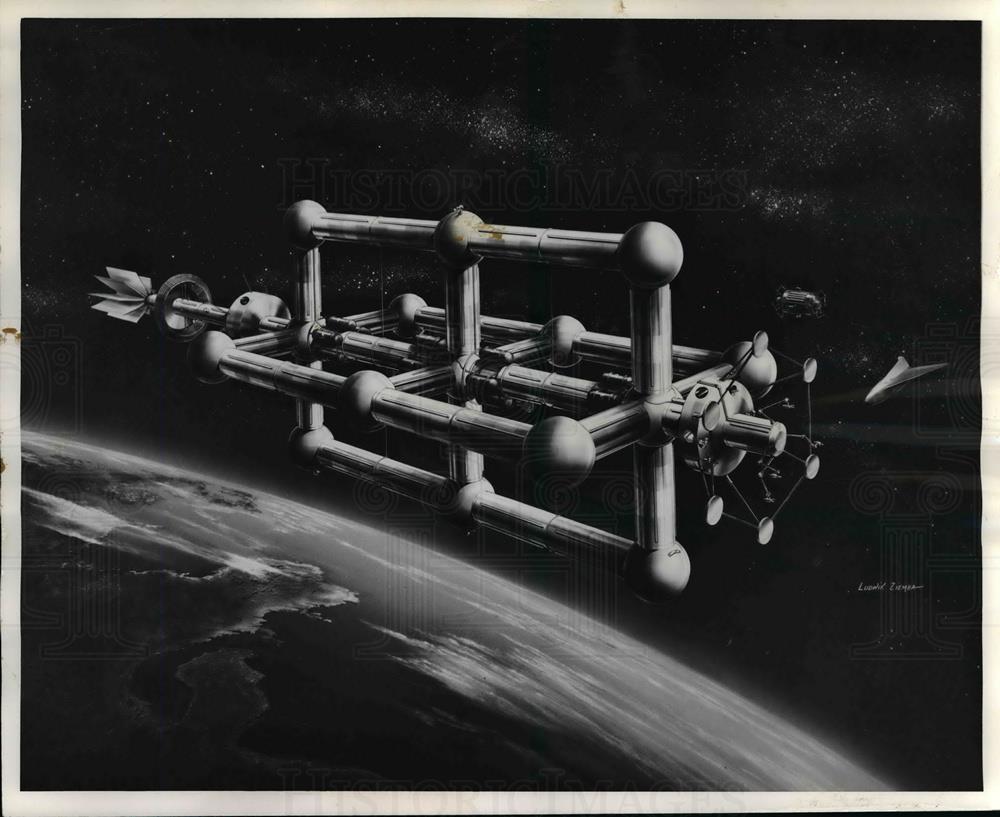
PHOTO BACK
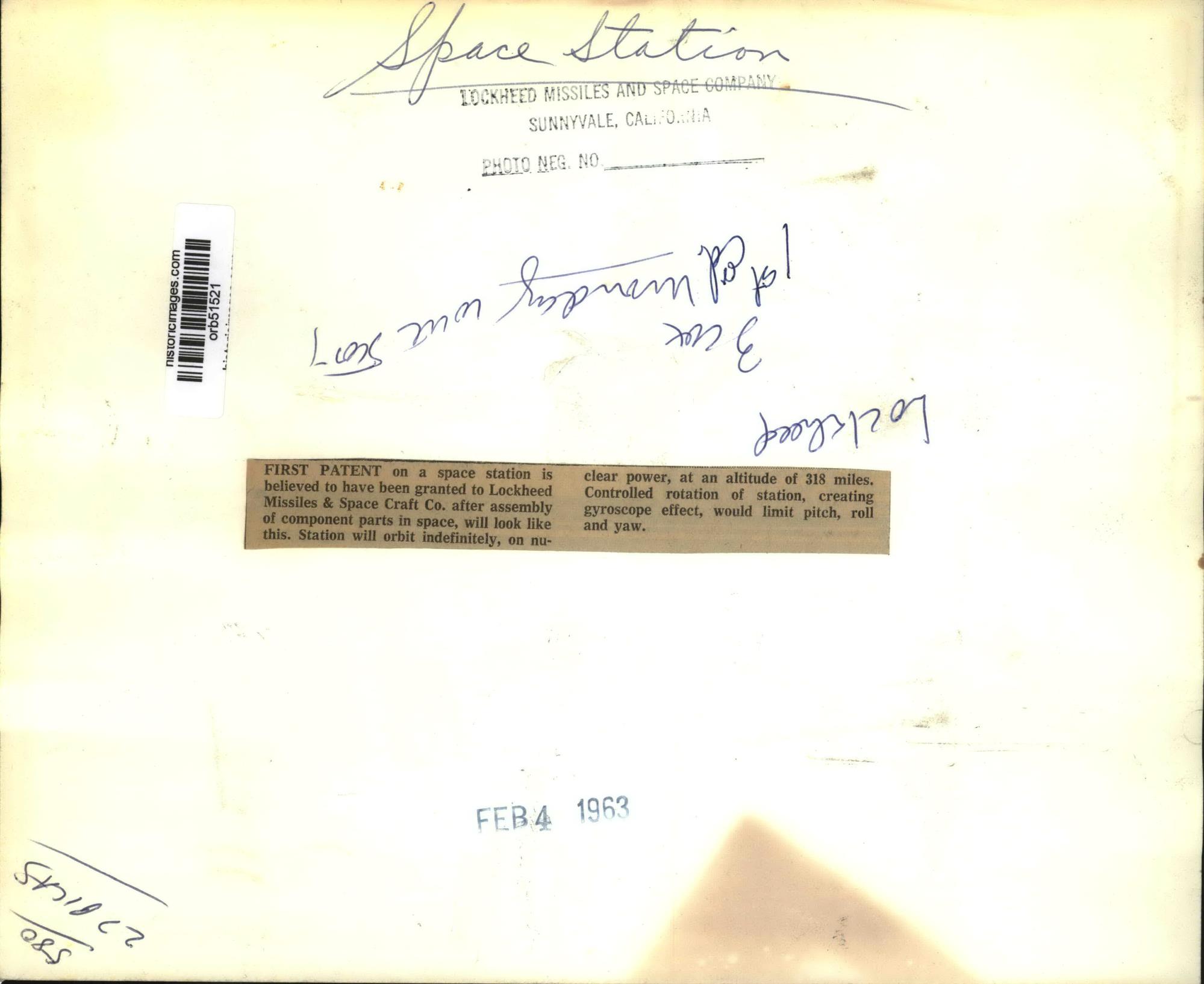
[click an image above to see a larger version]
Historic Images Part Number: orb51521
1963 Press Photo Shape of things to come is portrayed by manned spacecraft
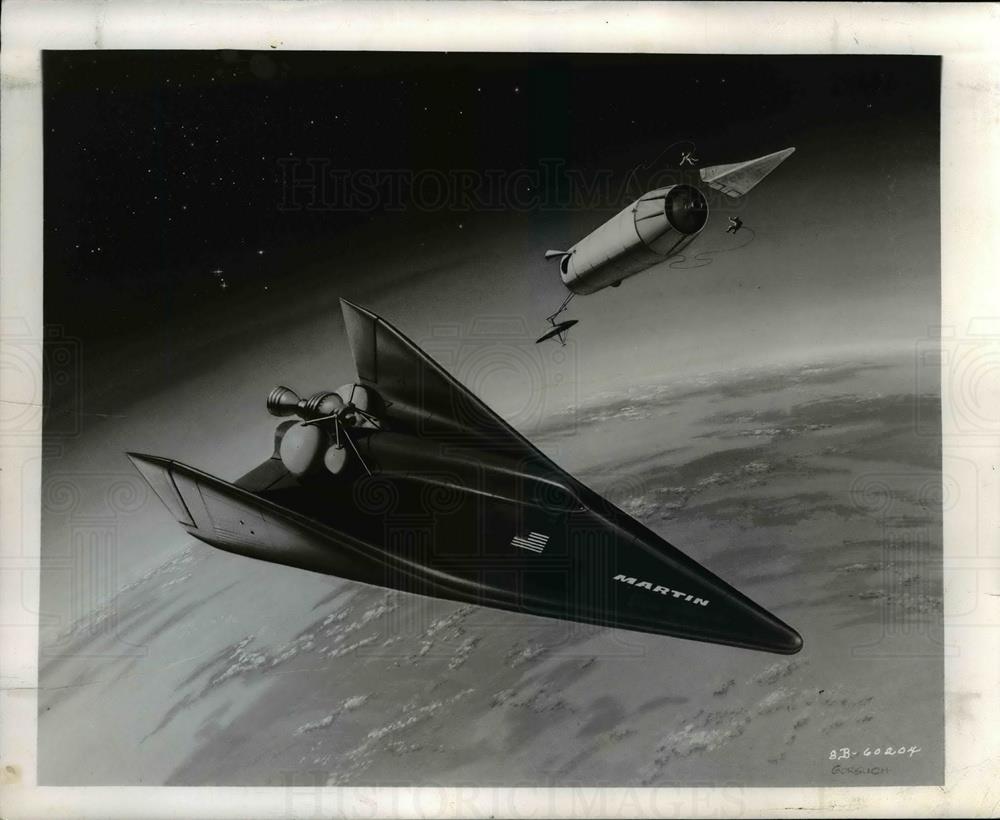
PHOTO BACK
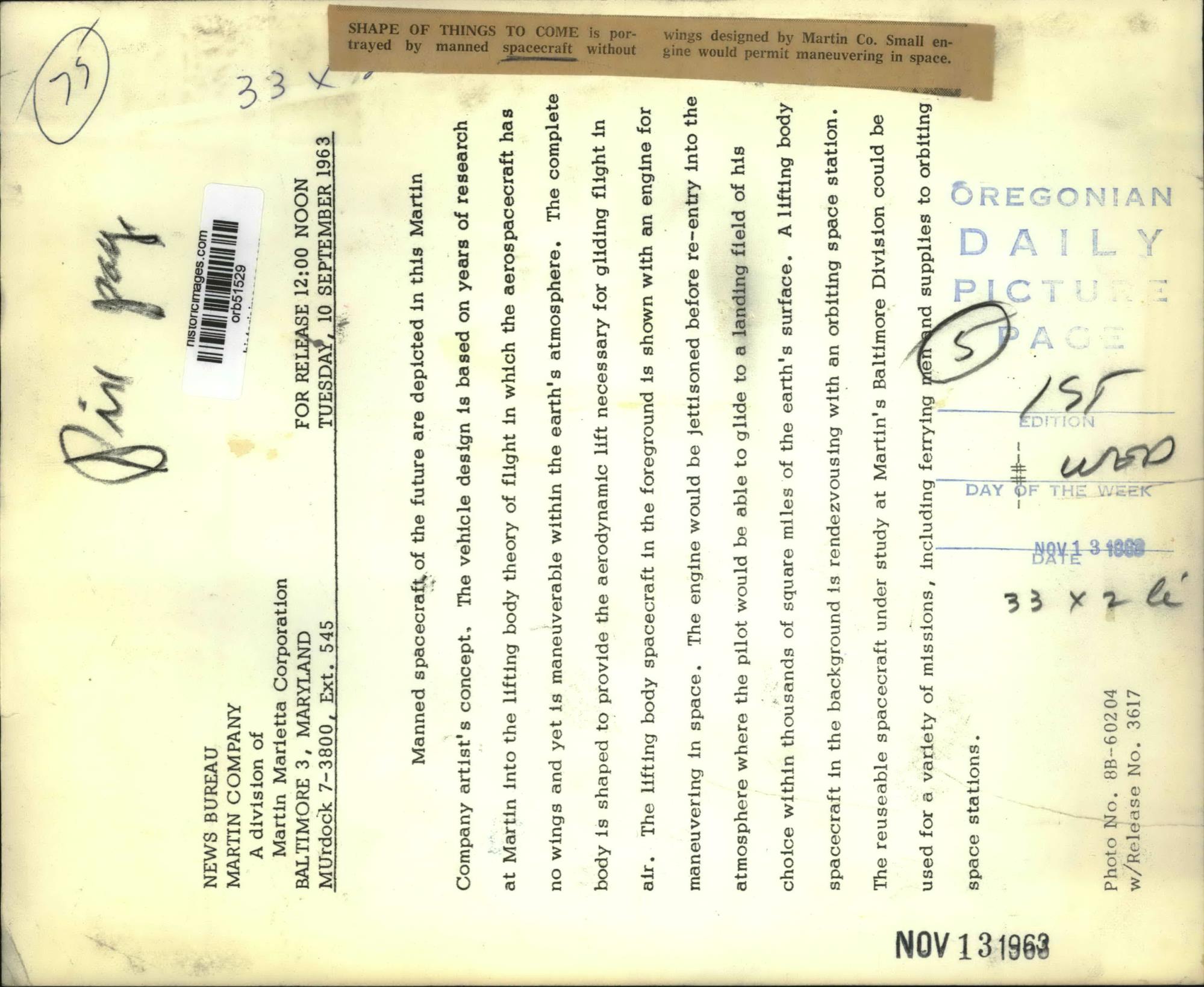
[click an image above to see a larger
version]
Historic Images Part Number: orb51529
1964 Press Photo Design of laboratories and living quarters for lunar explorers
Here's a look, or at least a guess, at how lunar explorers will set up housekeeping on the moon's surface. The tall cylinders can be used as living quarters, laboratories or service areas. The bubble-shaped objects with the gear-like wheels provide the power to move them around. The whole setup is the the product of exploratory design by scientists at the Lockheed Missiles & Space Co. in California. Photo measures 9.25 x 6.75 inches. Photo is dated 06-13-1964.
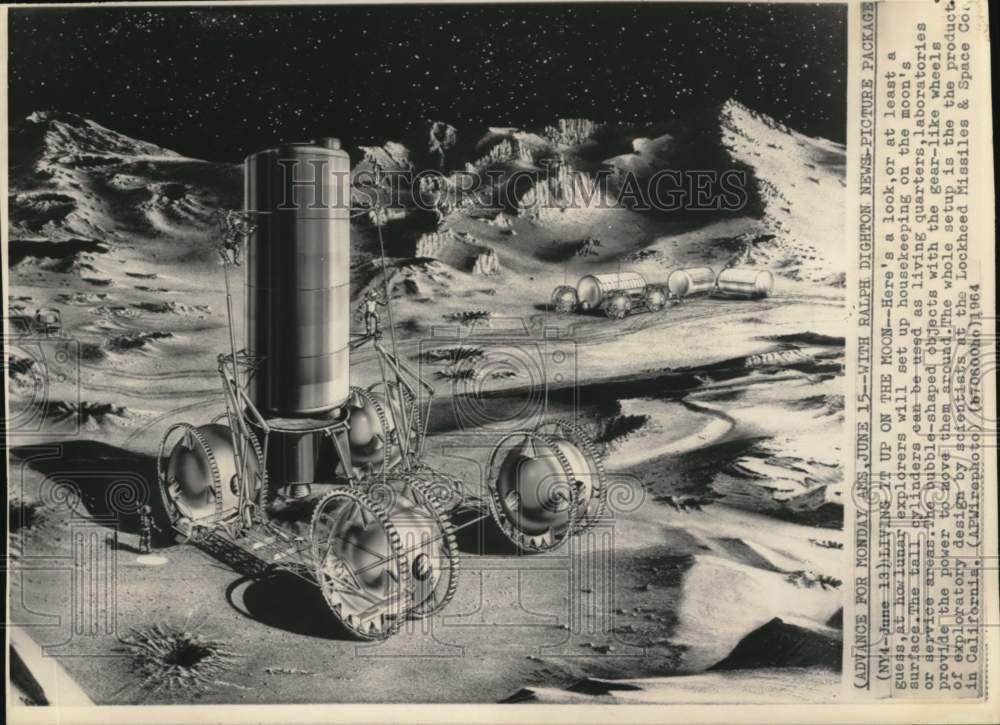
PHOTO BACK
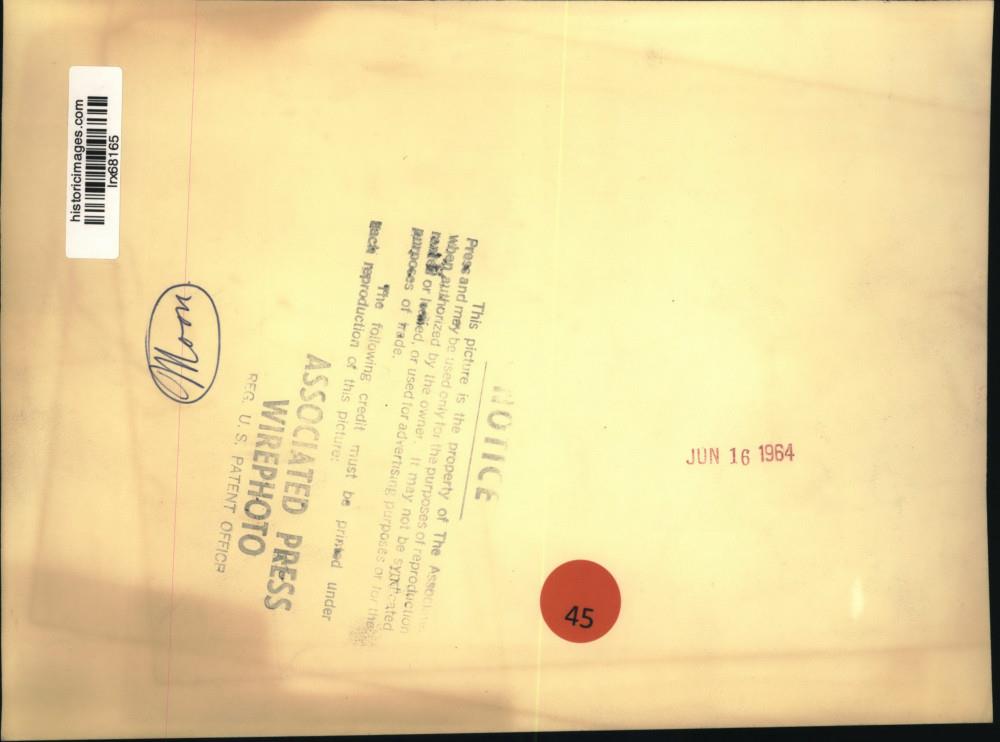
Historic Images Part Number: lrx68165
1964 Press Photo Drawing of jet-propelled recoverable booster - pix48888
This is an original press photo. Rockets - Boeing Company ---- Perhaps most dramatic potential use of The Boeing Company's new Boardman test site in Oregon would be for testing rocket - or jet-propelled recoverable boosters such as the one shown in this sketch. Craft would be used to launch other vehicles, and then would be returned to base to be used again and again. Such a craft is "far in the future," Boeing says. it would be manufactured elsewhere, but production testing and refurbishment could be done at Boardman. Tests would require the building of a long, heavy-duty runway at the Boardman test site.Photo measures 10 x 8.25inches. Photo is dated 02-22-1964.
PHOTO FRONT
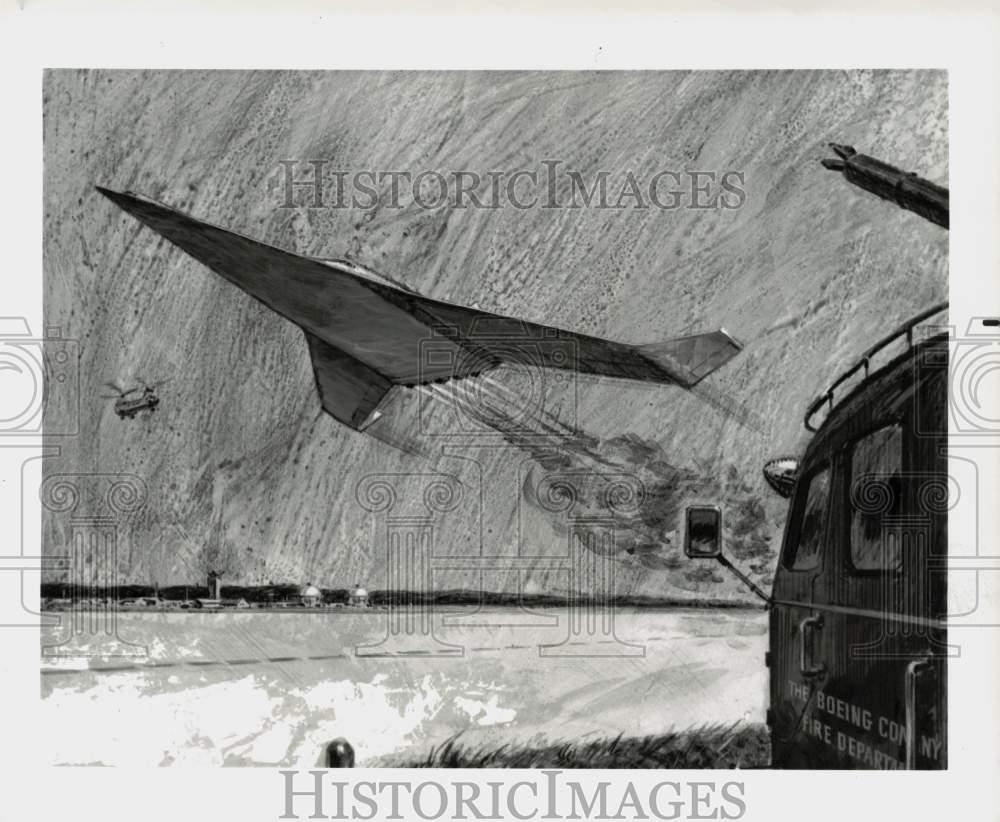
PHOTO BACK

Historic Images Part Number: pix48888
1964 Wire Photo Satellites-Anti Satellite Vehicle Concept explored by Scientist
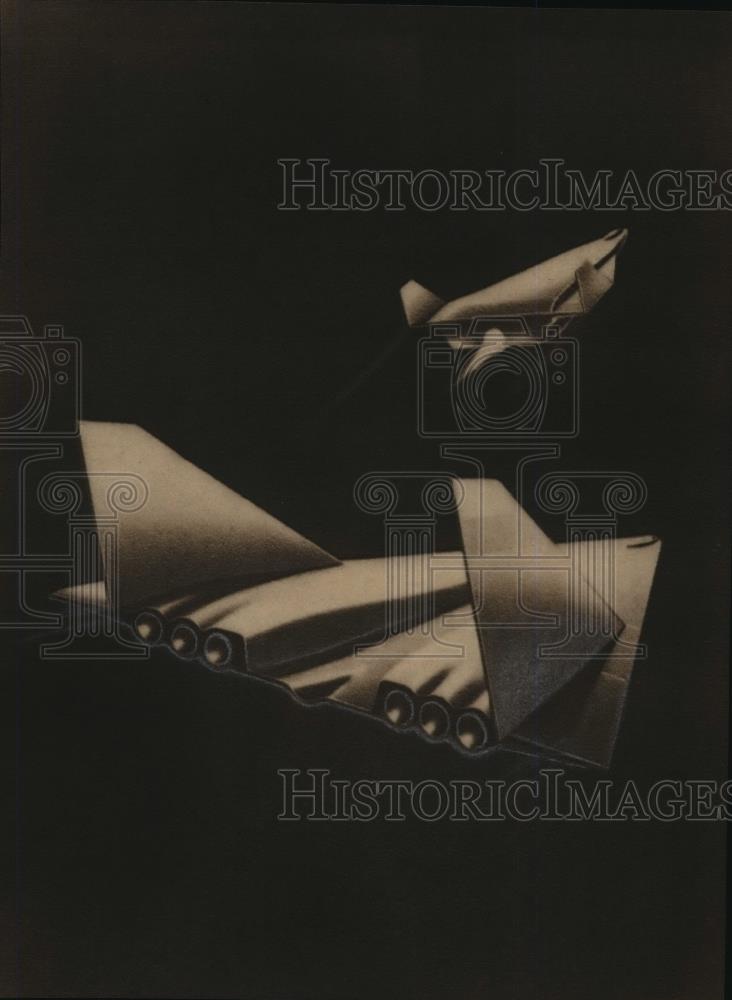
PHOTO BACK
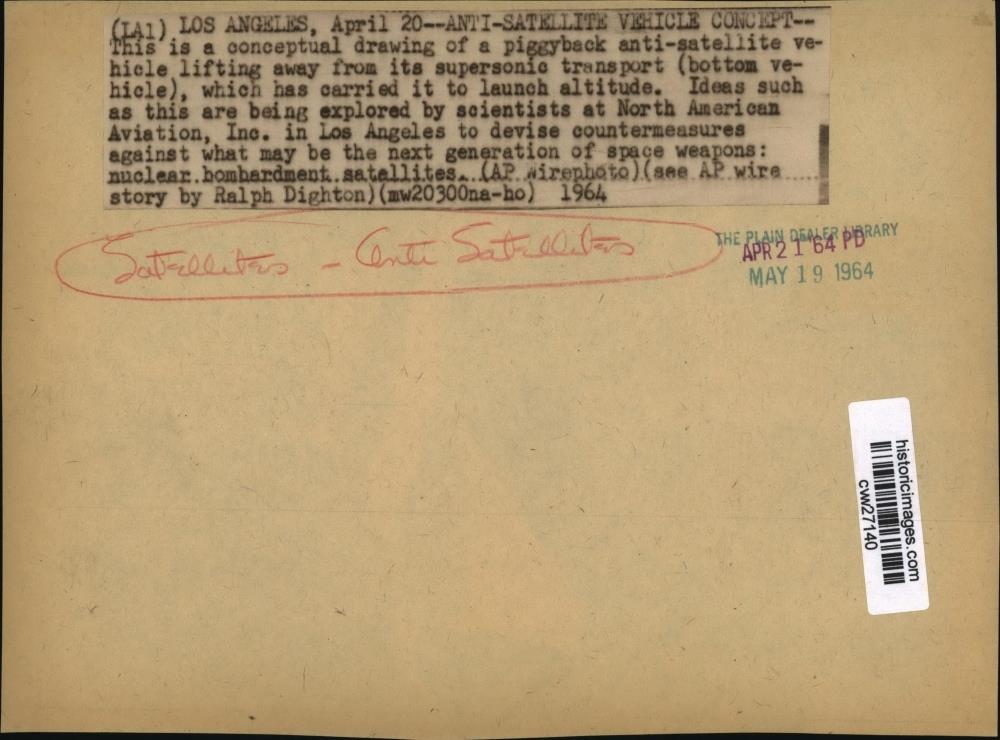
[click an image above to see a larger version]
Historic Images Part Number: cvw27140
1964 Press Photo Artist concept of rocket-powered lunar transportation device
This is an artist concept of the rocket-powered lunar transportation device that would give an astronaut a range of 12 miles on the moon. The device was designed by North American's Space Division at Downey, California, and is nicknamed the "pogo stick" because it moves over terrain in relatively short hops. It is guided by leaning in the direction the operator wants to go. Space - U.S. - Moon - Surface Vehicles. Photo is dated 11-05-1964.
Historic Images Part Number: mjsp00571
1966 Press Photo United Technology artists depict astronauts on moon landscape
Drawing by artists at United Technology Center depicts astronauts on a moon landscape as they would use a new back-pack rocket, proposed by UTC, to maneuver above the surface. Center tank contains solid propellant which is ignited by water contained in two outer tanks. Such rockets would also be ideal for guerrilla warfare troops here on earth. Photo measures 8 x 10 inches. Photo is dated 7-18-1966.
PHOTO FRONT
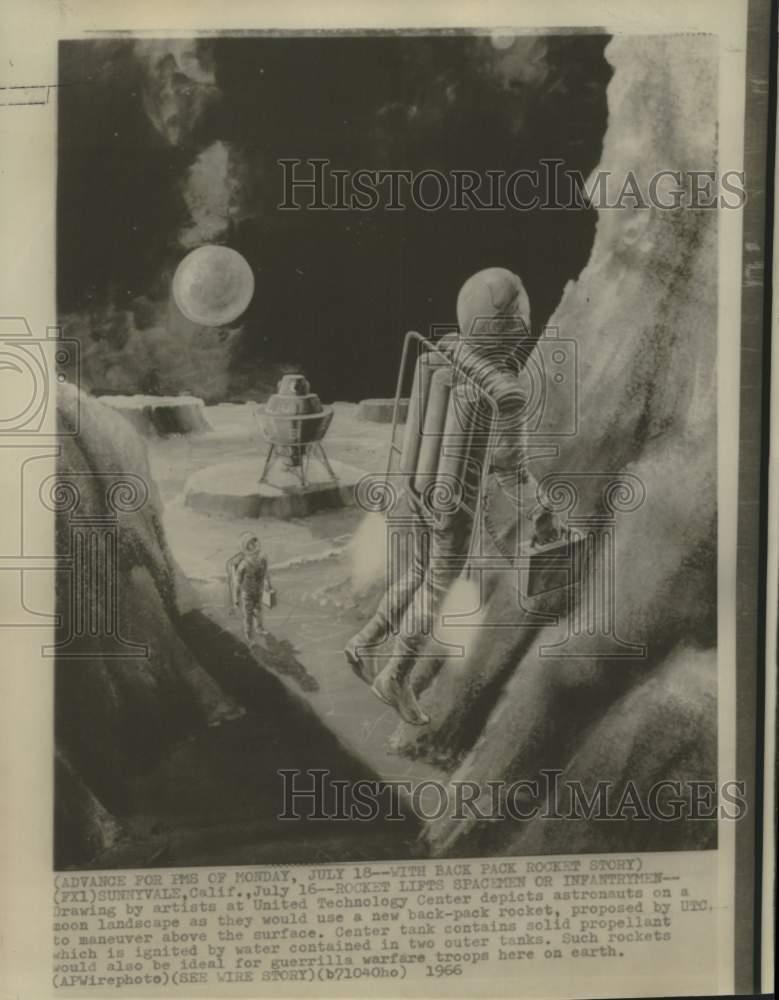
PHOTO BACK
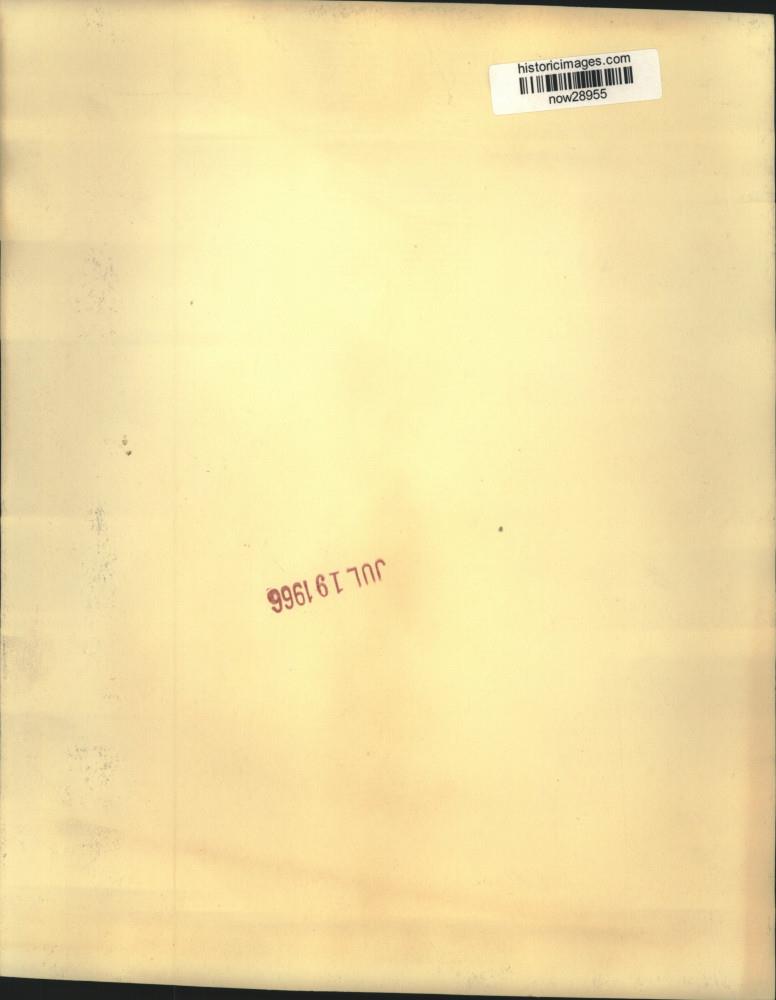
Historic Images Part Number: now28955
1967 Press Photo Lunar rover featured on CBS News special "To The Moon"
This is an original press photo. Space travel - U.S. The lunar rover, a manned mobile laboratory anticipated as a mode of transportation on the moon, is discussed by CBS News Correspondent Walter Cronkite (left), principal reporter for "The 21st Century" color television series, as it will be demonstrated on the second program, "To the Moon," Sunday, February 5, 6:00 - 6:30 PM on the CBS Television Network. Briefing Cronkite is a Grumman Aircraft Corporation research engineer. Seen at the far left of the simulated moonscape at Riverhead, Long Island, New York, is a portion of an Apollo space craft lunar landing vehicle. The CBS News series is sponsored in the public interest by Union Carbide Corporation.Photo measures 10 x 8.25inches. Photo is dated 01-26-1967.
PHOTO FRONT
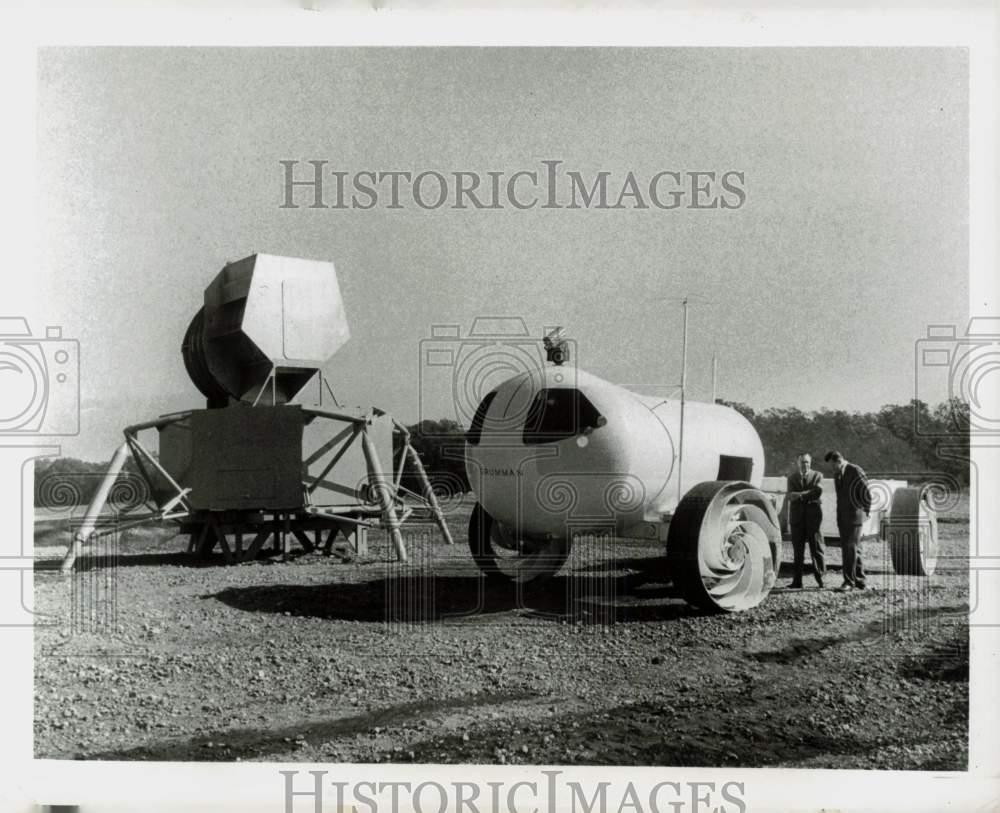
PHOTO BACK
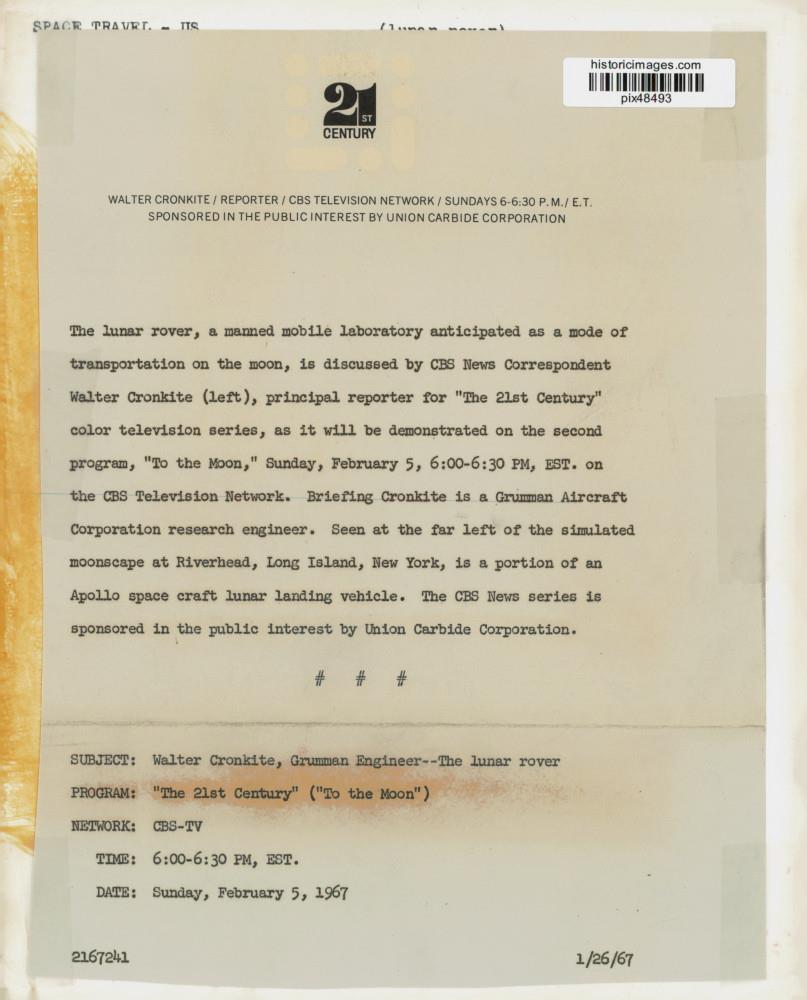
Historic Images Part Number: pix48493
1969 Press Photo Auto for moon exploratory purposes - now29689
For a night out on the moon, this car might be just the vehicle. Designed by Lockheed Missiles & Space Company scientists for a 600-mile round-trip from a lunar base site, it would provide about 200 hours at destination site for exploratory purposes. Photo is dated 1-28-1969.
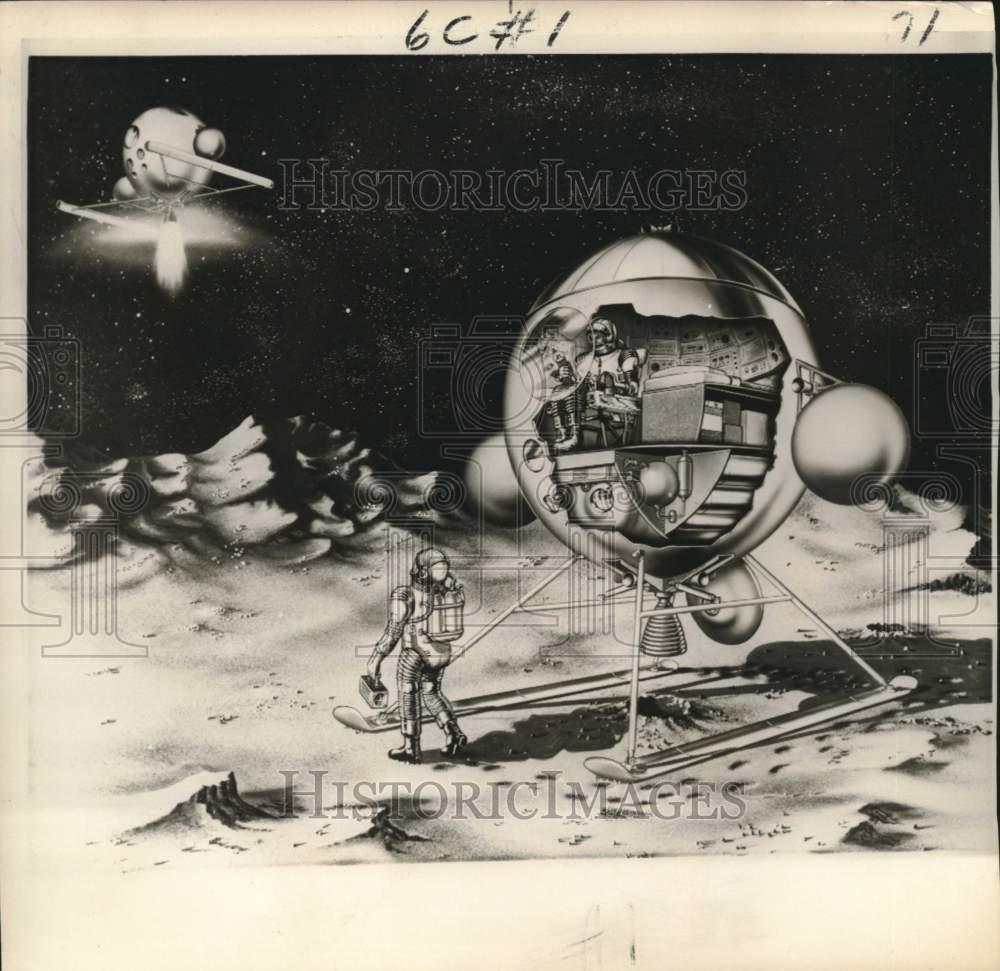
PHOTO BACK
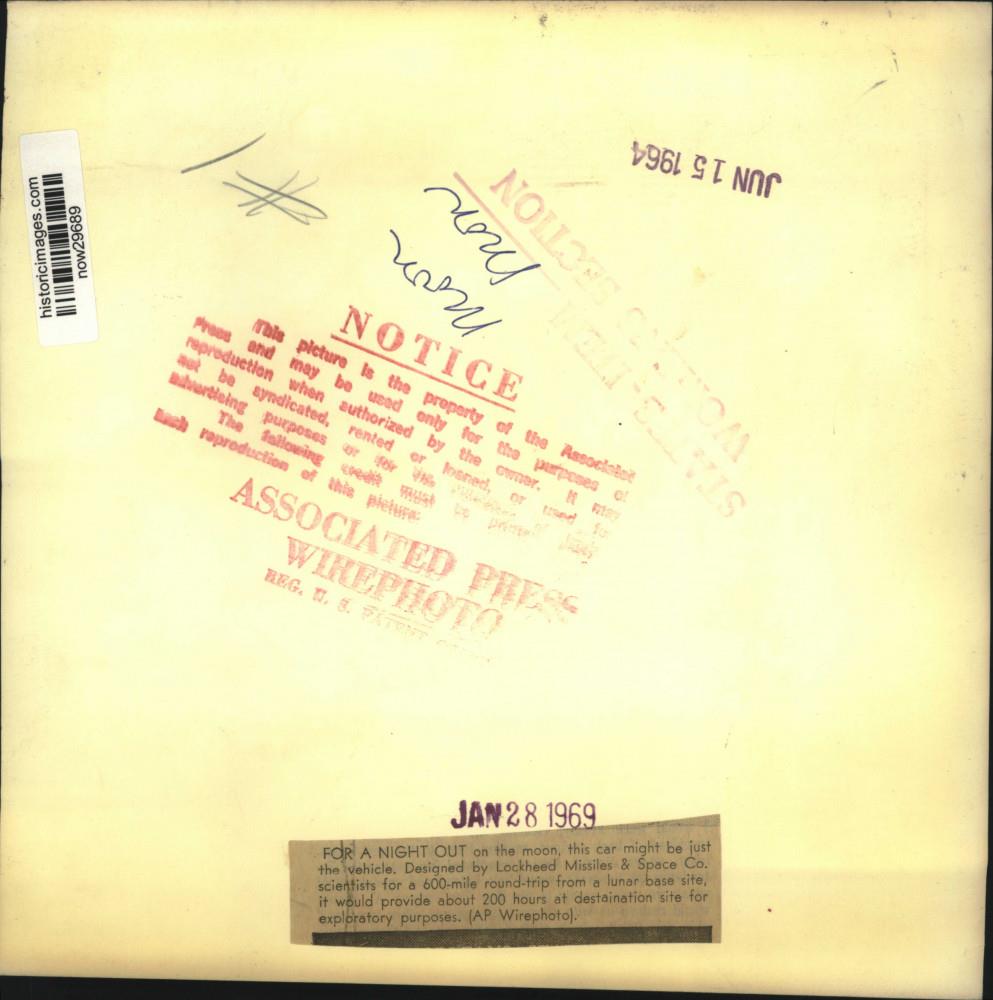
Historic Images Part Number: now29689
1969 Press Photo Artists depict spacemen constructing a future space station
Artists depict spacemen constructing a future space station. Soviet Cosmonaut Alexei Leonov and artist Alexei Sokolov collaborated on this imaginative drawing of spacemen constructing a space station of the future. The drawing was published Friday in the U.S.S.R. Defense Ministry newspaper Krasnaya Zveda. MoscowPhoto measures 10.5 x 8.25inches. Photo is dated 10-17-1969.
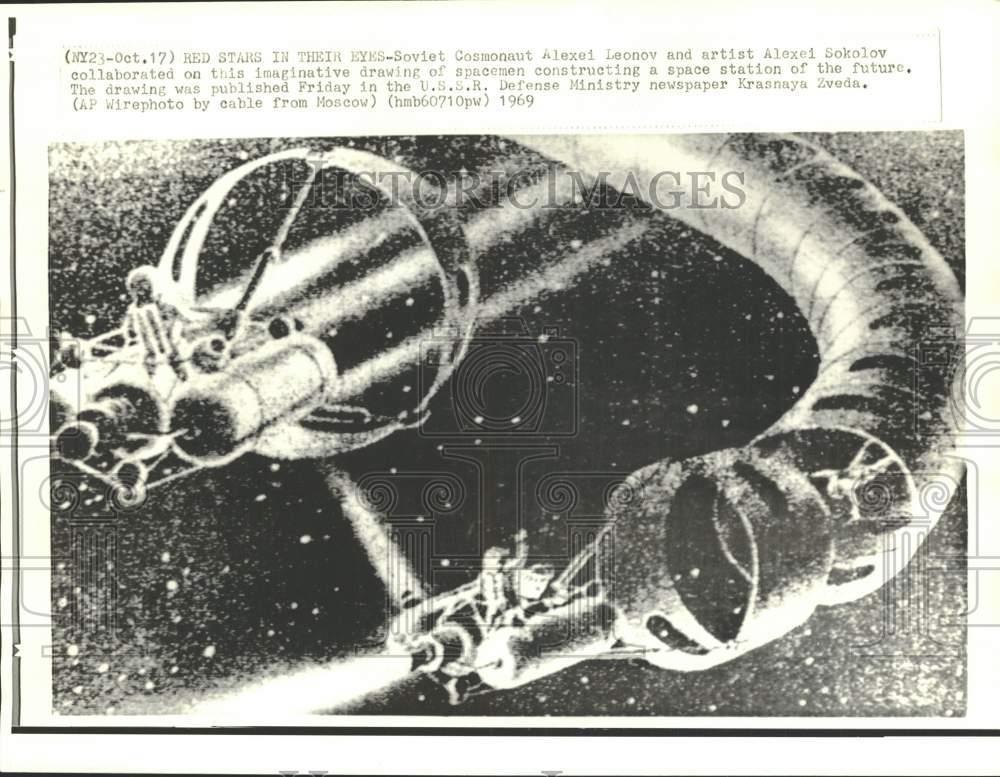
PHOTO BACK
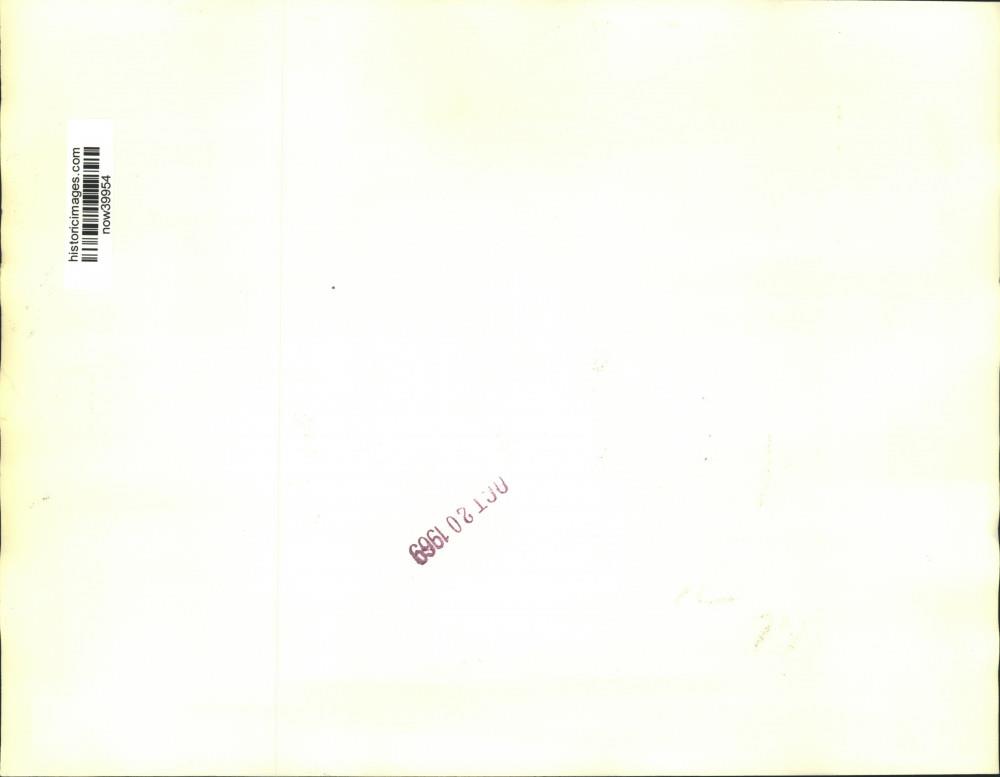
Historic Images Part Number: now39954
1969 Press Photo An artist sketch of what Lunar Surface Flyer will looks like.
Artist ' concept of a Flying Lunar Excursion Experimental Platform, or FLEEP, that North American Rockwell's Space Division has announced plans to design under a contract with NASA's Langley Research Center. The one-man flyer will be tested in a simulation facility at Langley to evaluate designs for lunar surface flyers.Photo measures 8 x 8.75inches. Photo is dated 10-27-1969.
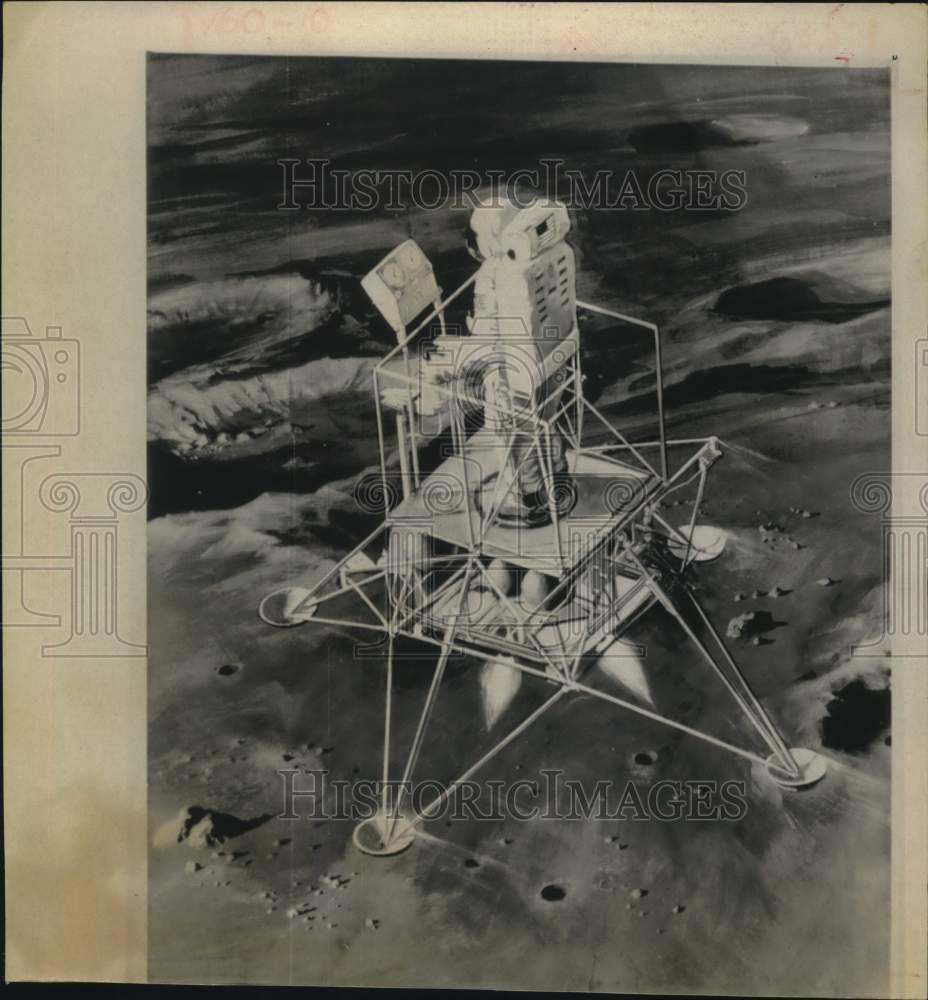
PHOTO BACK
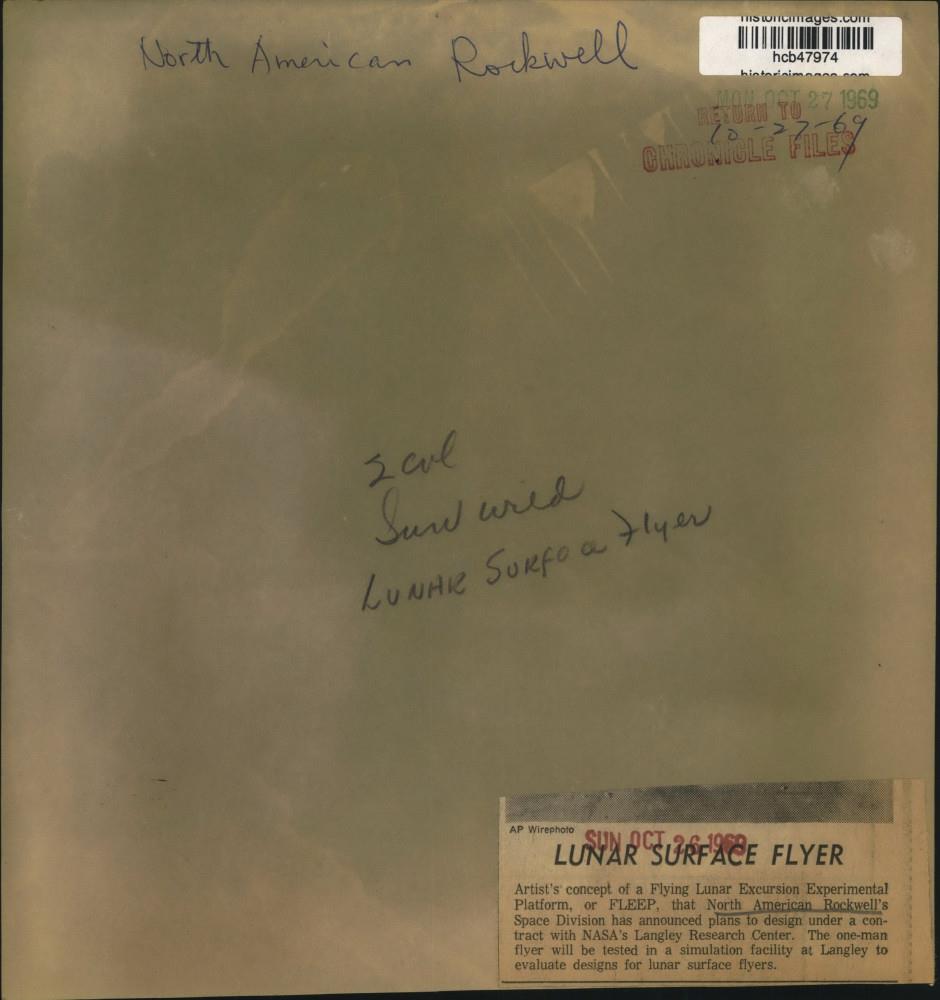
Historic Images Part Number: hcb47974
1968 Press Photo Lockheed's concept of "multipurpose reusable spacecraft"
This is an original press photo. Space travel - US ---- When man flies in space -- Lockheed-California Company engineers envision a two-man crew in this concept of a "multipurpose reusable spacecraft" - MRS, currently under study for the U.S. Air Force. The Burbank-based aerospace company sees manned maneuvering entry as the beginning of step by step development of reusable space systems. Technology from such spacecraft would apply to future hypersonic transports. Highly maneuverable entry craft - capable of aircraft-type landings in routine operation - present the difficult design challenge of carrying a human crew safely through the entire flight spectrum, from low landing speeds to high in-flight speeds up to 20 times the speed of sound. This latest Lockheed concept results from ten years' research and study of high-lift-to-drag ratio -- highly maneuverable -- entry vehicles. For the Air Force, MRS design studies date back four years. The craft conceived here - one of a design series - achieves the high payload-carrying capacity important to useful mission accomplishment. Rocket-powered for hypersonic flight in atmosphere and space, the design uses a turbo-jet engine for low speed maneuvering and landing. Jet fuel is carried in the tank directly behind crew quarters. Jet engine air intake duct is seen forward of tail fin, with engine directly in line behind it. The rocket engine is mounted below jet engine at .....Photo measures 10 x 8inches. Photo is dated 10-27-1968.
PHOTO FRONT
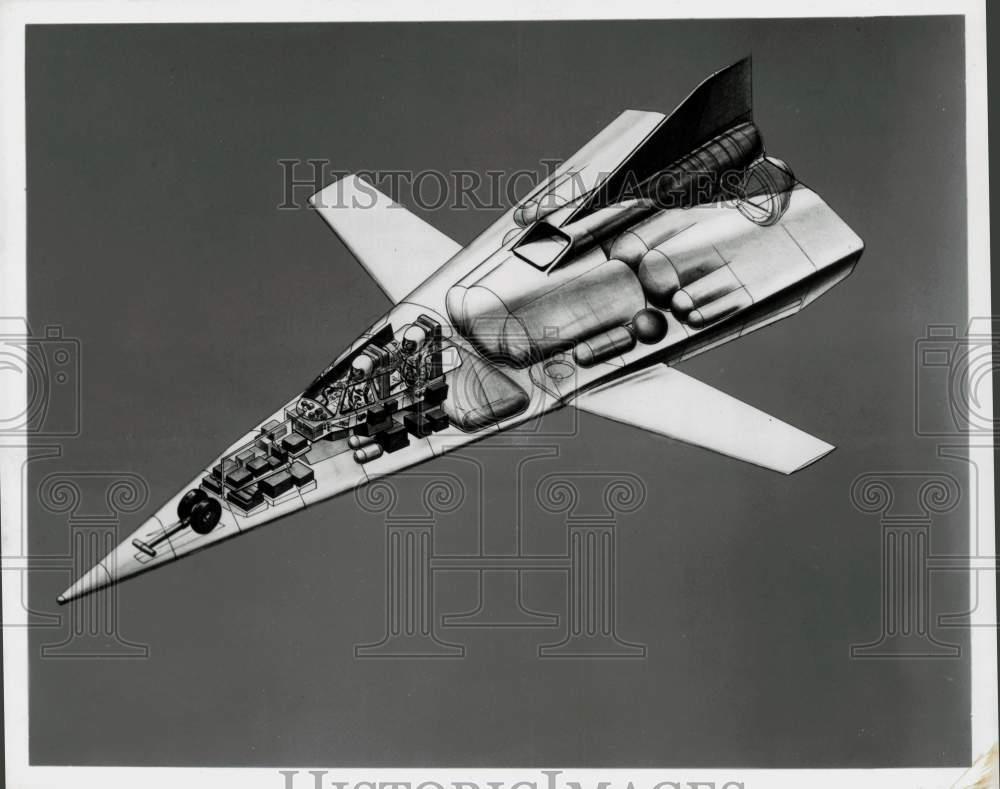
PHOTO BACK
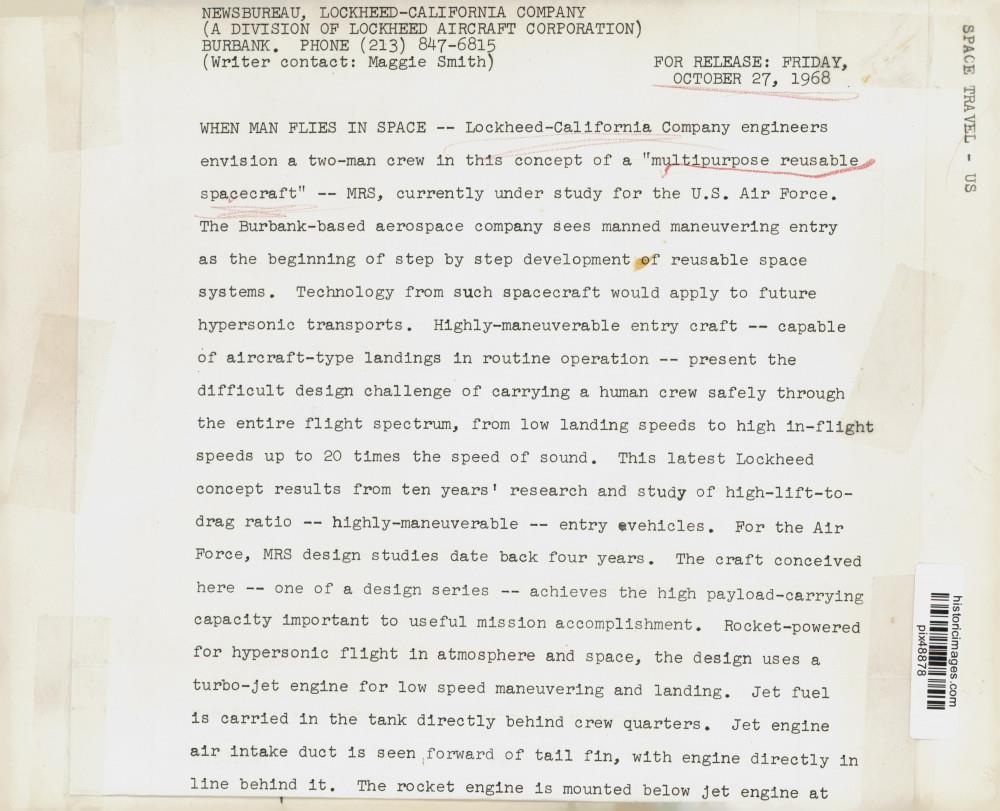
Historic Images Part Number: pix48878
1970 Press Photo Drawing of space shuttle - pix49119
This is an original press photo. Space travel - U.S. space shuttle.Photo measures 10.25 x 8.25inches. Photo is dated 01-23-1970.
PHOTO FRONT
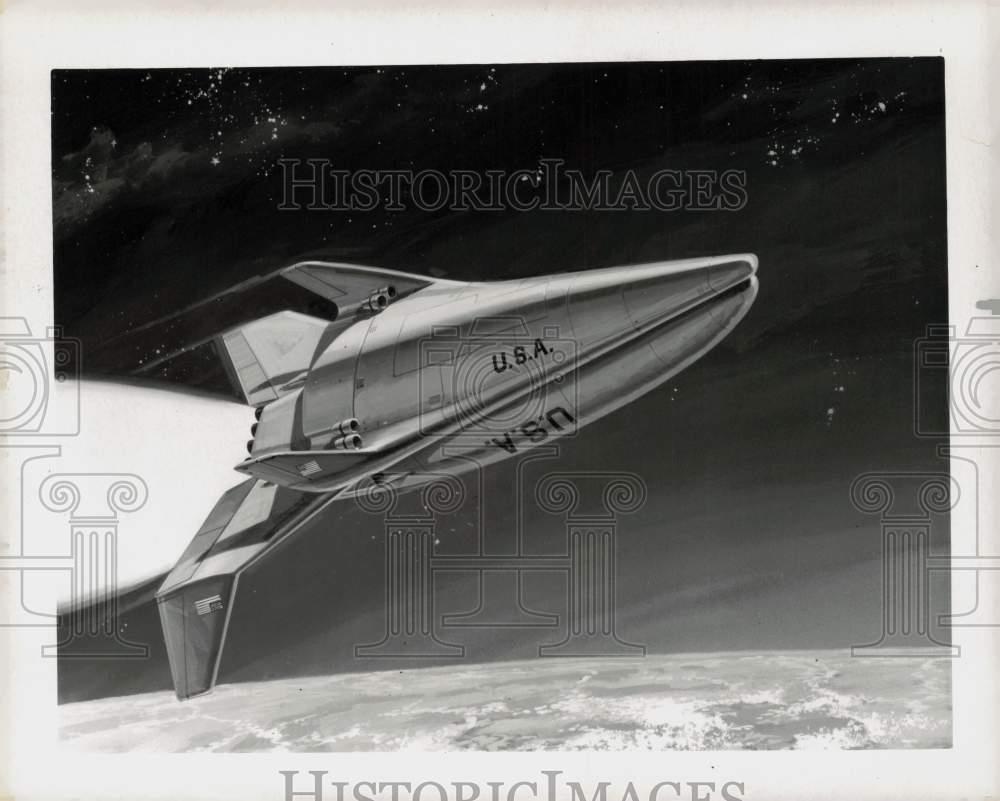
PHOTO BACK
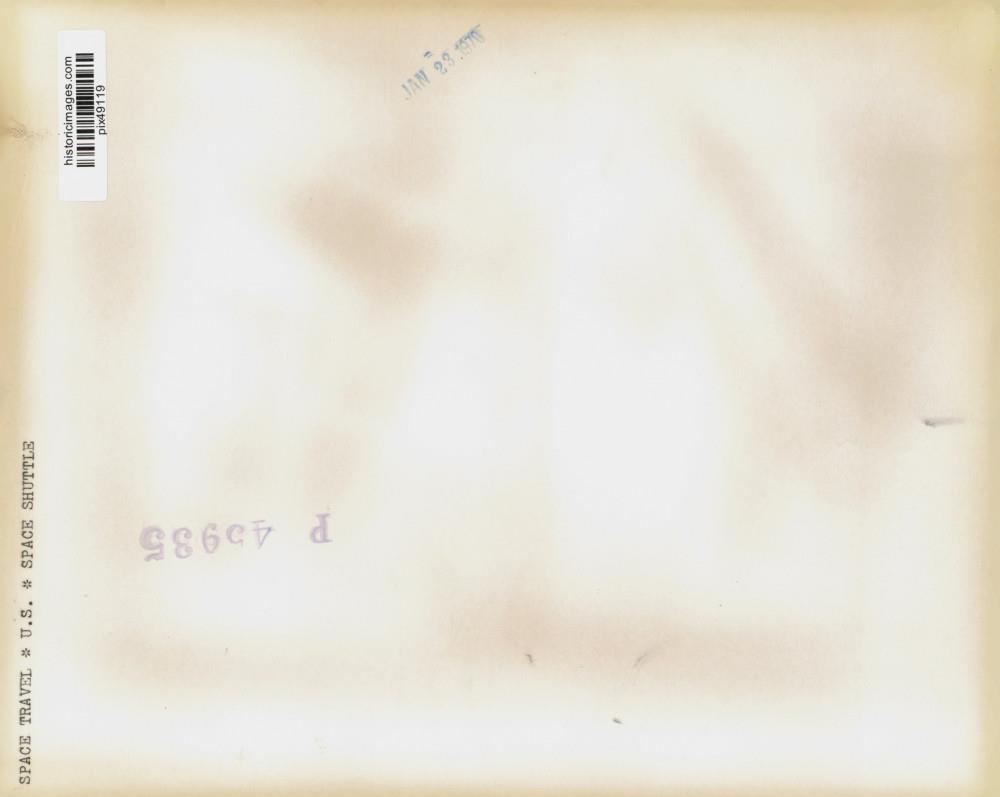
Historic Images Part Number: pix49119
Press Photo Models of reusable space shuttles - pix47919
This is an original press photo. Space Travel - U.S. - Space shuttle ---- Models show a configuration of reusable space shuttle craft being studied by a Boeing/Lockheed team. Larger model is the winged first-stage booster. Smaller model is a delta-bodied orbiter. Belly-to-belly both craft would ride up to an altitude of about 200,000 feet on the booster's rocket engines. The orbiter would then separate, ignite its own rocket engines and continue on into space carrying men and supplies. Both craft would return to earth making airplane-type landings and be ready for another space mission.Photo measures 8.25 x 10.25inches. Photo is dated --NONE.
PHOTO FRONT
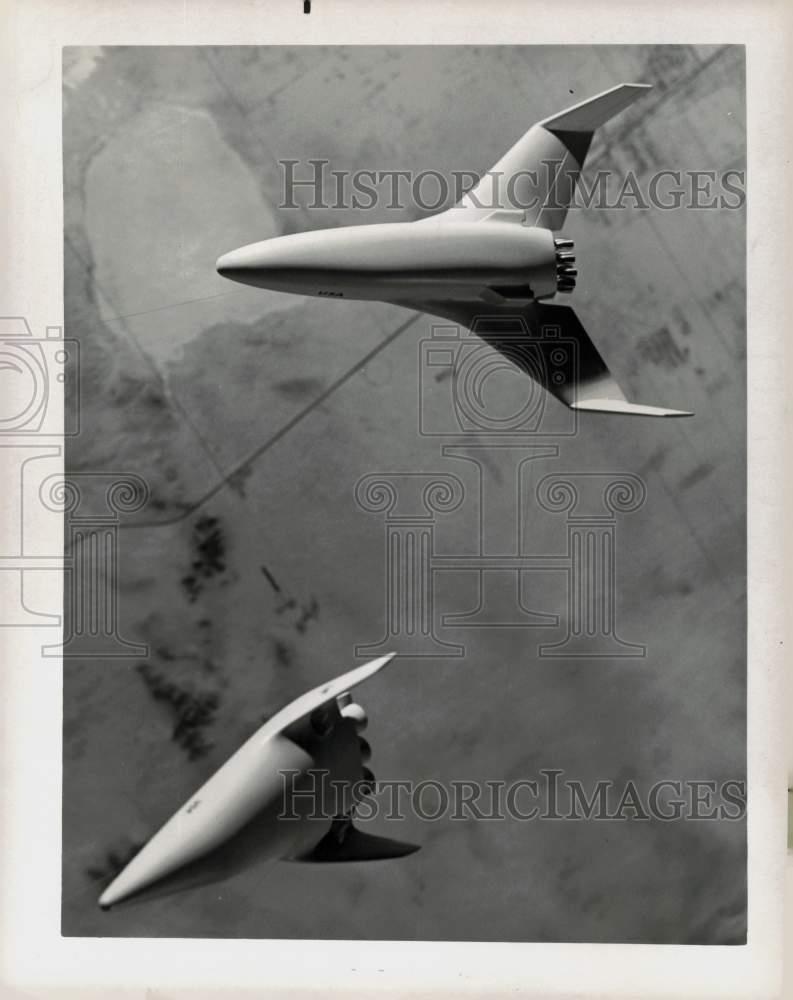
PHOTO BACK
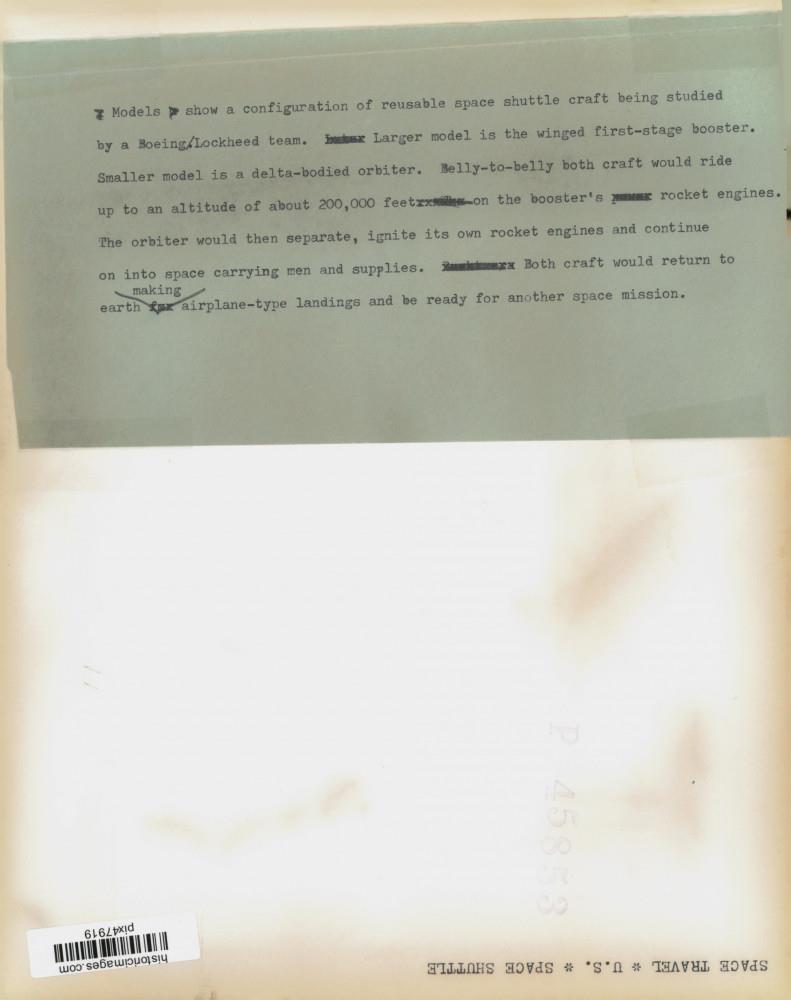
Historic Images Part Number: pix47919
1971 Press Photo Artists concept of manned piggyback space shuttles. - noa75323
1971 Press Photo Artist's drawing of space shuttle vehicles liftoff. - pix47663
This is an original press photo. Space travel - U.S. - Space shuttle (SX) ----Piggyback takeoff -- Manned space shuttle vehicles lifting off in piggyback formation from the launch pad are shown in this artist's concept. The orbiter, the passenger and cargo compartment, is mounted on the booster section, which would rocket it into space. Both vehicles would be refurbished in ground maintenance shops and reflown many times, thus greatly reducing the cost of repeated space missions - the shuttle would lower the cost of placing a pound in earth orbit from the present $1,000 to $70 or less. Manned space shuttle vehicle lifting off in piggyback formation from launch pad. Orbiter, the passenger and cargo compartment, is mounted on booster section.Photo measures 11 x 8inches. Photo is dated 09-19-1971.
PHOTO FRONT
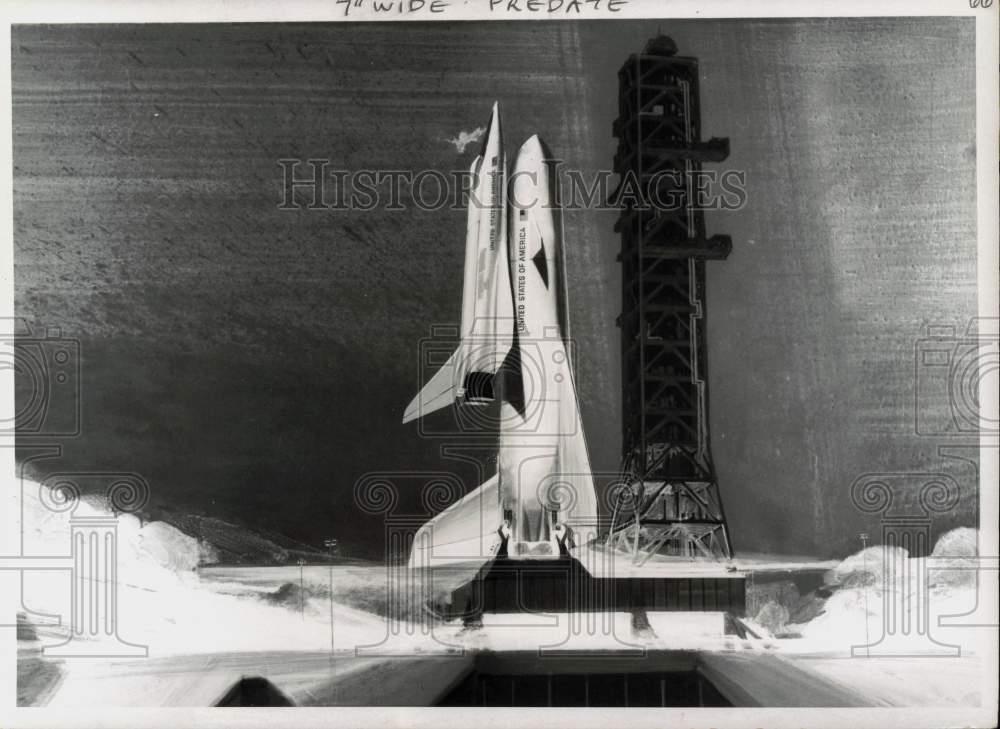
PHOTO BACK

Historic Images Part Number: pix47663
1975 Press Photo Artist's concept of city in space - pix48258
This is an original press photo. Space travel - US - Space city ---- City in space -- this is an artist's concept of a $100 billion city in space that would house 10,000 people and beam solar energy to earth. Drawing was made public Friday at Ames Research Center in Mountain View, Calif. Mirror floating above colony reflects sunlight into ..ing mirrors below, which reflect it through 100-foot strip windows into colony's interior for light and agriculture. The wheel-like colony would be over a mile in diameter. Long rectangle in foreground is heat radiator ... lower central sphere is original "construction shack" for colony. Sun, earth and moon are in background.Photo measures 10 x 8.25inches. Photo is dated 08-22-1975.
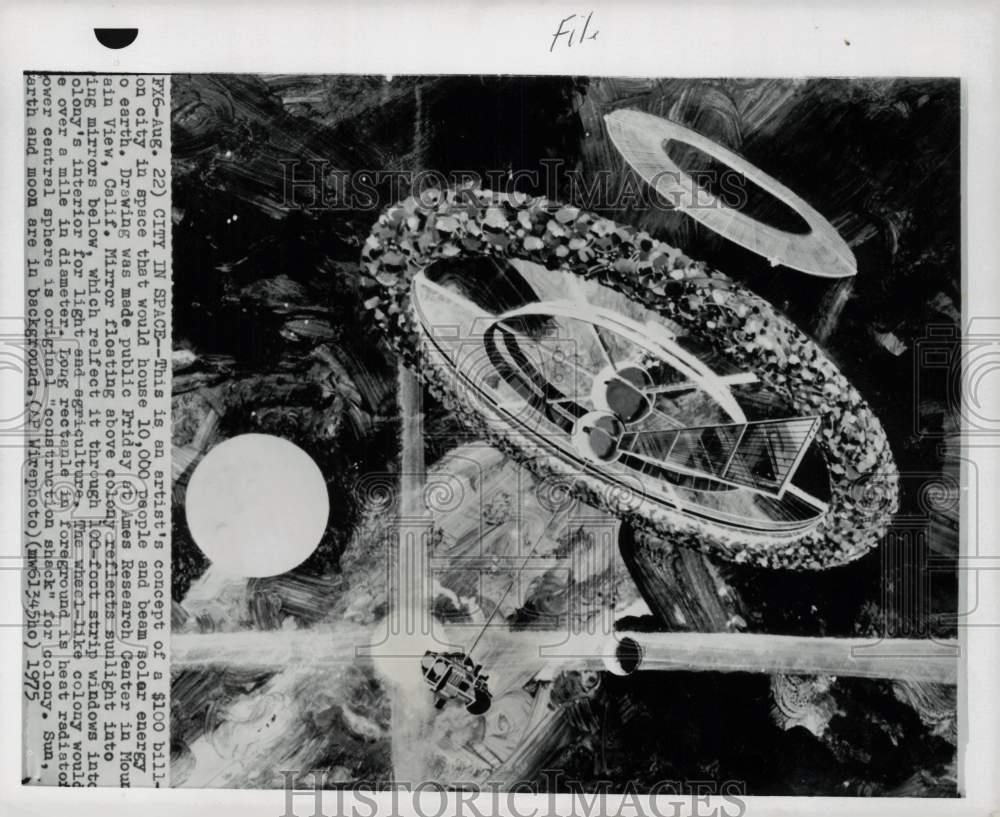
PHOTO BACK
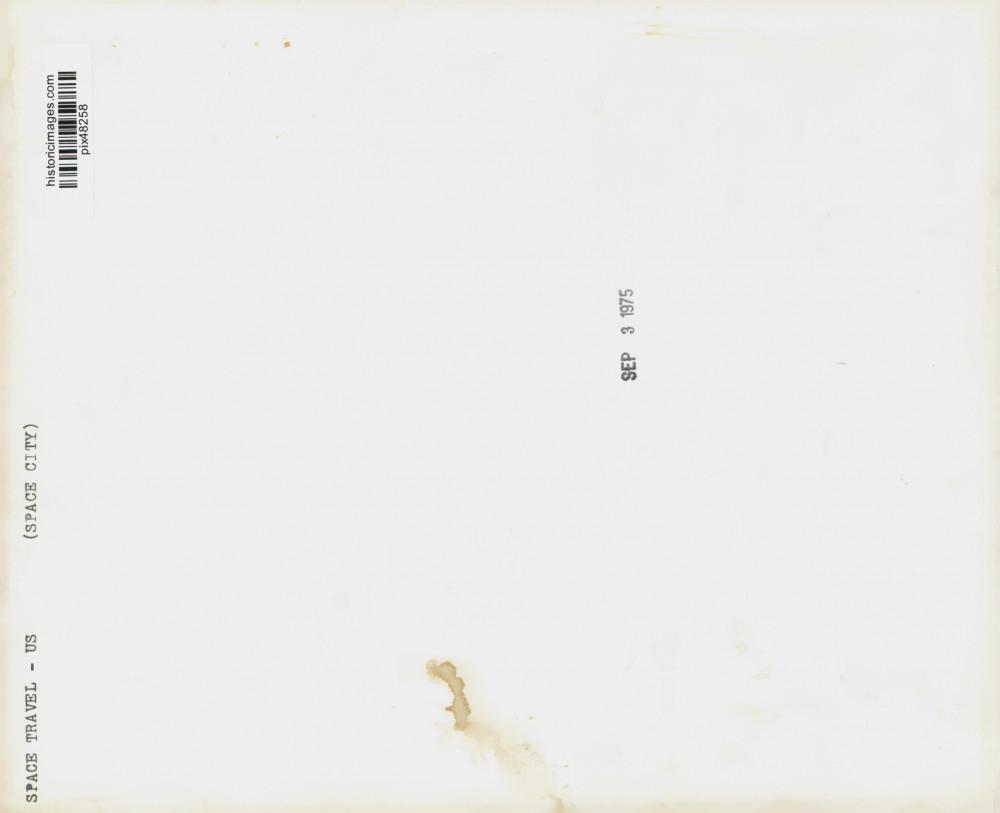
Historic Images Part Number: pix48258
1975 Press Photo Illustration of a Space Colony Bridge - sax19428
Photo is dated 10-31-1975.
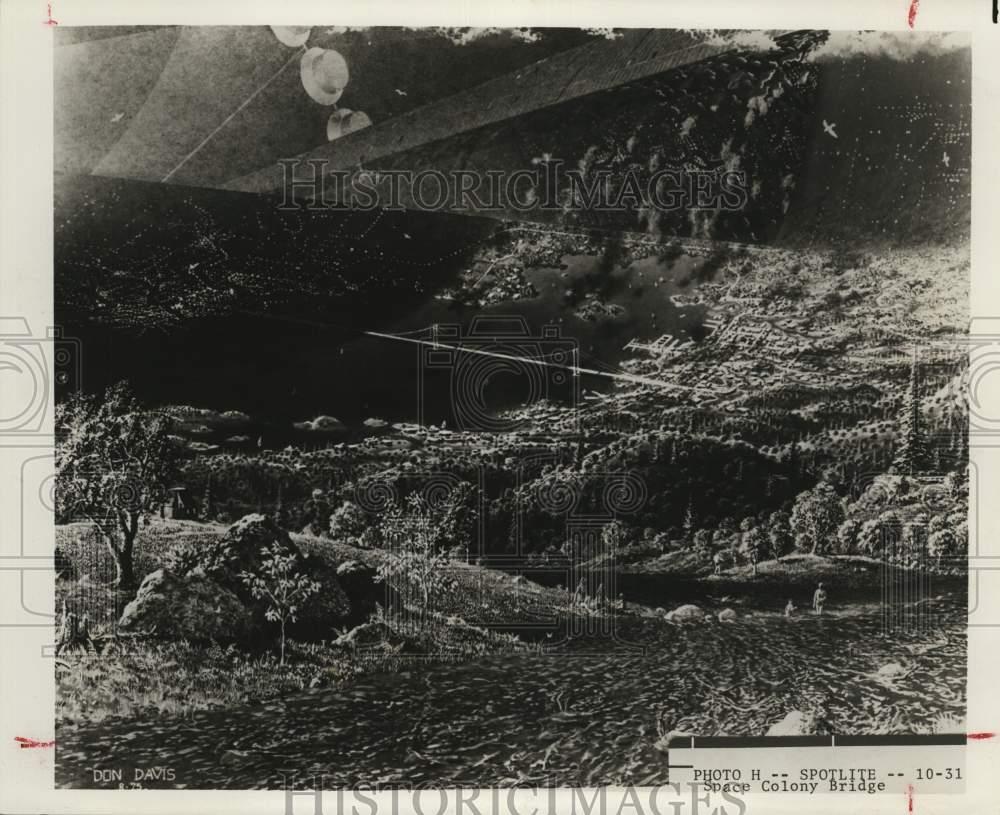
PHOTO BACK

Historic Images Part Number: sax19428
1976 Press Photo Artist's Rendition of Space Colony, Interior - mjsp00953
This is an original press photo. This is an artist's concept of the interior of a huge space colony. Stationed a quarter of a million miles from Earth and constructed almost entirely of ore mined from the Moon, the colony would contain a population of 10,000 people. They would live and work in an Earth-like environment inside a vast wheel more than a mile in diameter. Trees, grassy parks, birds -- even streams and ponds will help give a familiar setting for the colony's population. Beneath the upper living area is a level of offices, stores, service buildings, and facilities for light industry. Screened from harmful cosmic rays by the overhead chevron mirrors, the colonizers would enjoy unlimited sunlight. Those sections of the colony devoted to intensive agricultural use would make use of the sunlight to supply the total food requirements for the colony. Space may become home, someday. Here, an artist has conceptualized what a huge space colony, stationed a quarter of a million miles from Earth, might look like inside. Trees, ponds, birds, and of course, people would exist inside a vast wheel more than a mile in diameter and constructed almost entirely of ore mined from the moon. Space, U.S., space stations. Photo measures 10 x 8 inches. Photo is dated 08-06-1976.
PHOTO FRONT

PHOTO BACK
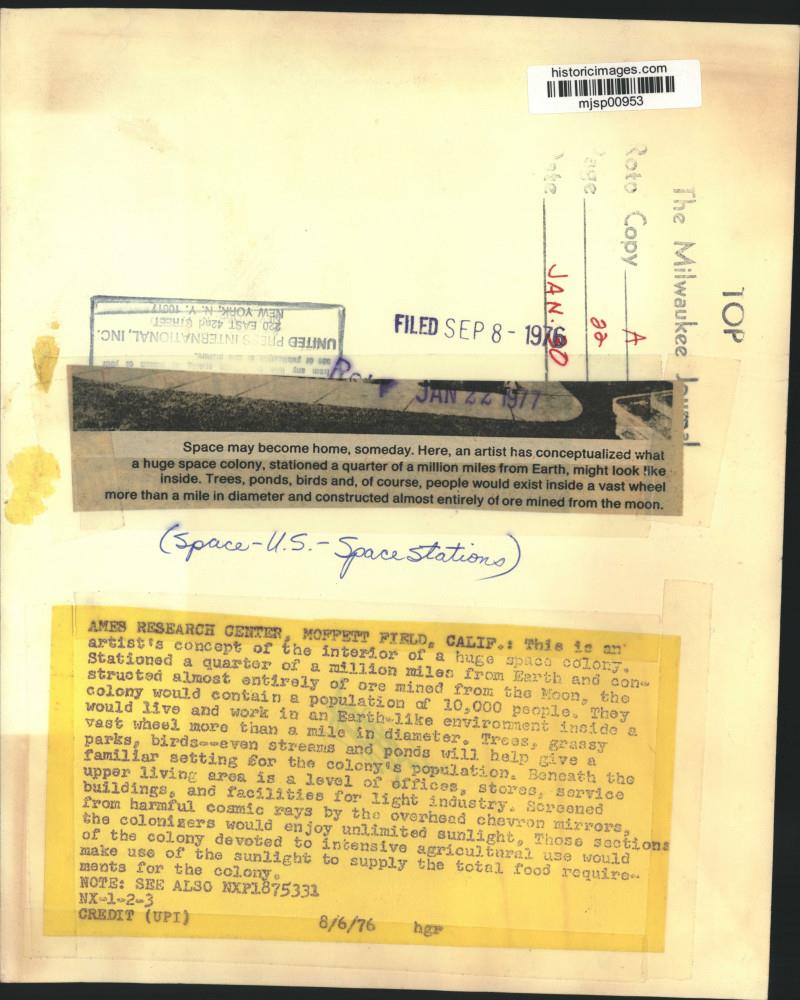
Historic Images Part Number: mjsp00953
1977 Press Photo Artist's conception of a solar energy producing space station
From power to golf, many things are envisioned for an orbiting space station such as shown in this artist's conception. The wheel-shaped colony would accommodate 10,000 persons while reflecting solar energy to the Earth. Space - U.S. - Space Stations. Photo is dated 01-06-1977.
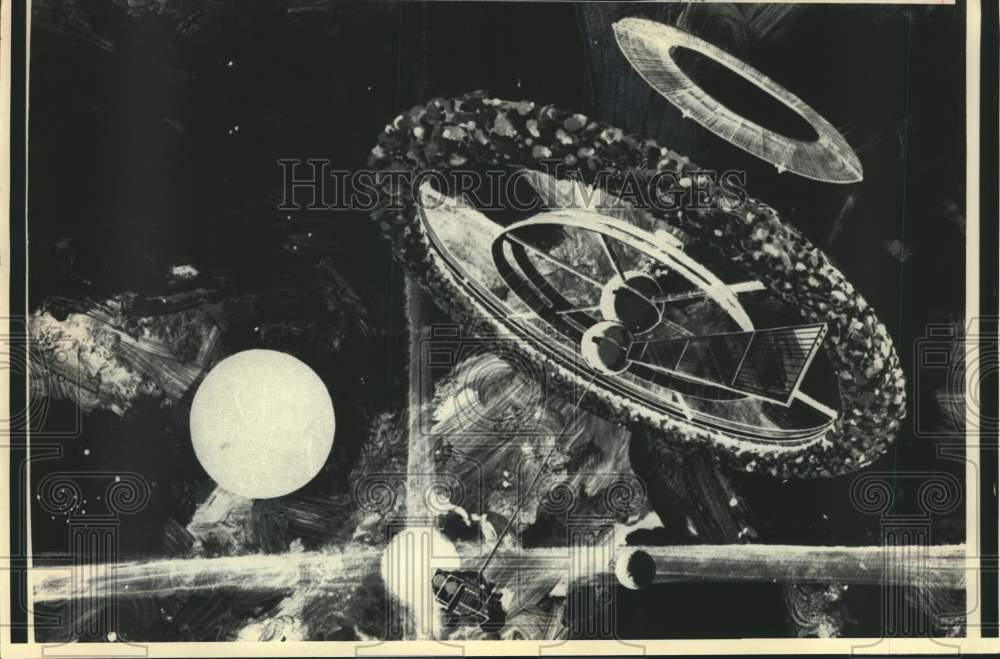
PHOTO BACK
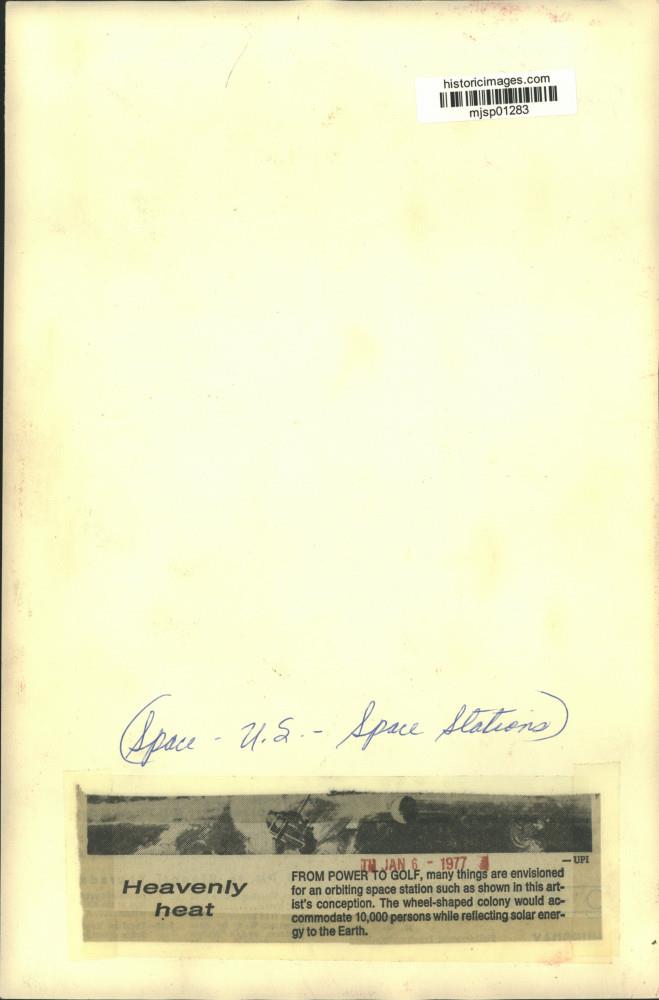
Historic Images Part Number: mjsp01283
Press Photo Space colony image - sax18904
Space colony image Photo measures 8 x 10.25 inches. Photo is dated 11-18-none.
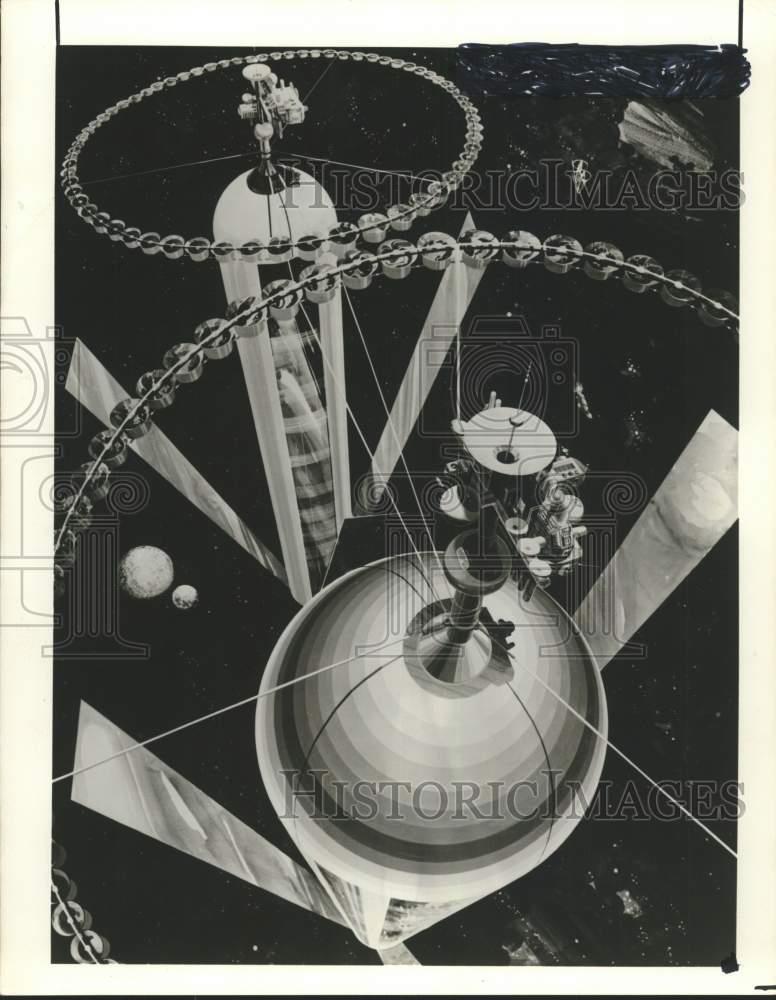
PHOTO BACK
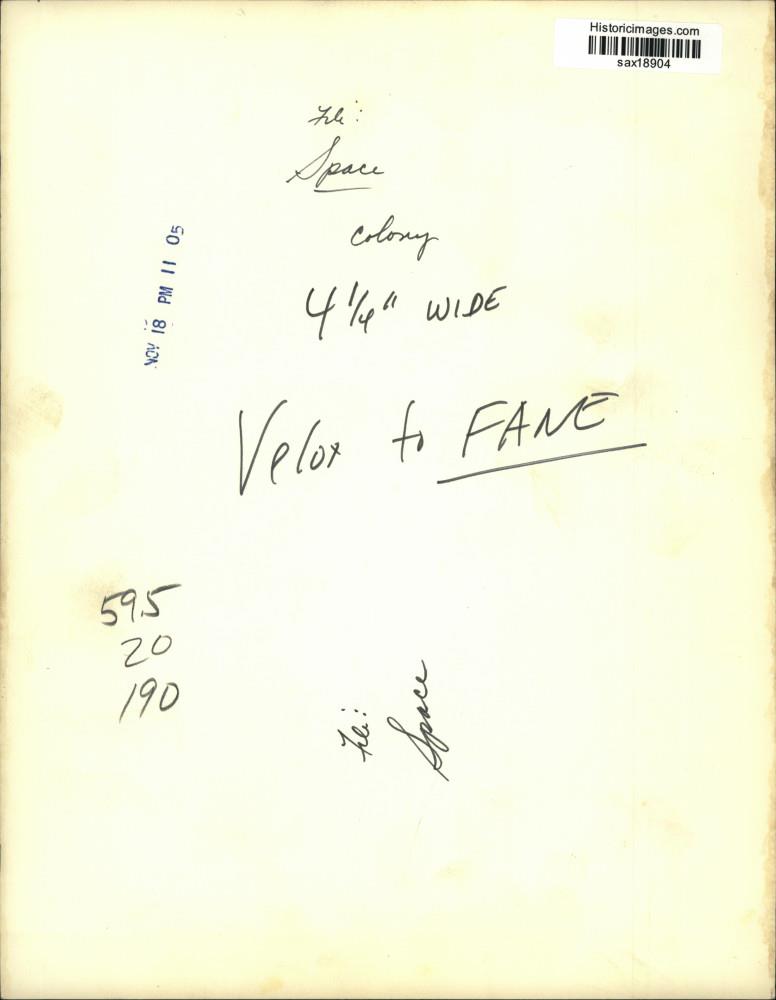
Historic Images Part Number: sax18904
1978 Press Photo Russian artist's depiction of a Soviet Space Liner - pix47686
Space travel - Russia - Futuristic space liners ---- This look into the future through the eyes of a Russian artist depicts a Soviet space liner hurtling from earth. The mission depicted here is peaceful, but with the increased importance of space, weapons and sophisticated spy devices are being tested and make operational by both the major powers.Photo measures 8 x 10inches. Photo is dated 03-19-1978.
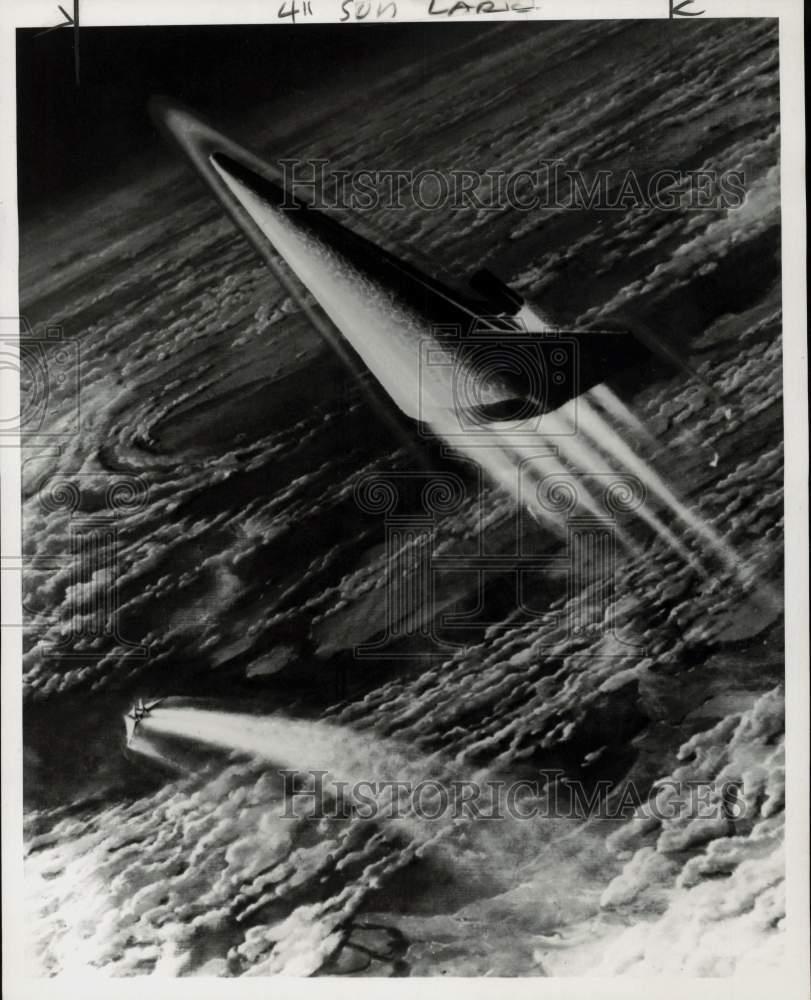
PHOTO BACK
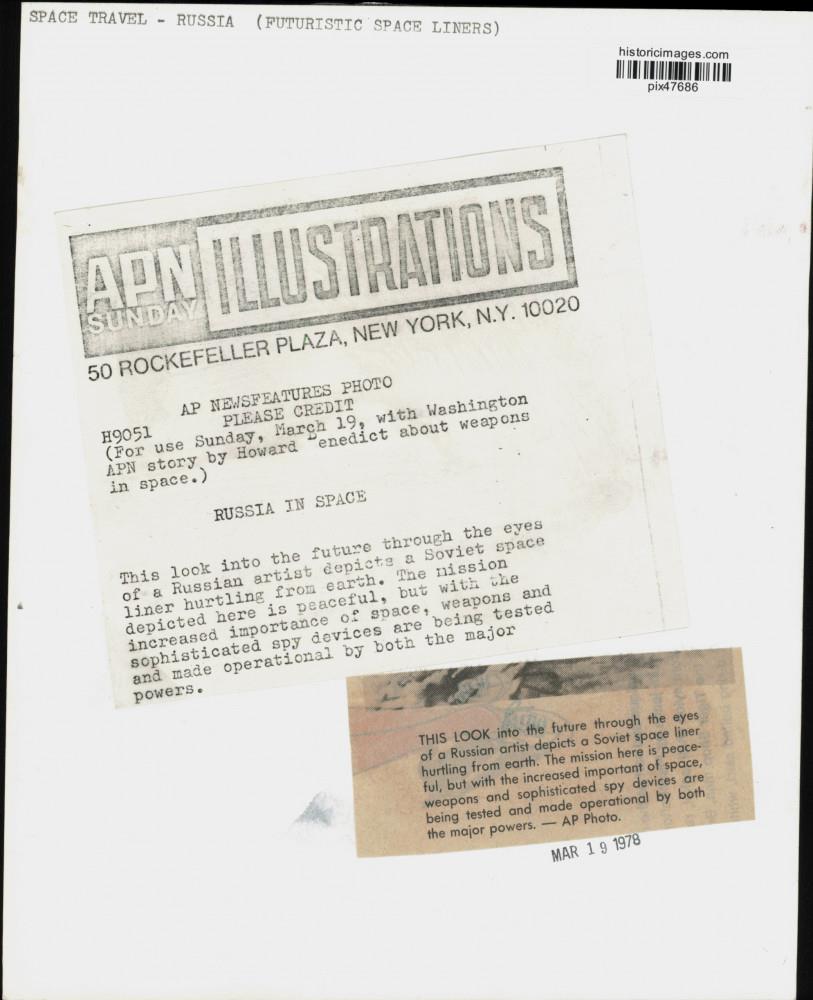
Historic Images Part Number: pix47686
1985 Press Photo The space station - cva78503
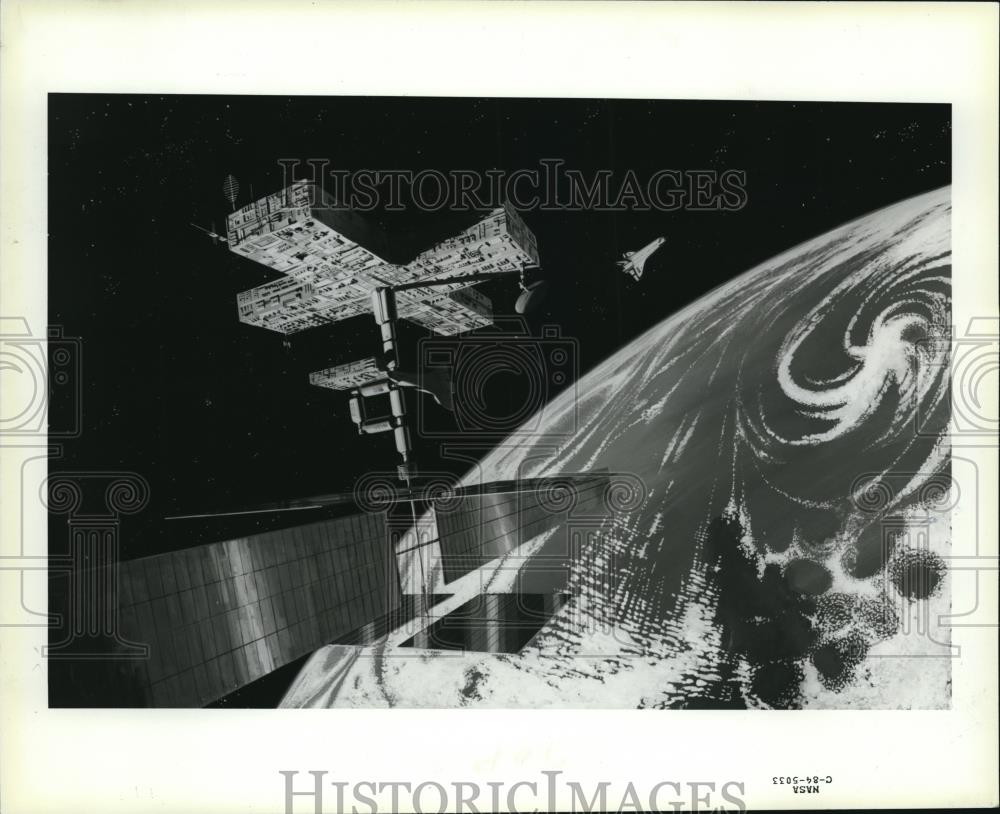
Historic Images Part Number: cva78503
1986 Press Photo "The Mars Base" by Artist Robert T. McCall - lrp99152
"The Mars Base" - Nationally renowned artist Robert T. McCall's painting of the Mars base, as envisioned by The National Commission on Space. Courtesy of Bantam Books, copyright 1986. "The Great Space Race," a four-part PBS series made possible by a grant from The Boeing Company. TV Show Photo measures 10 x 8 inches. Photo Is dated 1986.
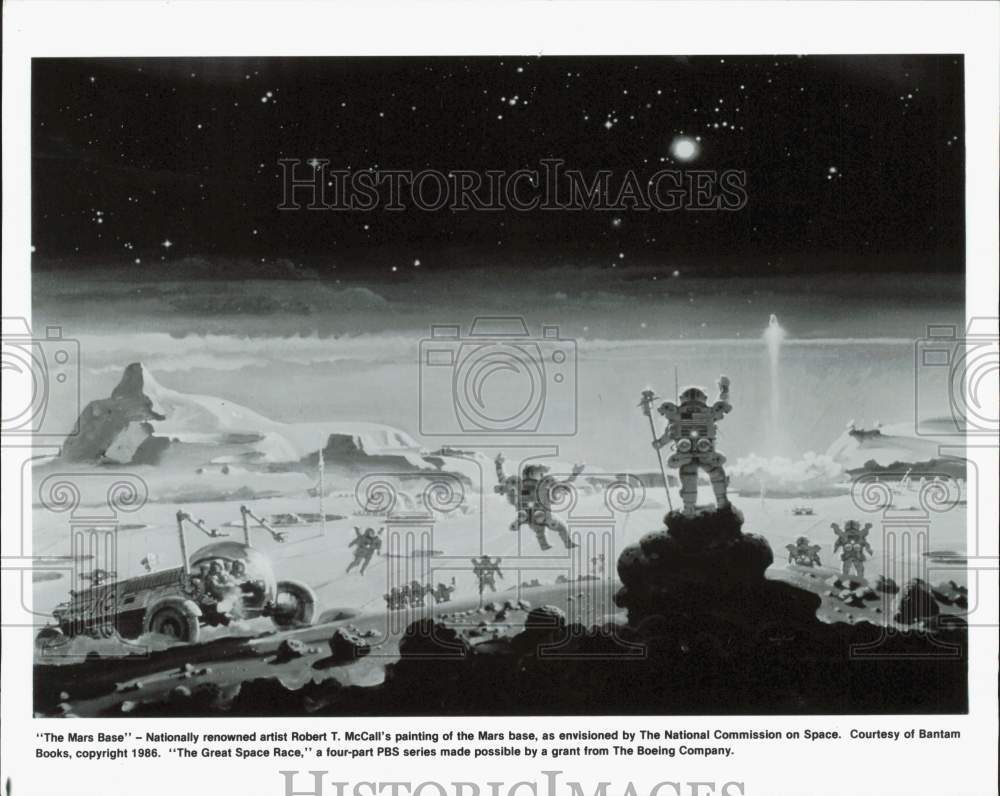
PHOTO BACK

Historic Images Part Number: lrp99152
1986 Press Photo This mock-up of a combination spacecraft/airplane - mja02756
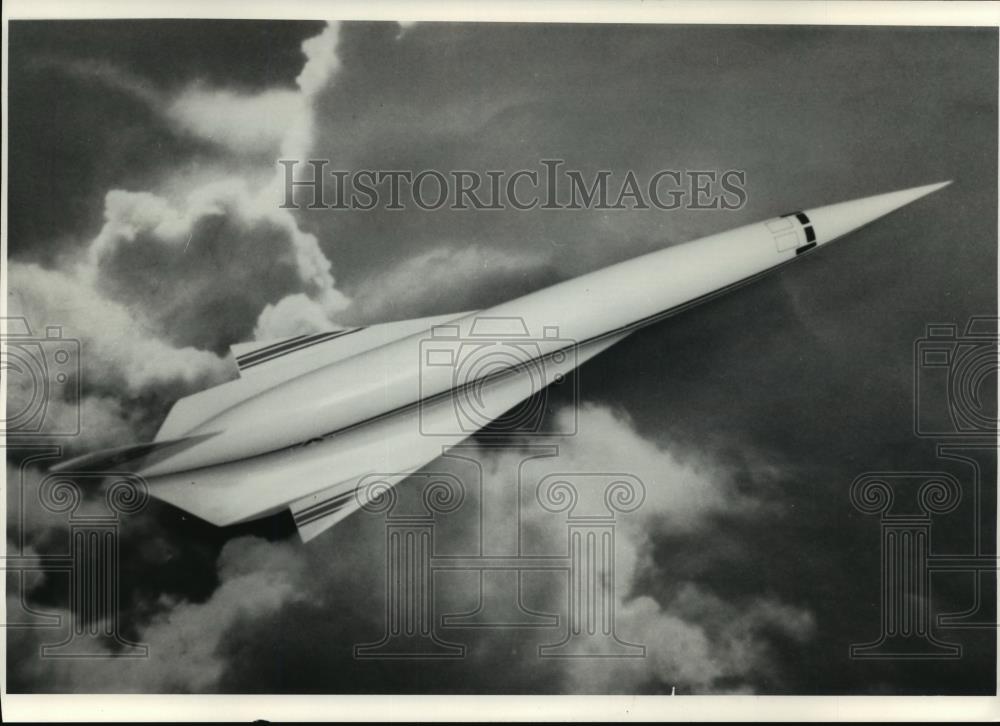
PHOTO BACK
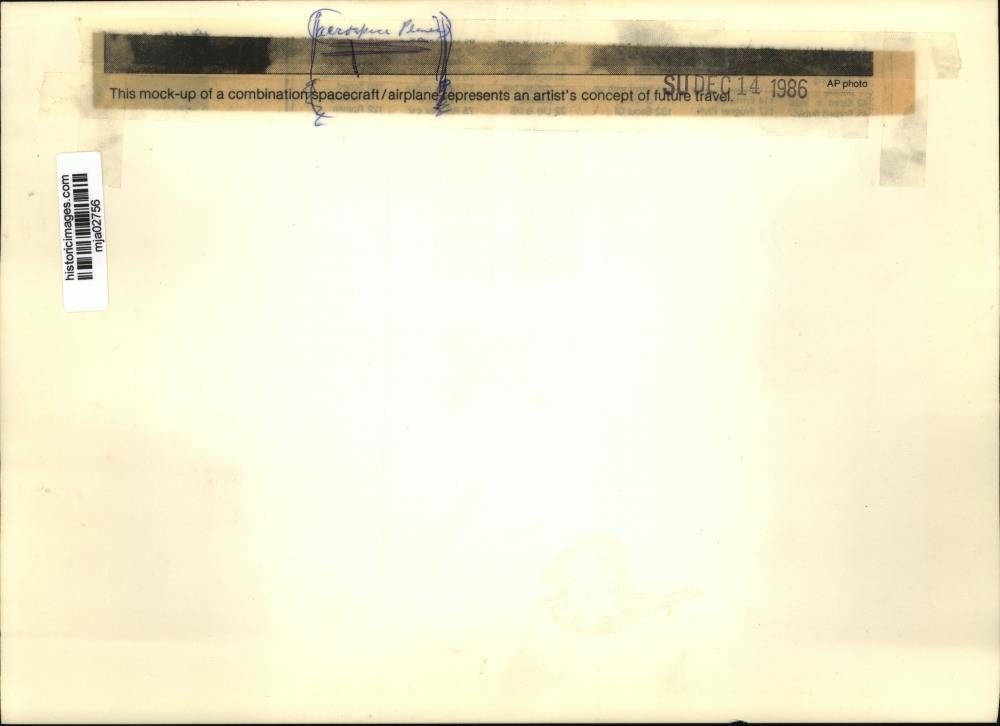
[click an image above to see a larger version]
Historic Images Part Number: mja02756
1989 Press Photo The Space Station Plan - cva79639
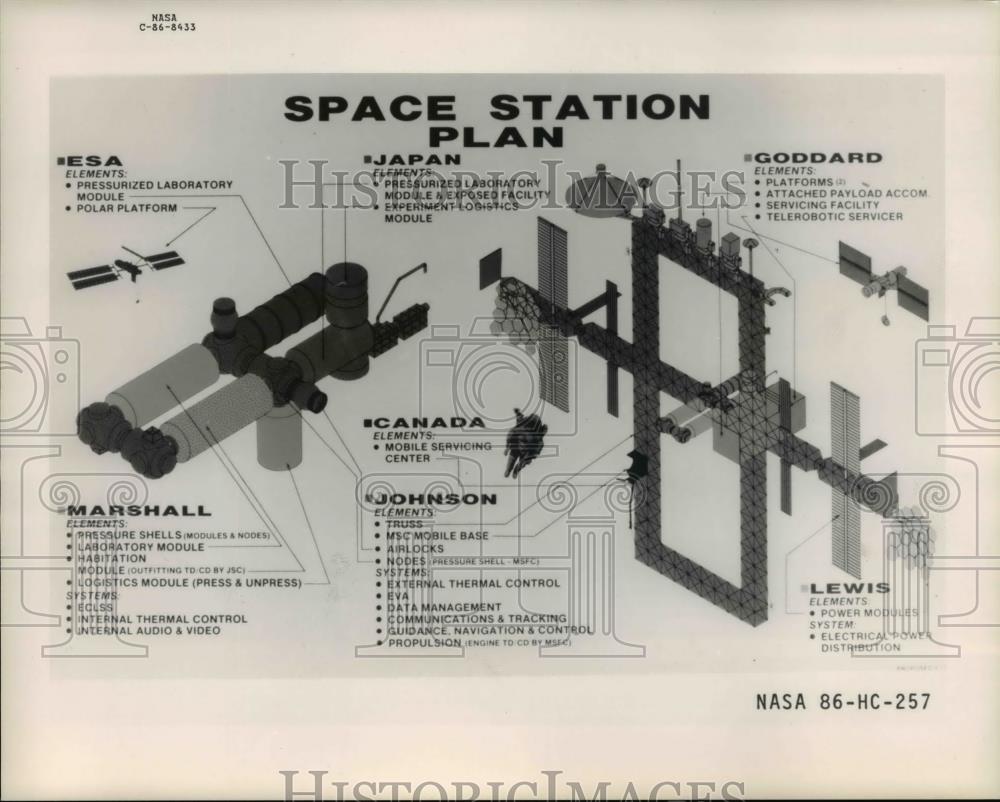
Historic Images Part Number: cva79639
1989 Press Photo Former astronaut Buzz Aldrin talks about space station Starport
Former astronaut Edwin "Buzz" Aldrin talks about plans for space stations. Buzz Aldrin with a model of Starport built by University of Houston architecture students. Houston, Texas Photo measures 10 x 8 inches. Photo is dated 06-28-1989.
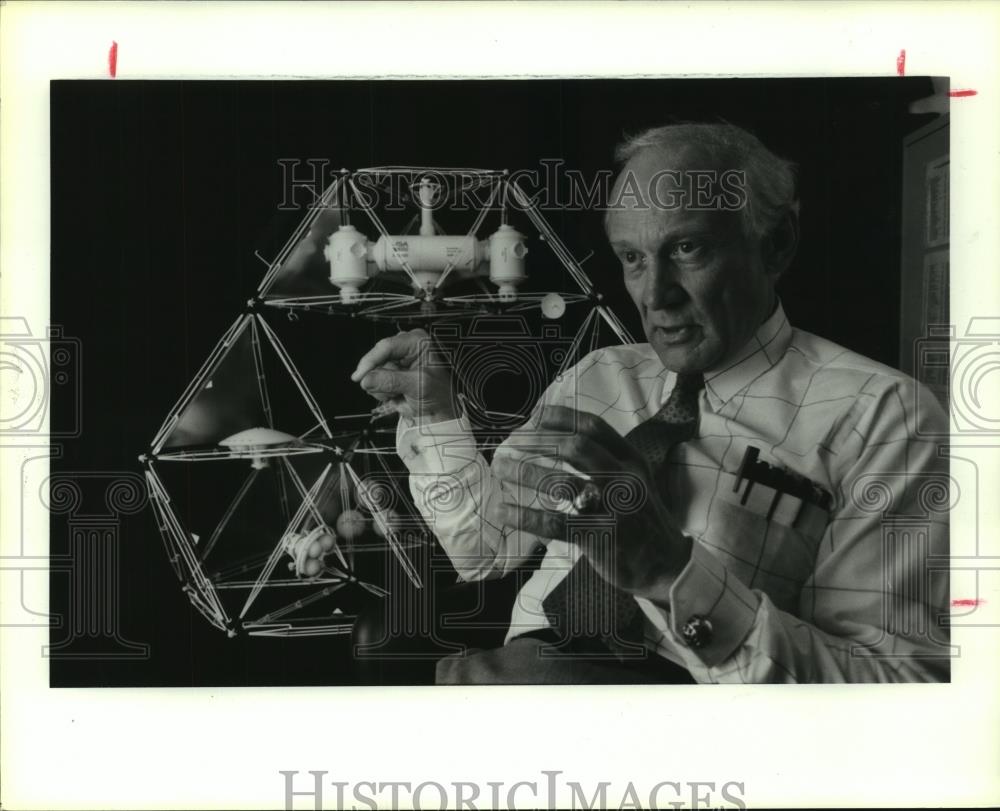
PHOTO BACK
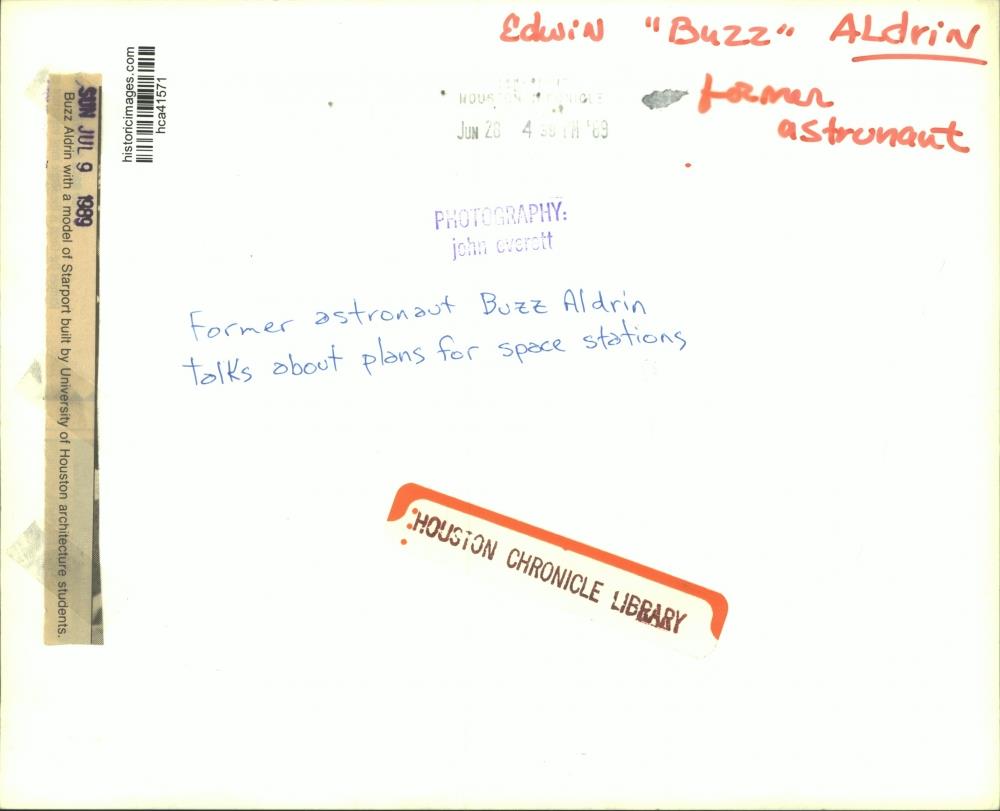
Historic Images Part Number: hca41571
Press Photo Futuristic space station - orb92063
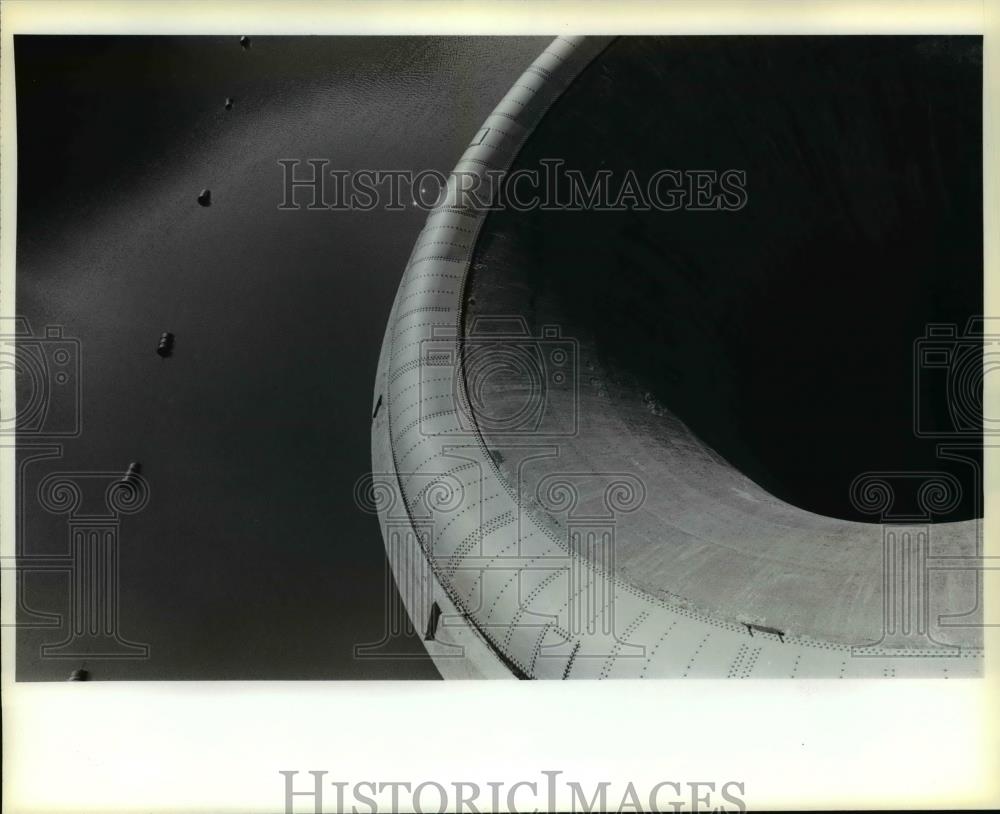
Historic Images Part Number: orb92063
1981 Press Photo Artist's concept of Aircraft for NASA-U.S. Air Force Project
This is an original press photo. This is an artist's concept of the HiMAT (Highly Maneuverable Aircraft Technology) aircraft in flight. Built by the Rockwell International Corp's Los Angeles Aircraft Div., the craft will enter the research flight test phase this year over the Mojave Desert at NASA's Dryden Flight Research Center. HiMAT blends the latest aeronautics technology from research laboratories into a flight research vehicle to demonstrate advanced technologies for potential use in air-superiority fighter concepts of 1980's. The project is a joint NASA-U.S. Air Force effort. Two HiMAT 0.44 scale flight research vehicles have been built by Rockwell. Photo measures 10 x 8 inches. Photo is dated 08-13-1981.
Part Number: lrx61183
1987 Press Photo Artist's concept of the Advanced Tactical fighter plane
Airplanes - stealth (Advance Tactical Fighter). An artist's conception of the high-tech Advanced Tactical Fighter Photo measures 10 x 8.25 inches. Photo is dated 4-3-1987.
Part Number: pim09842
#spacecraftconceptsdesigns Jul 14, 2016-07-14
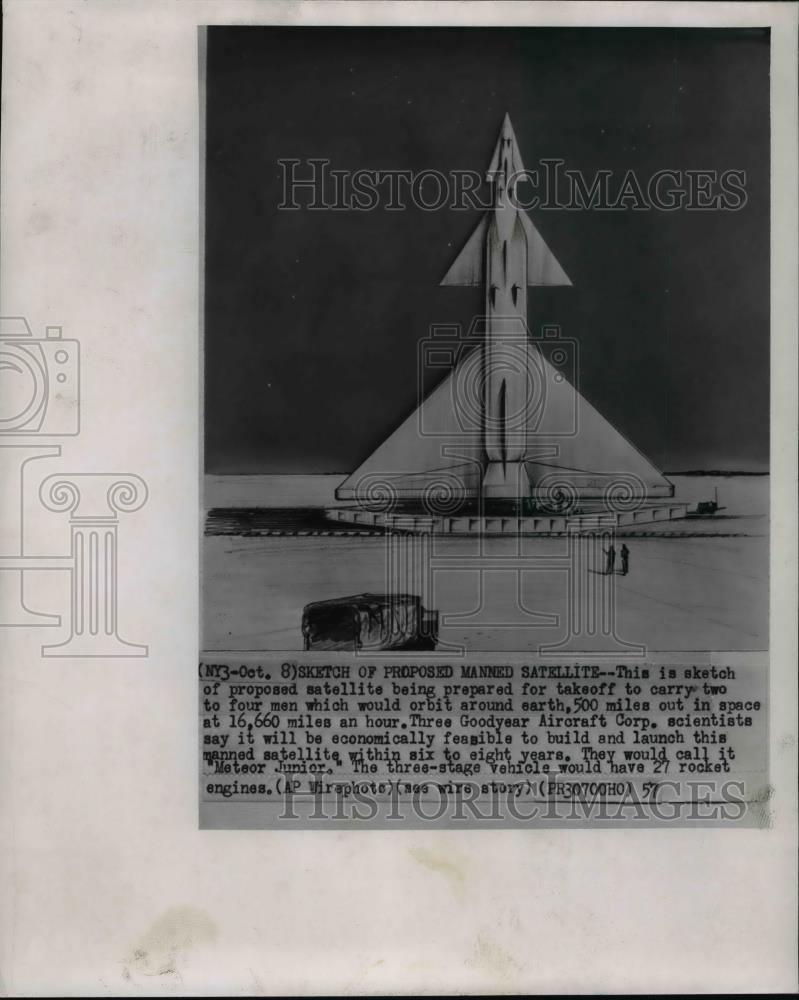
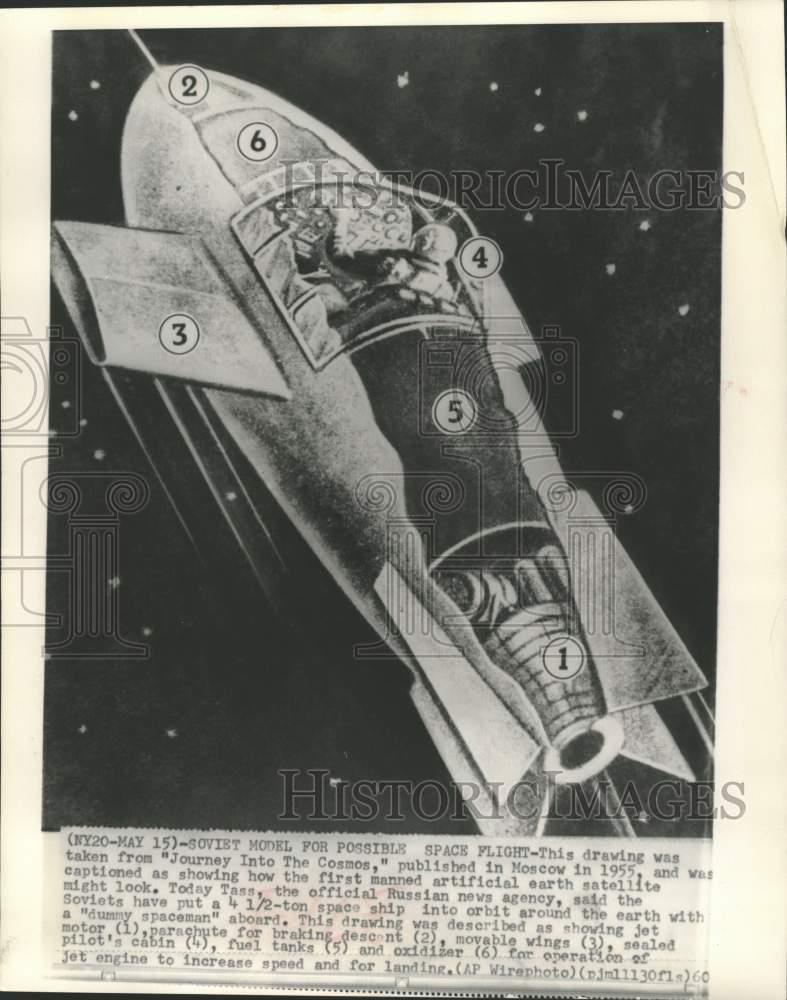
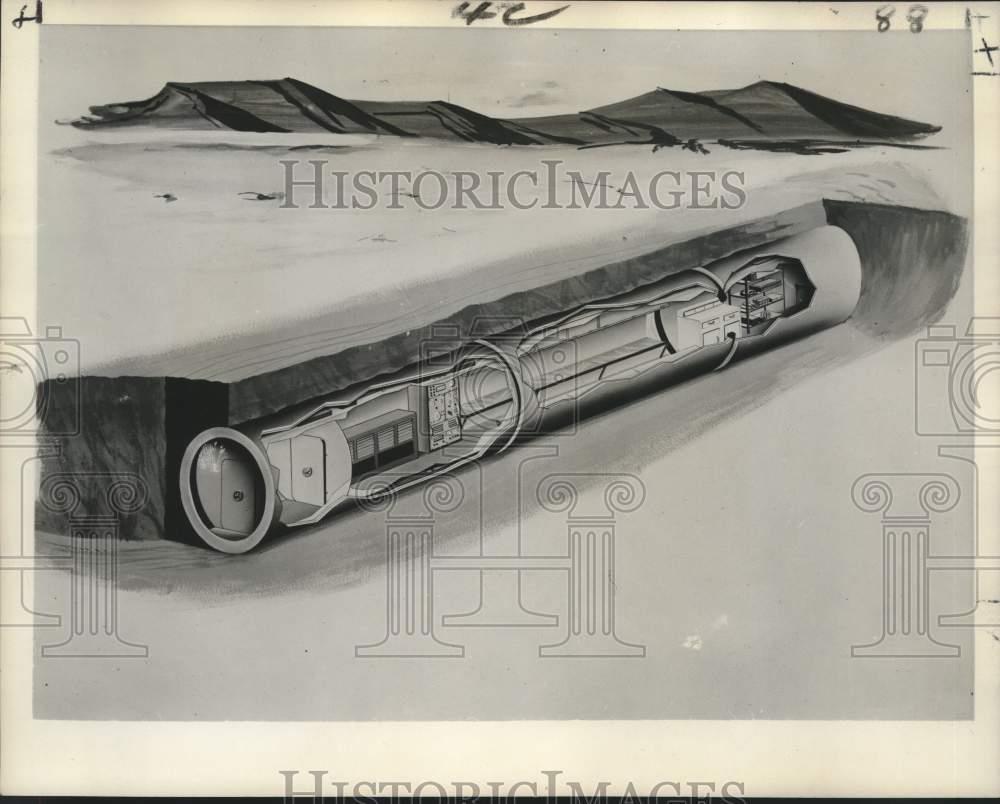
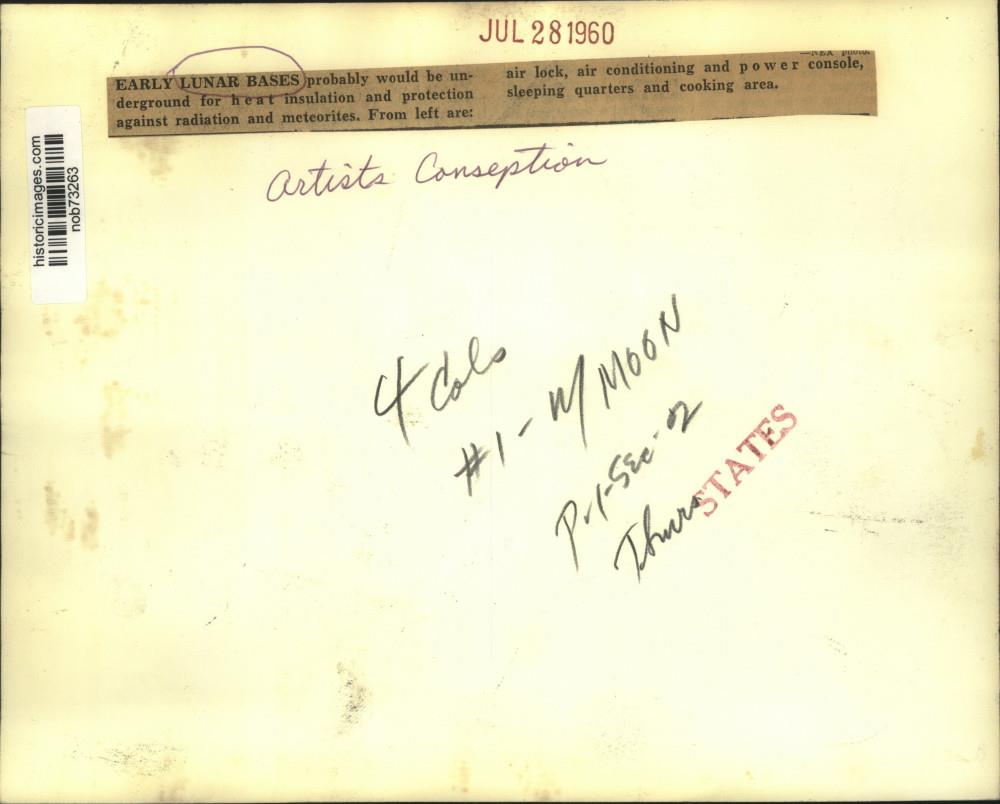
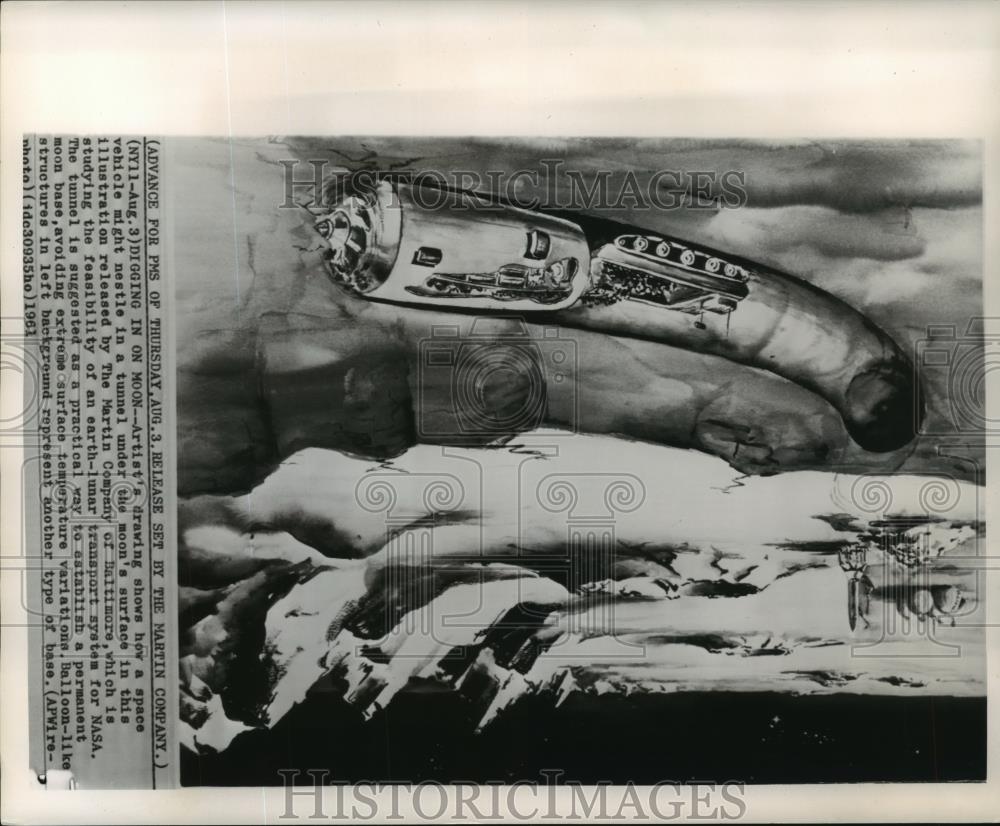
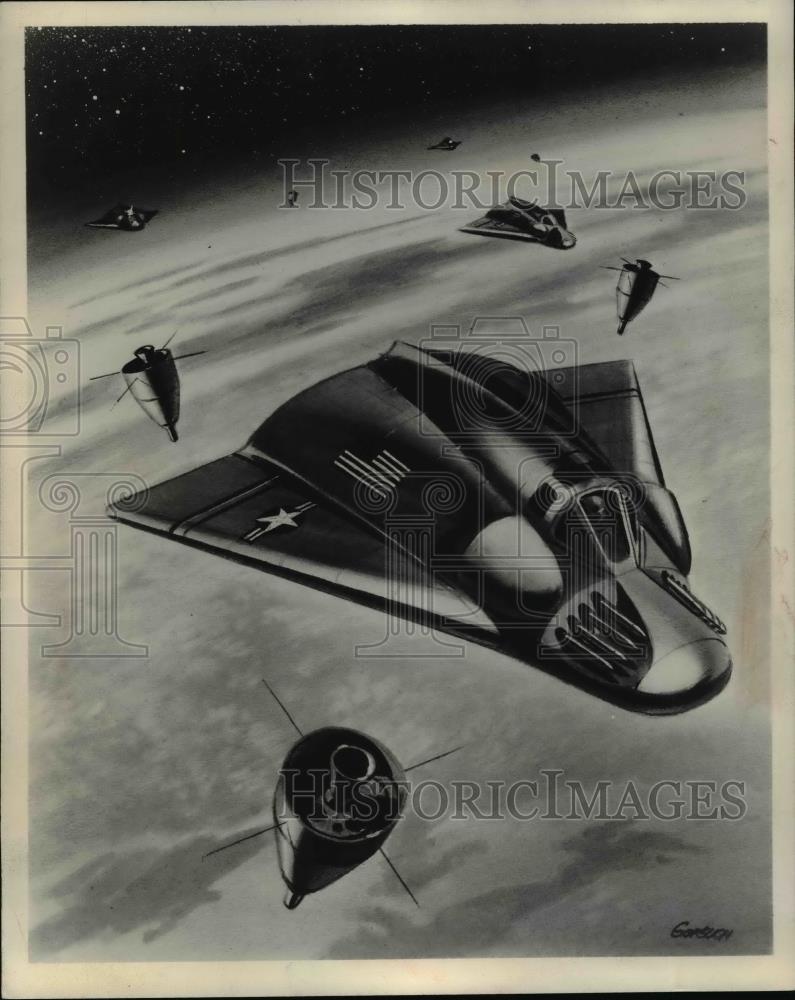
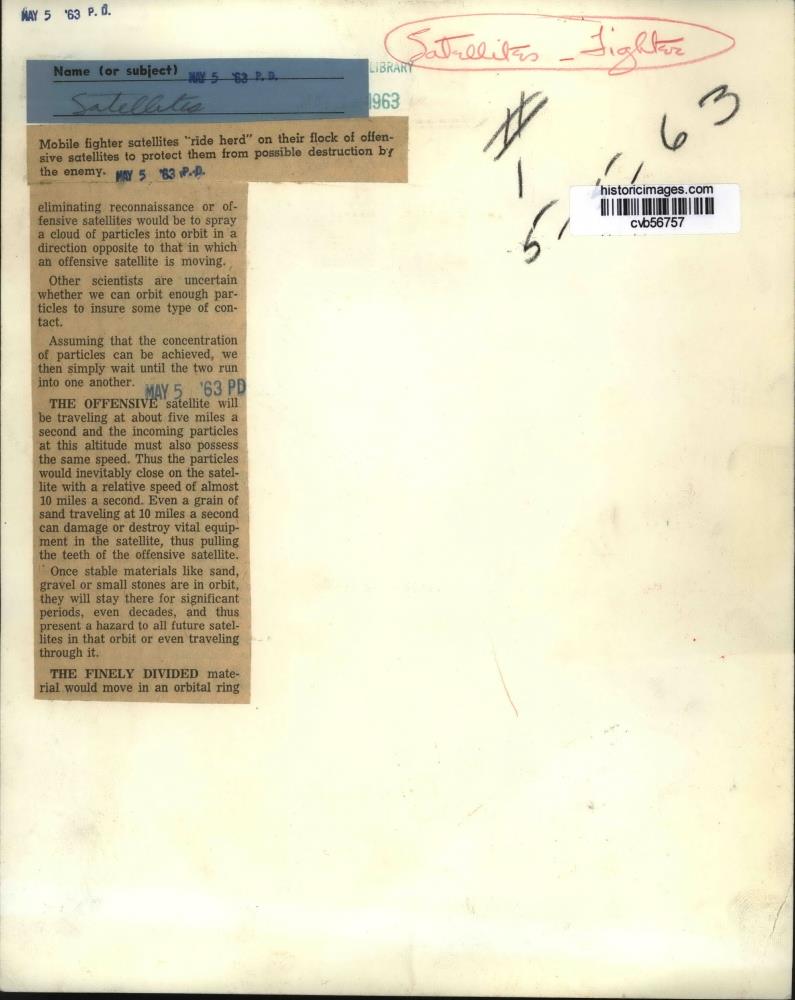
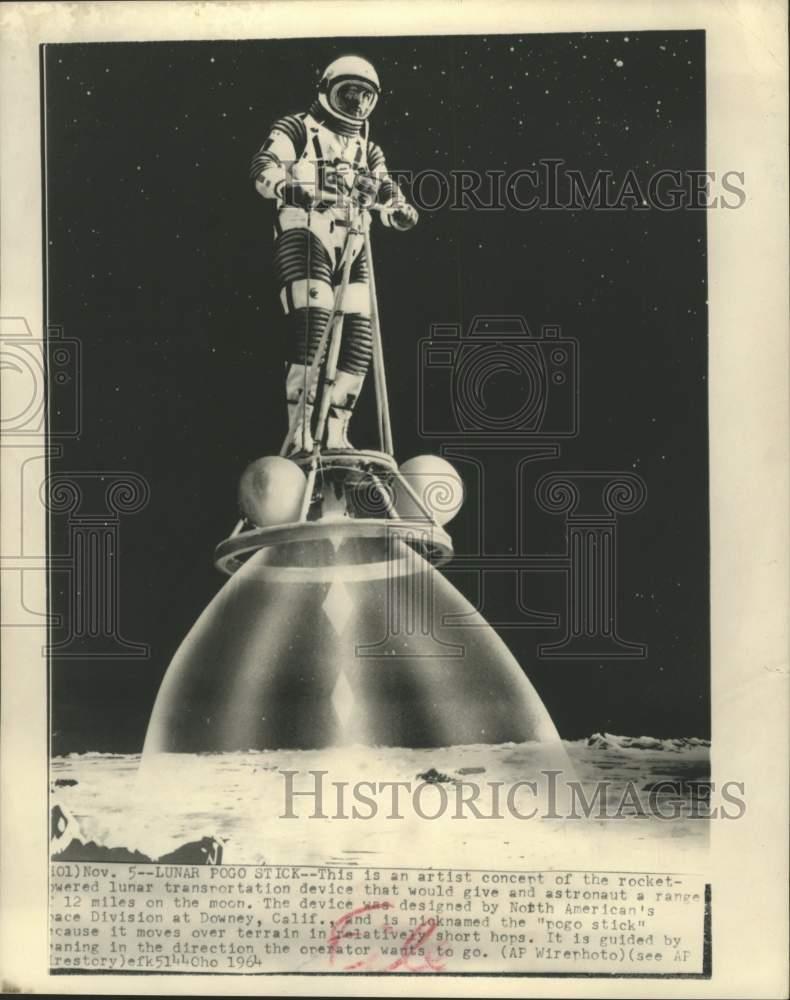
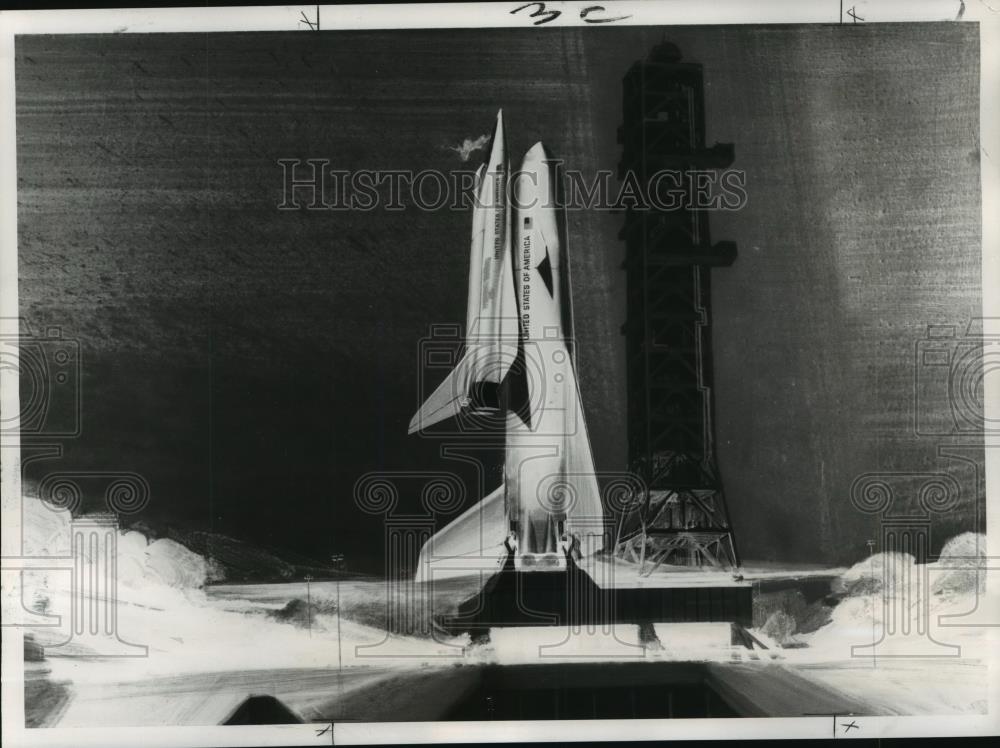
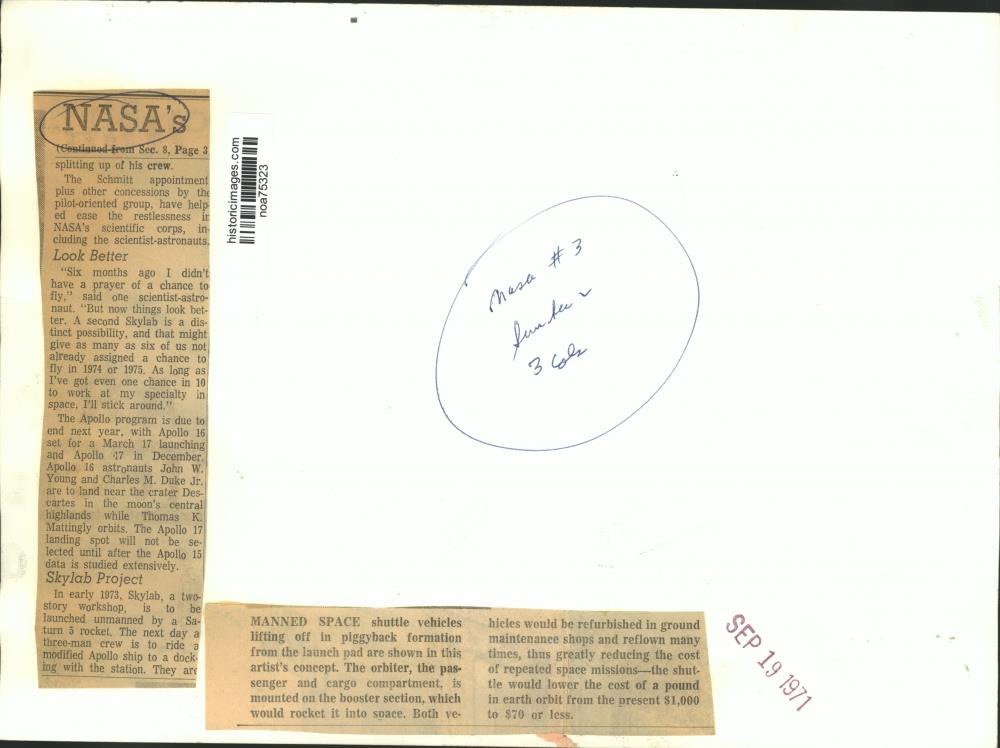
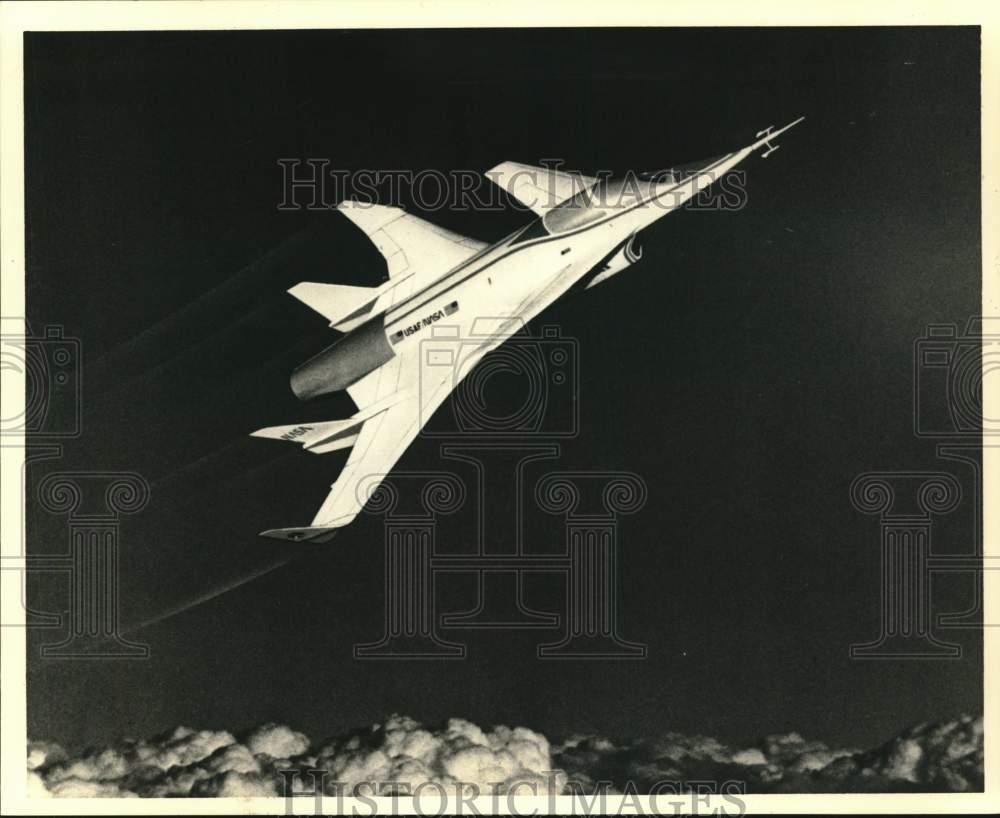
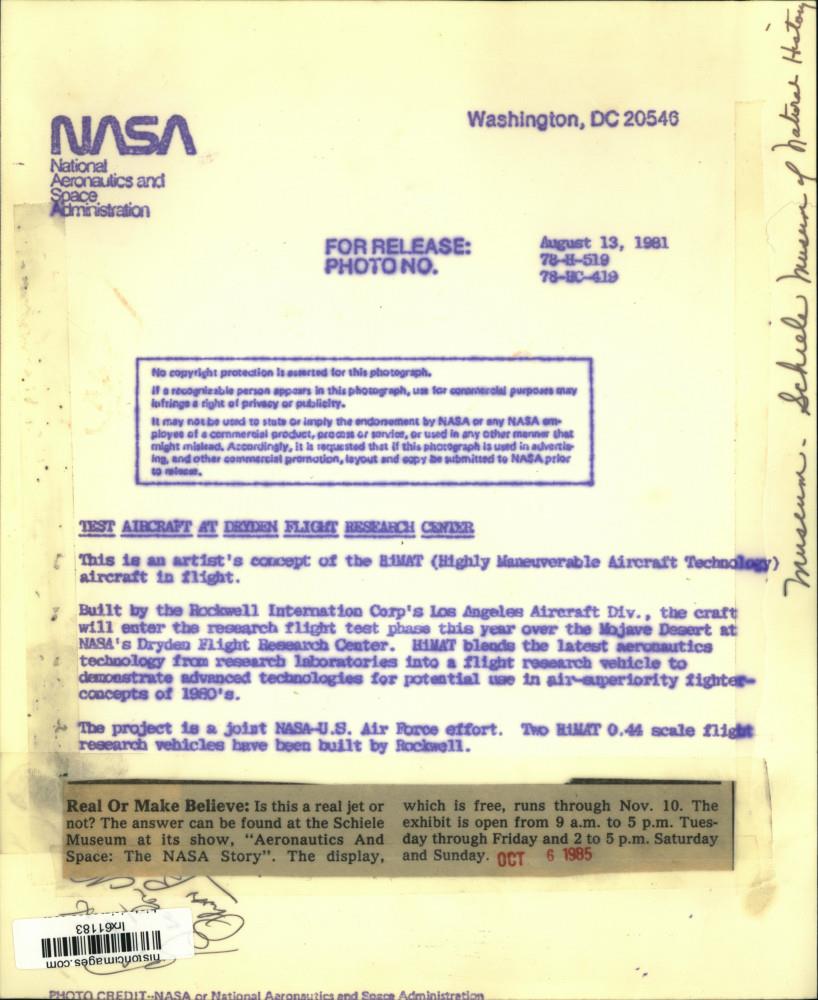
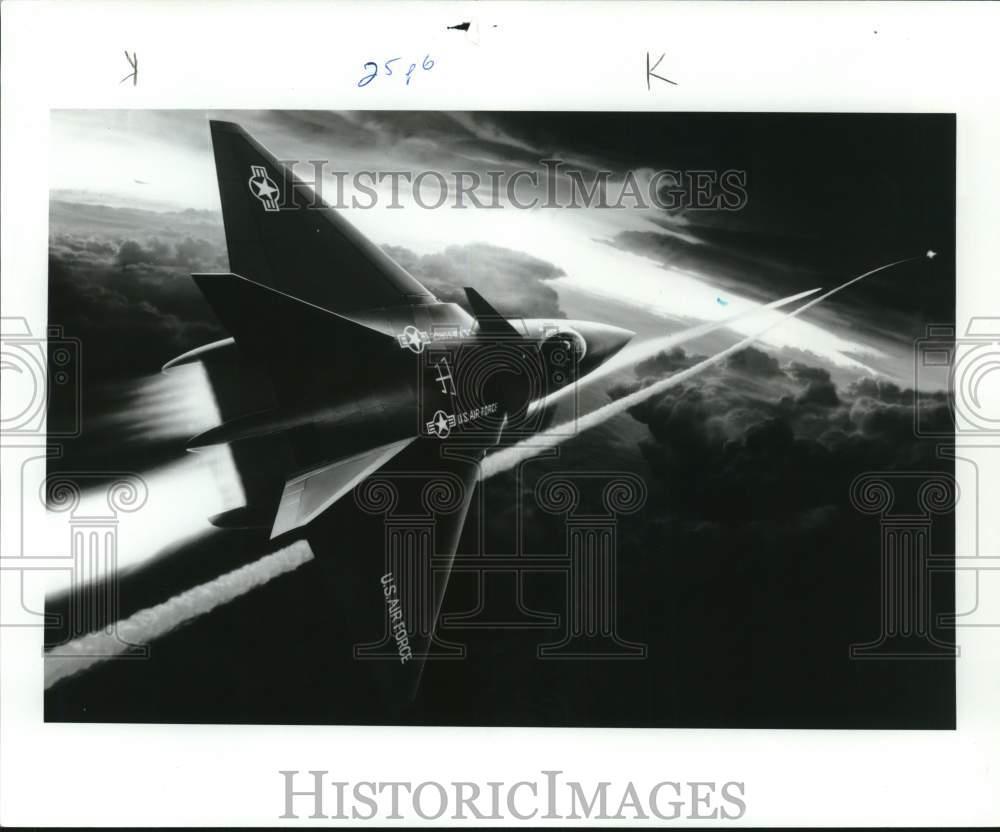
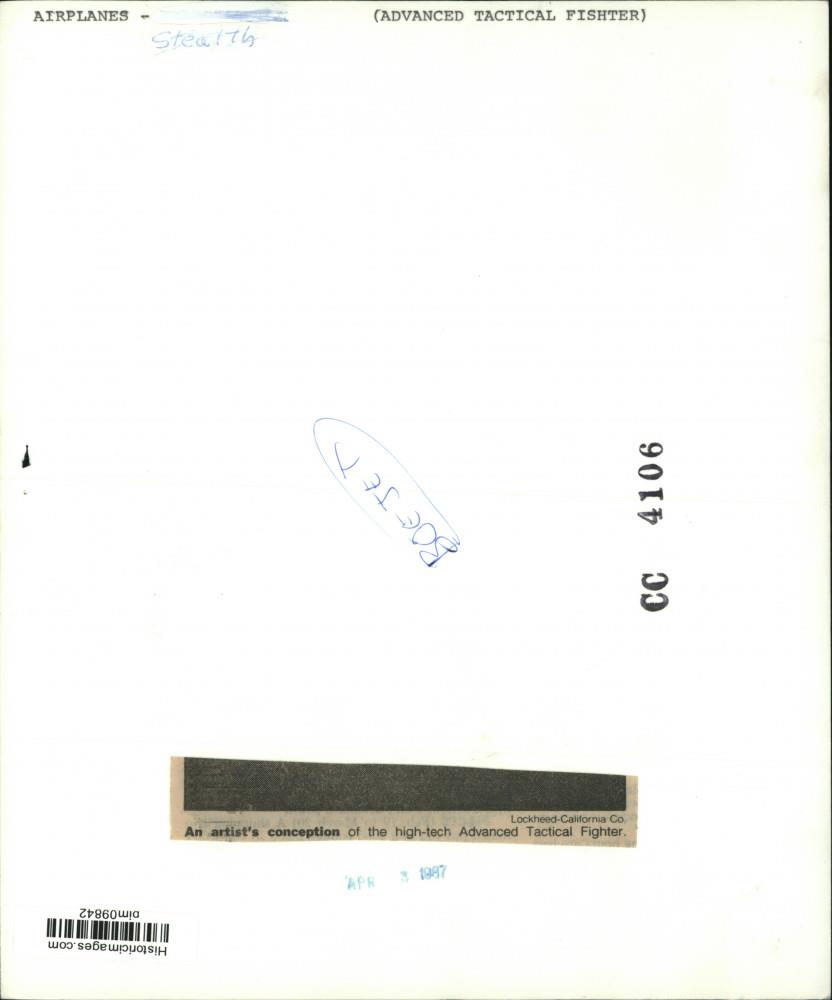
No comments:
Post a Comment